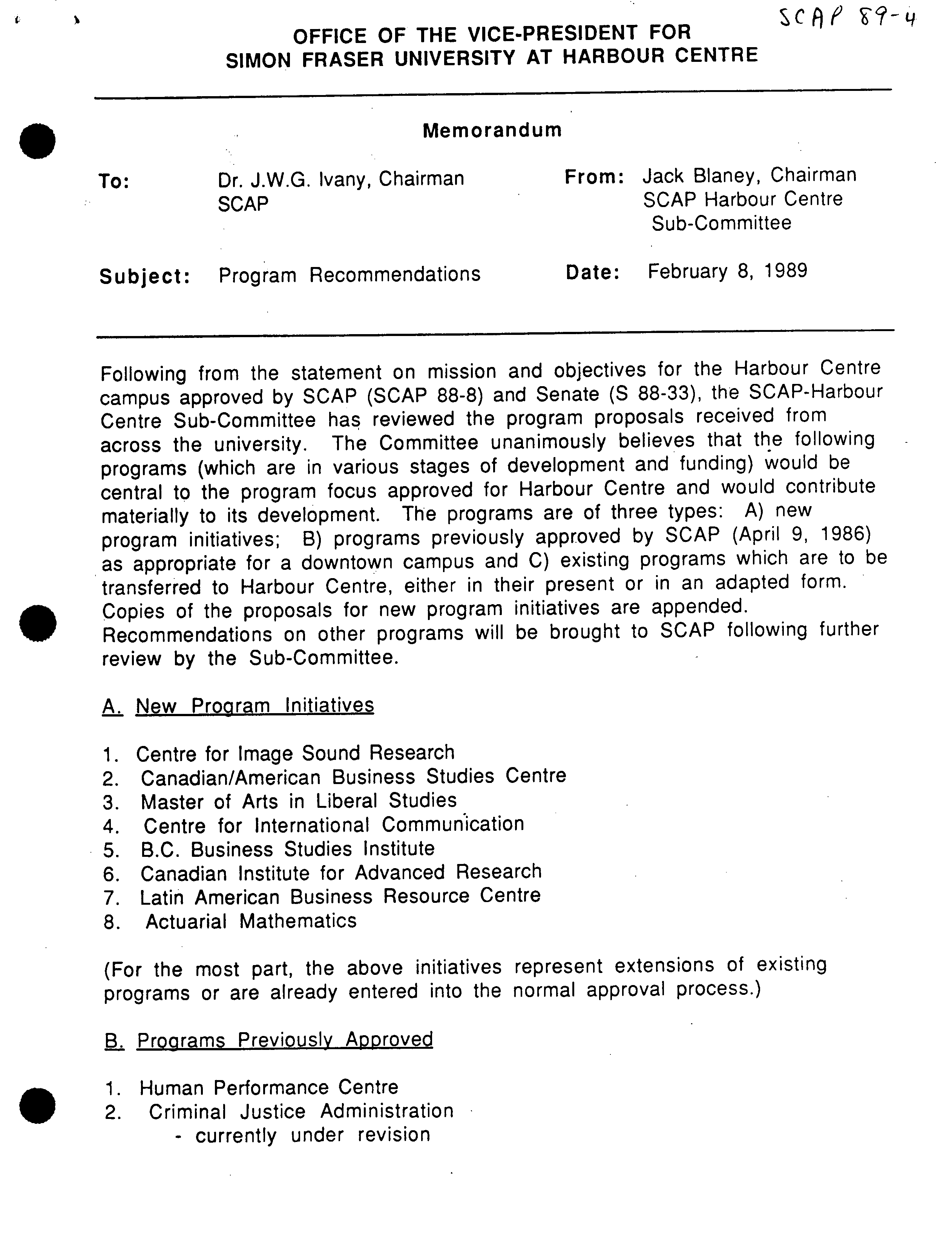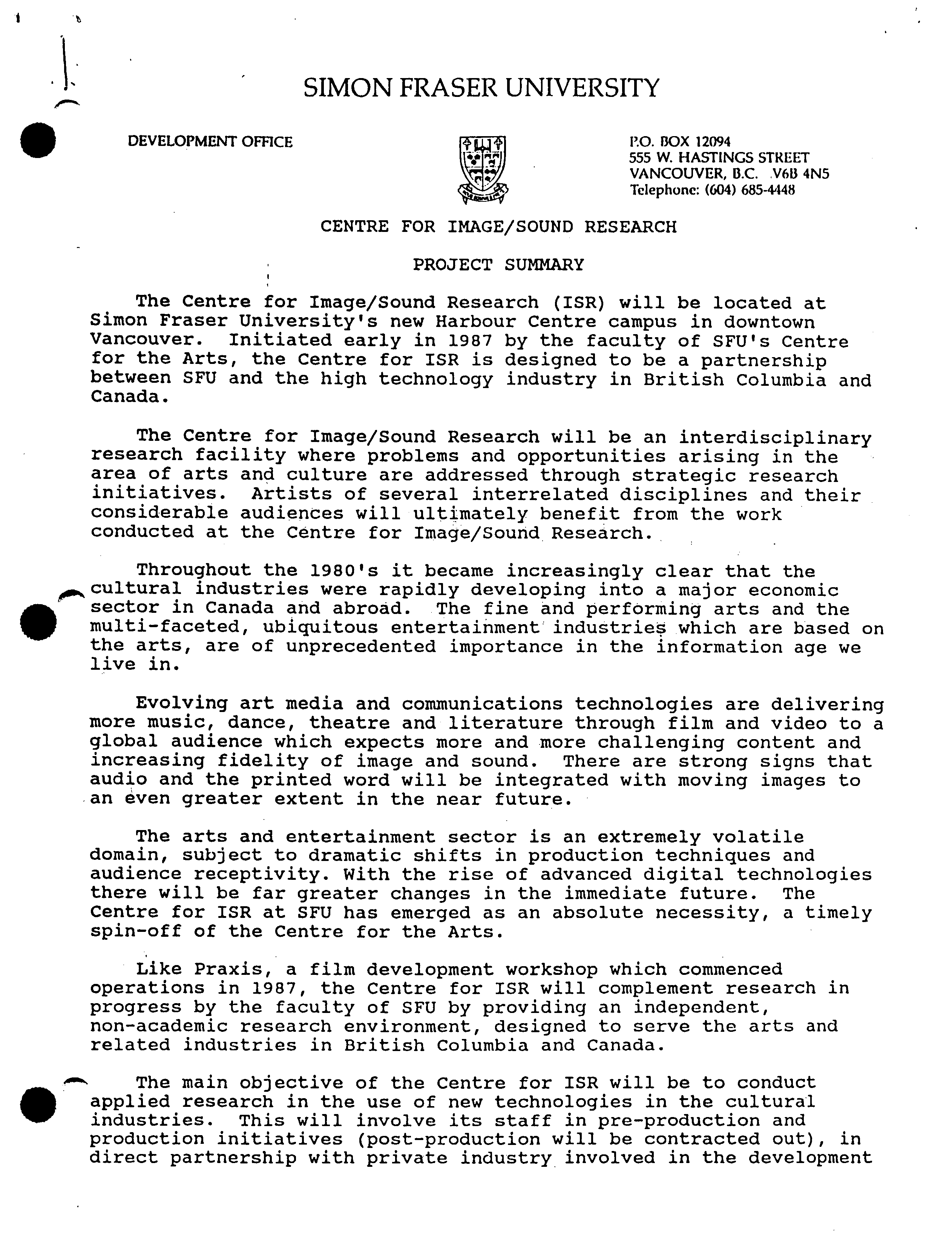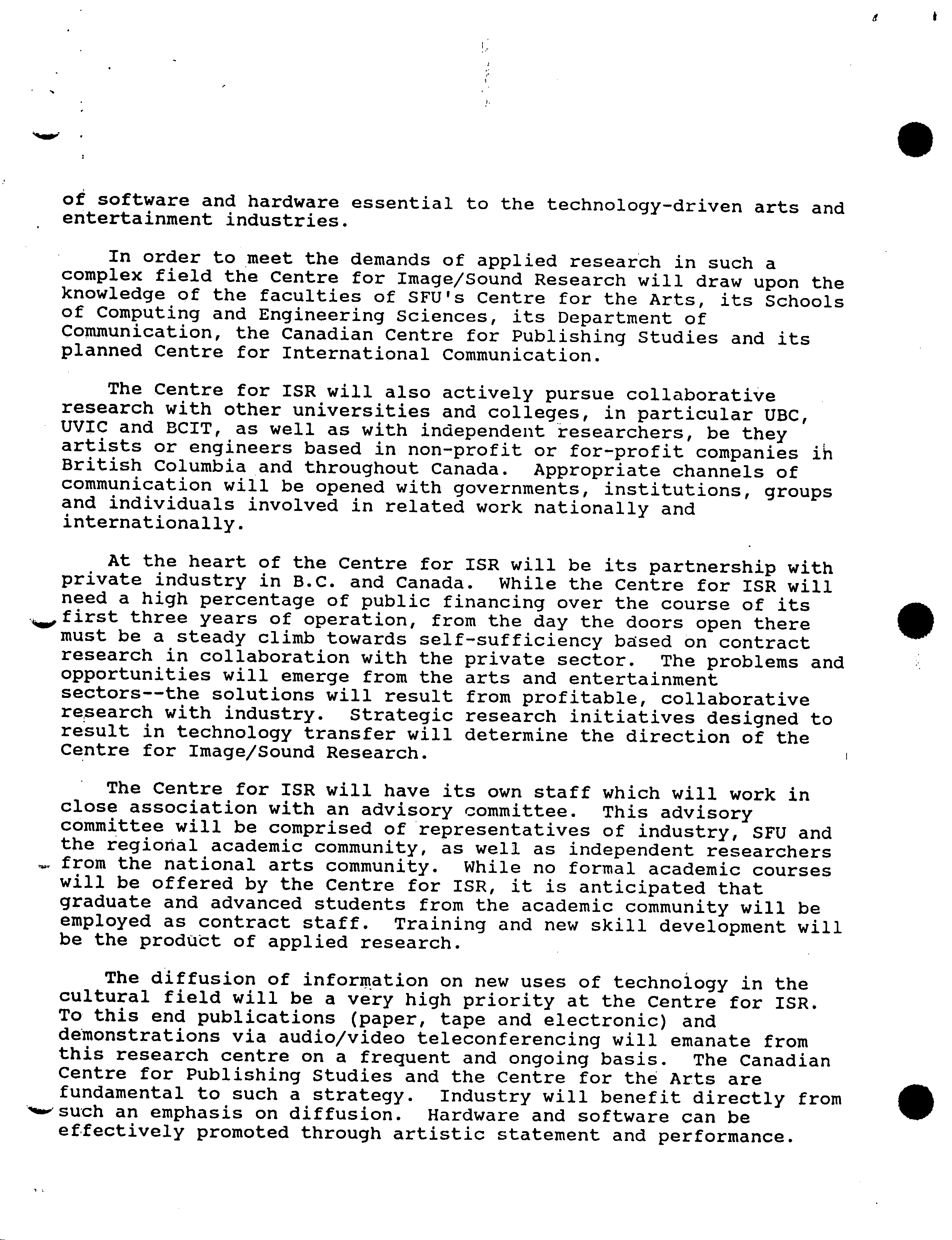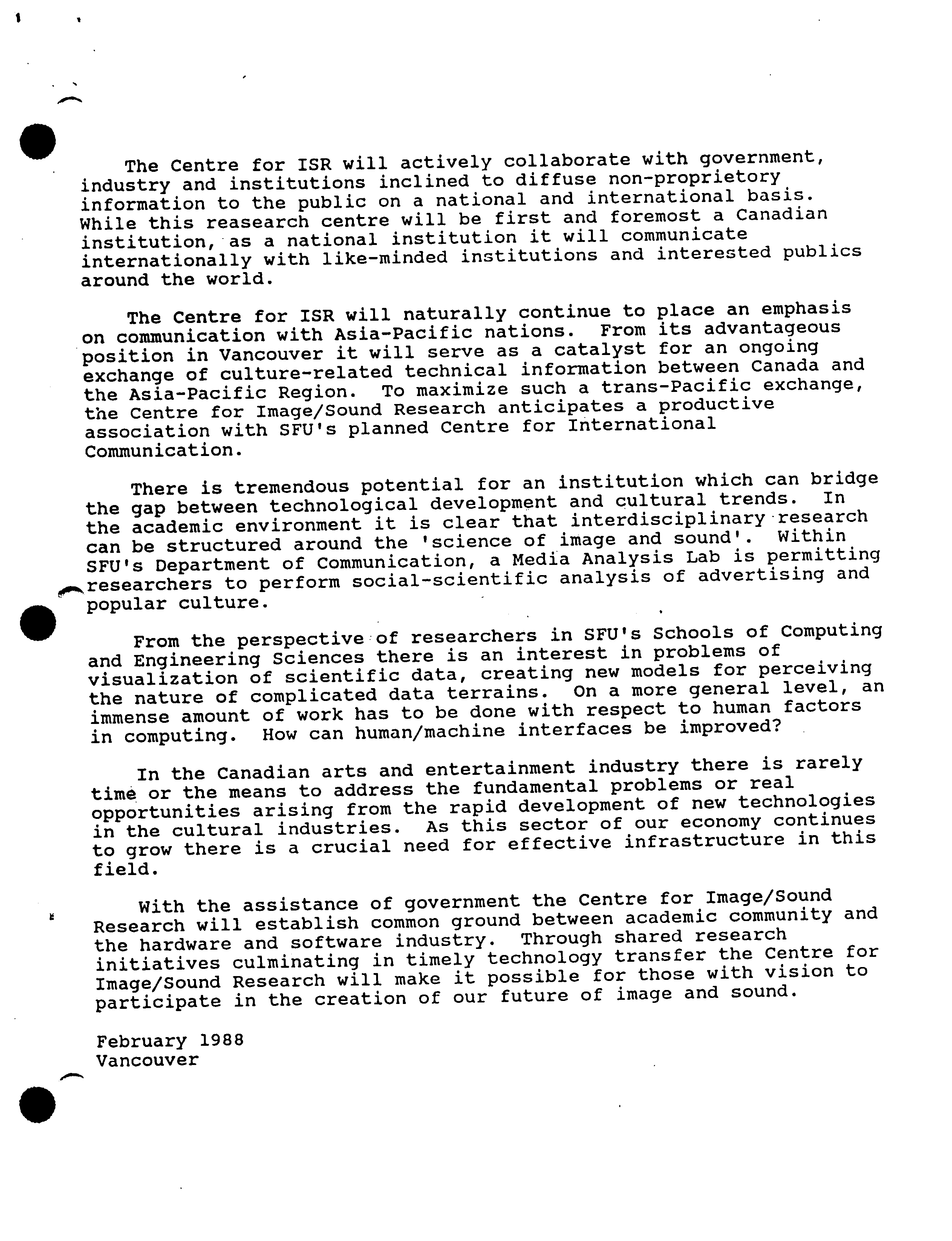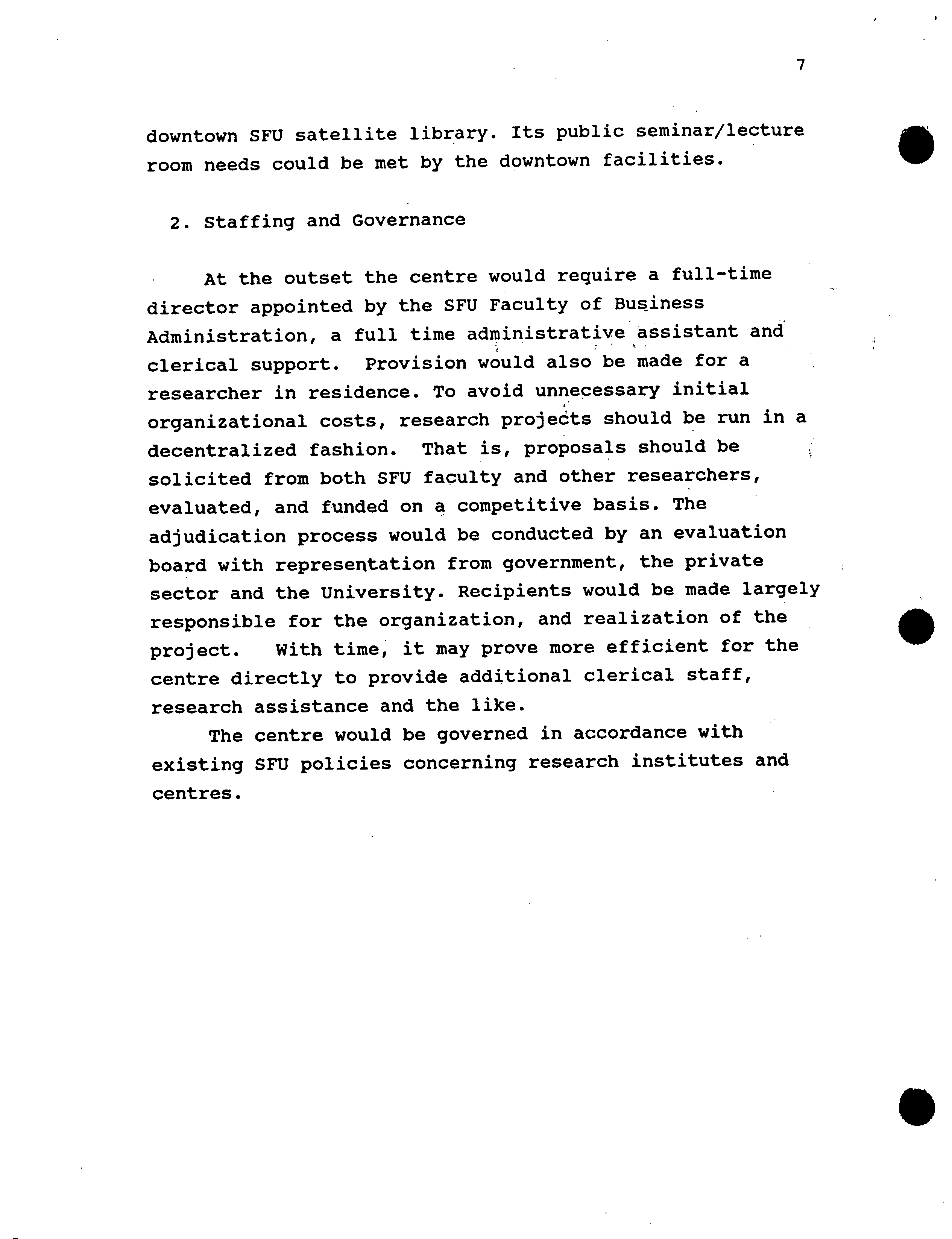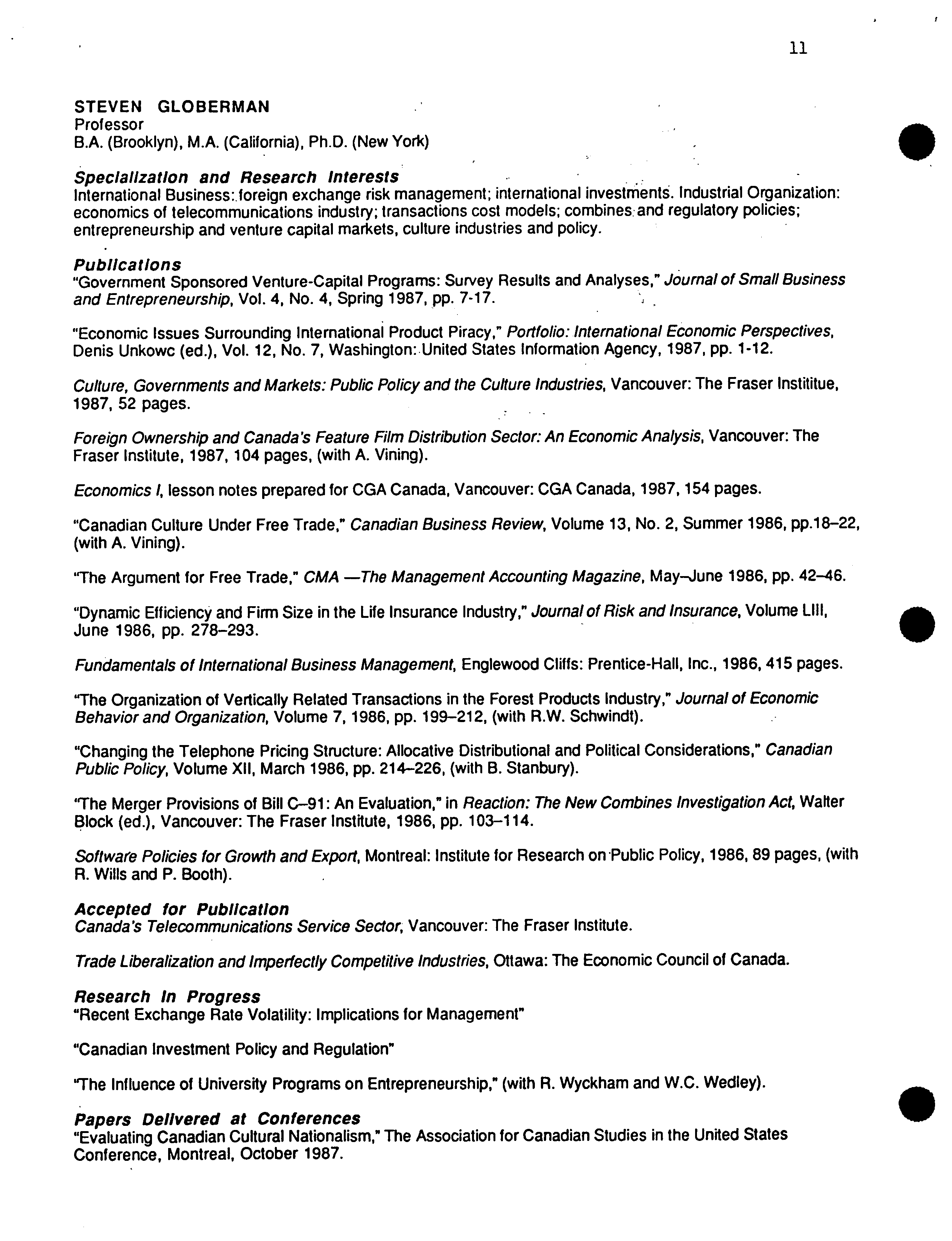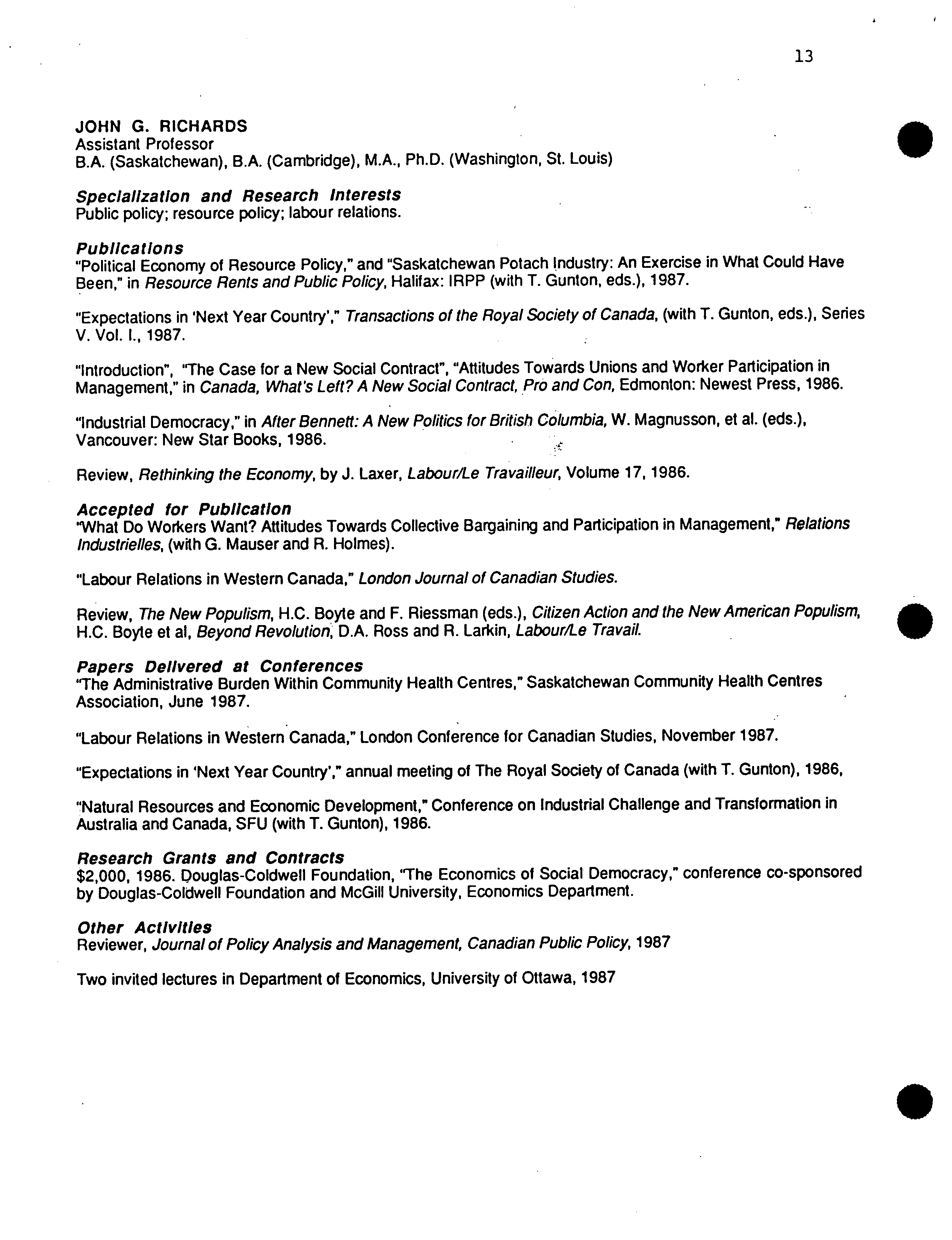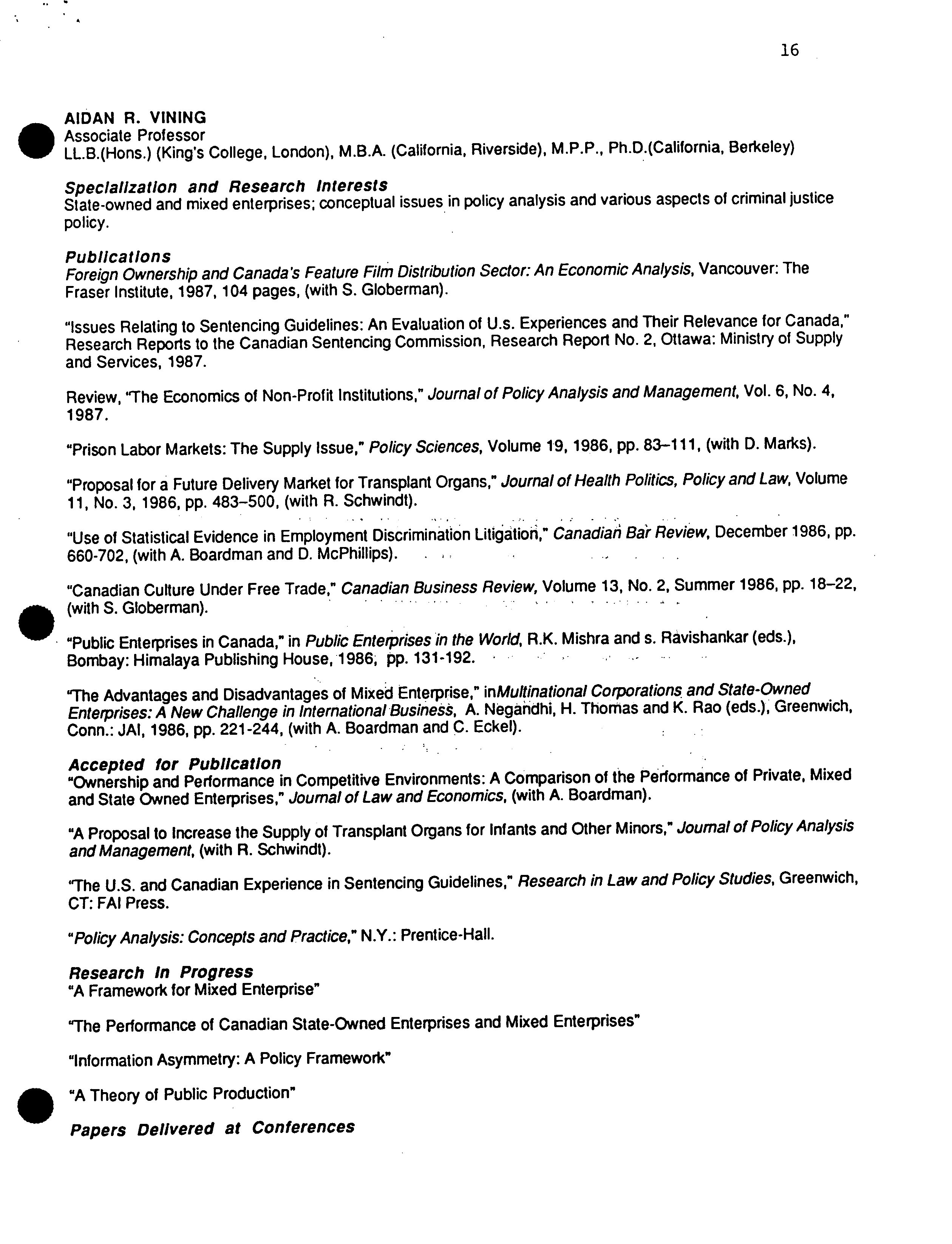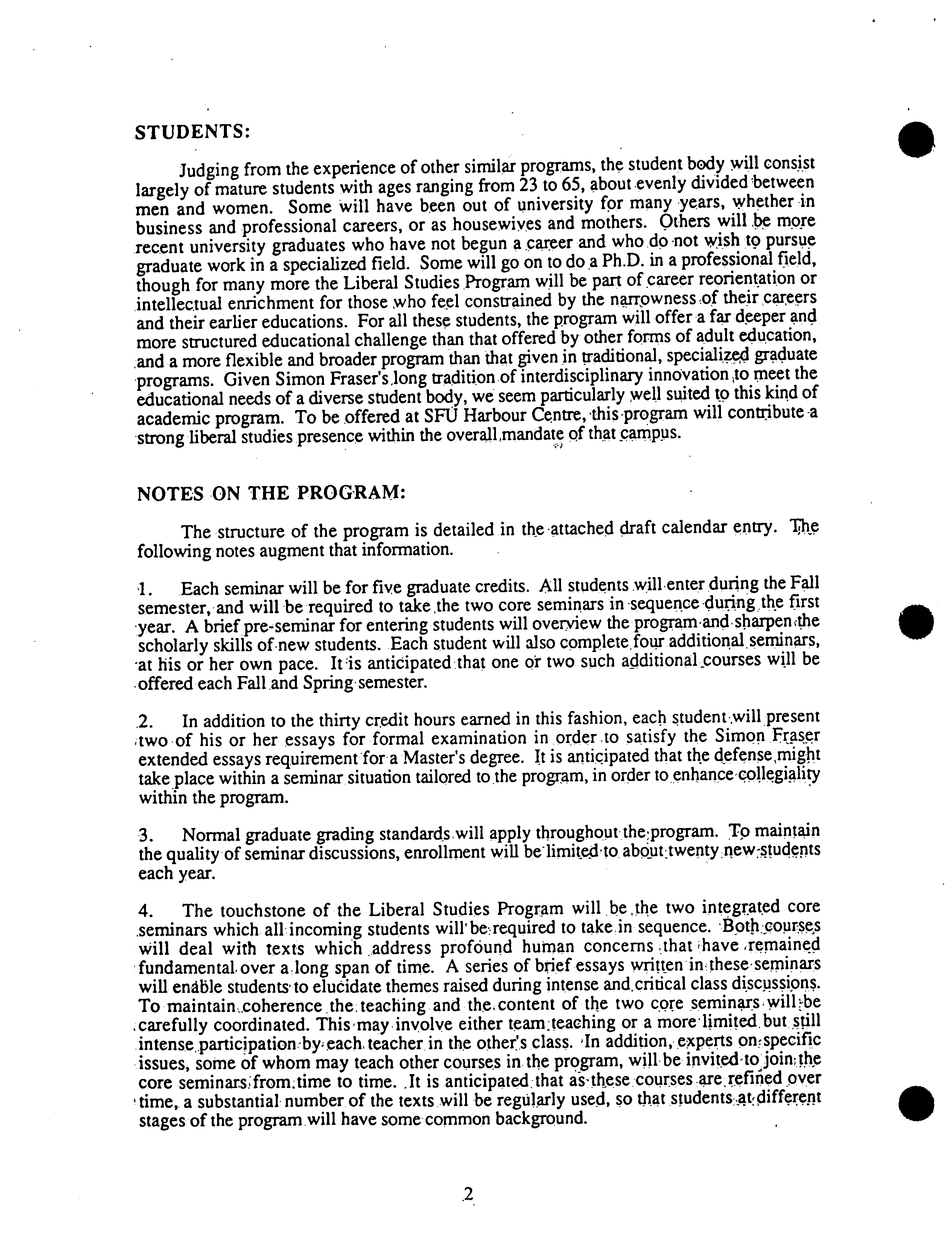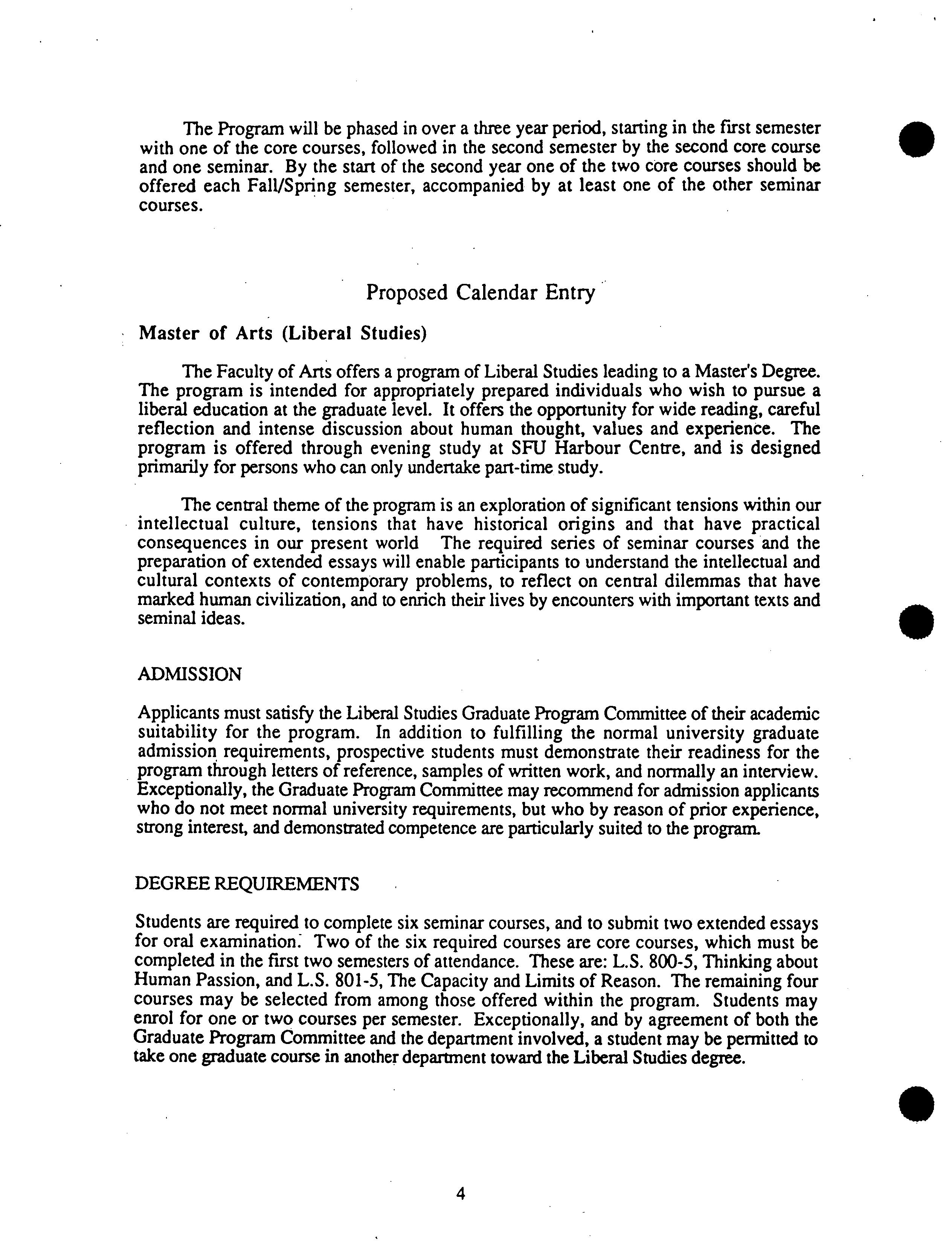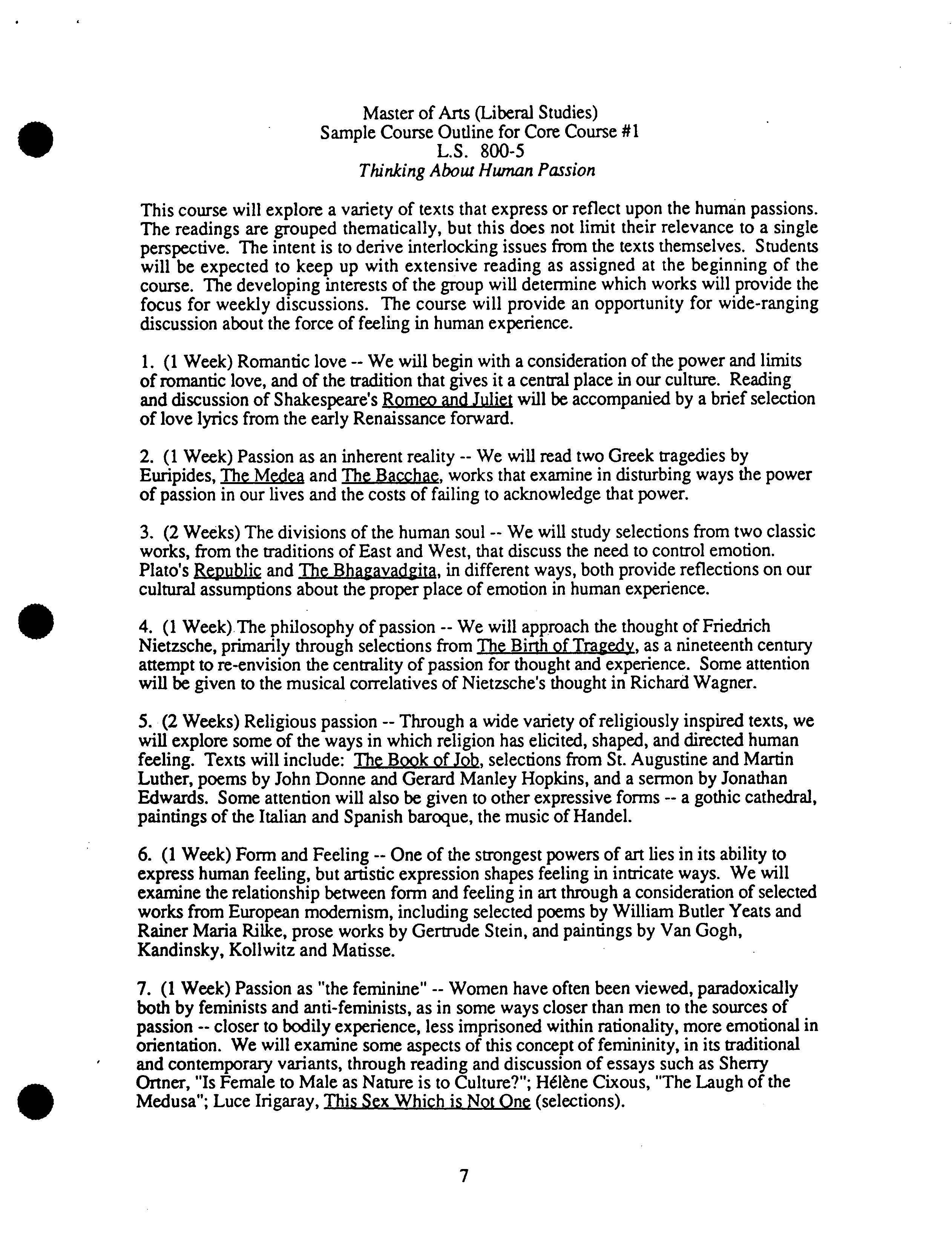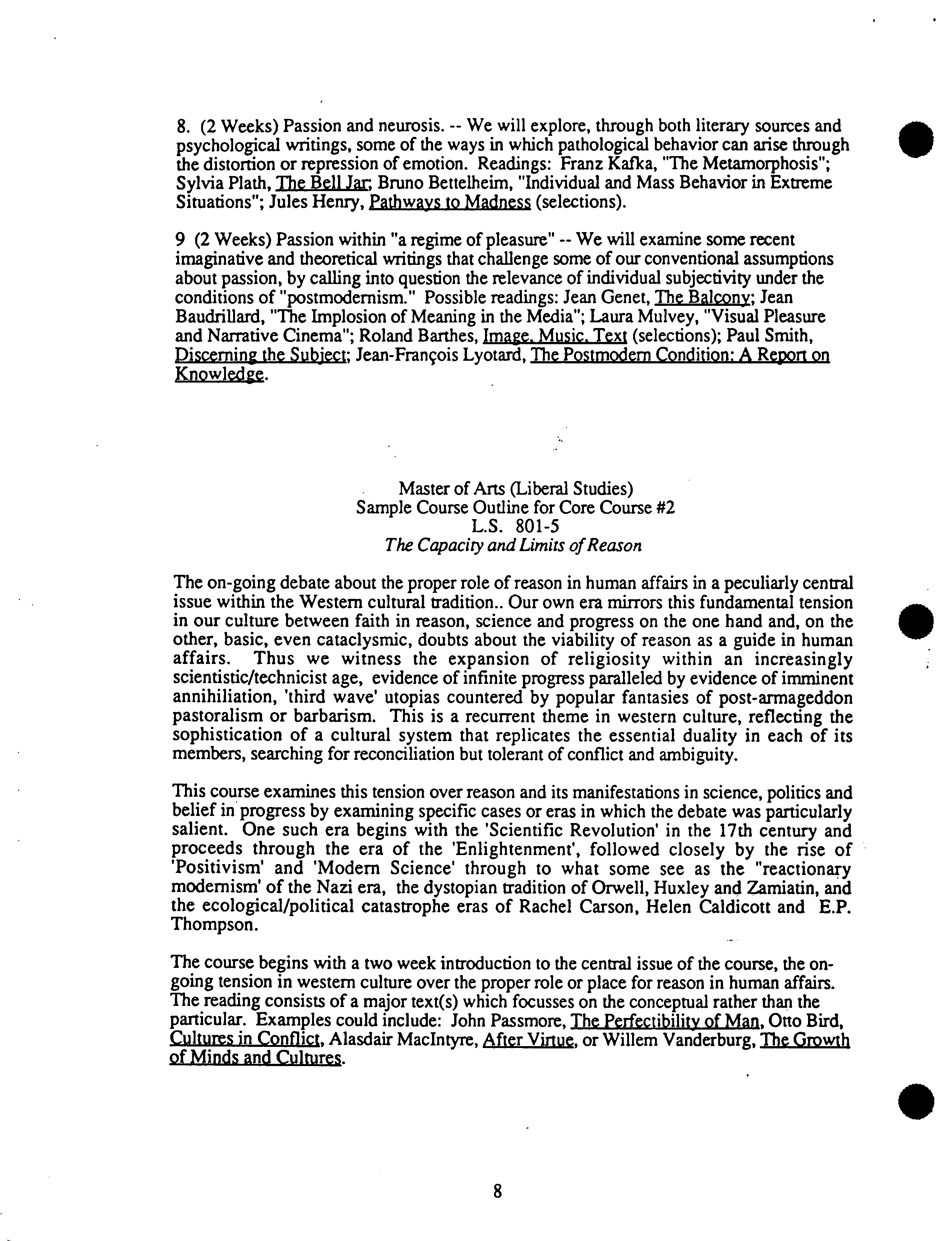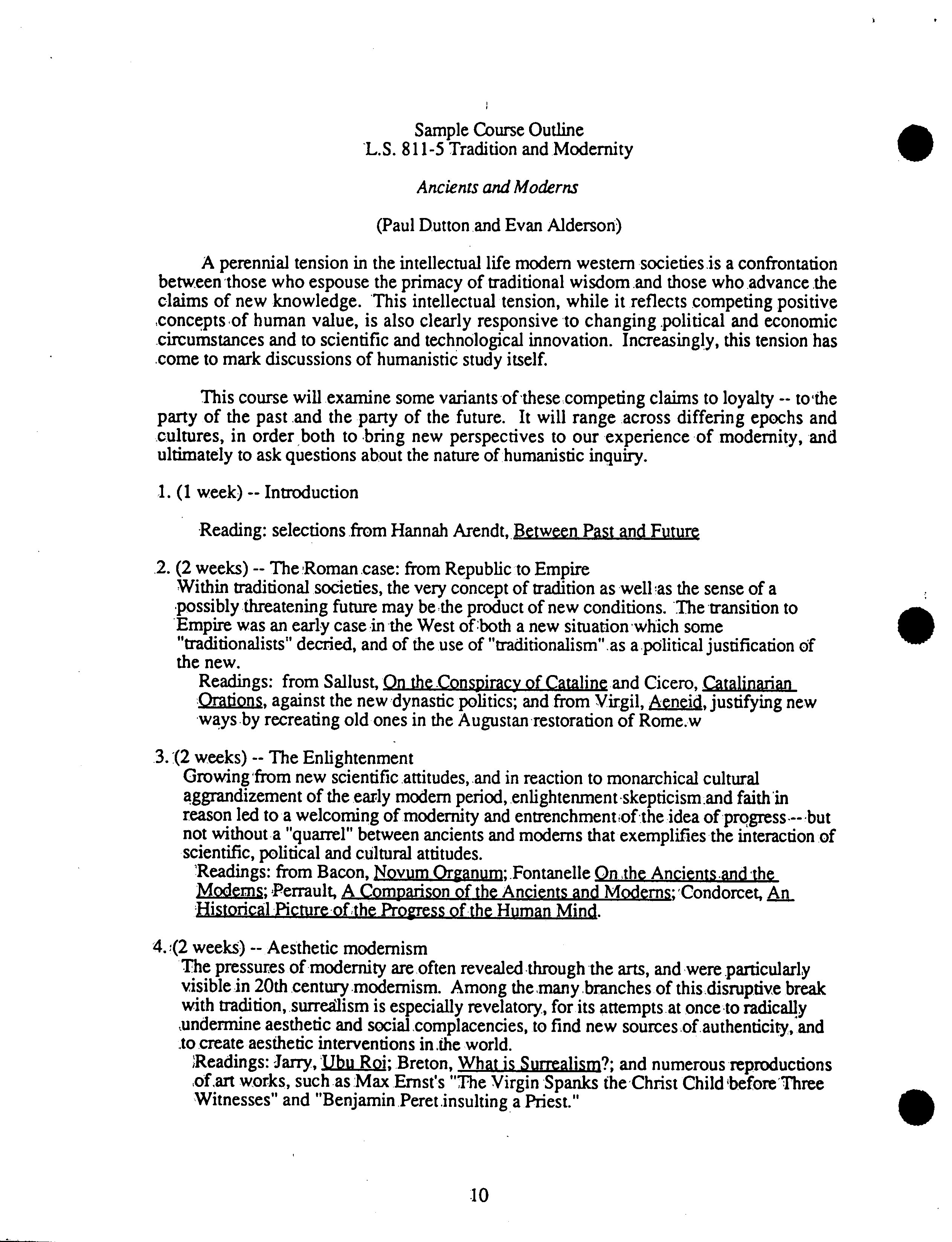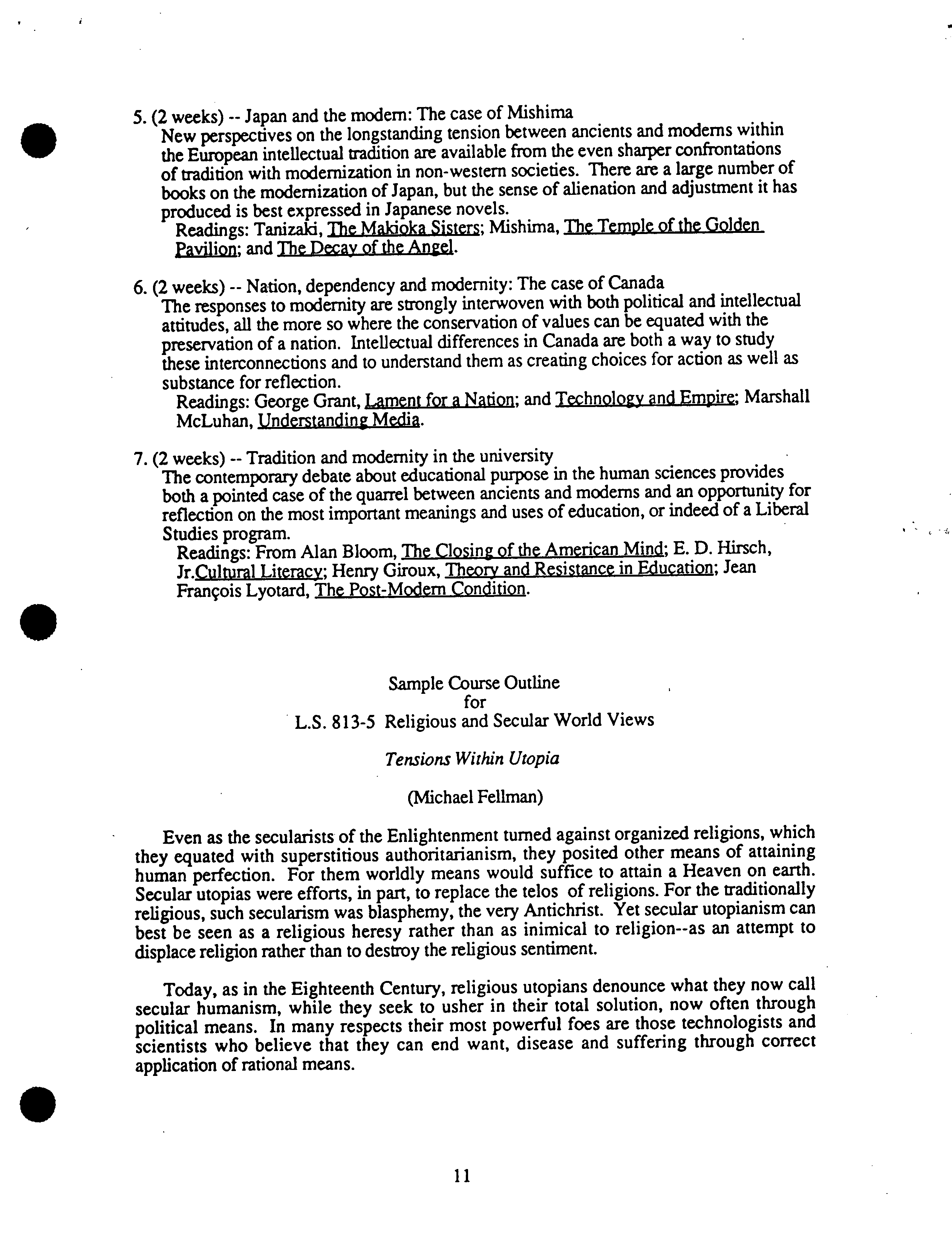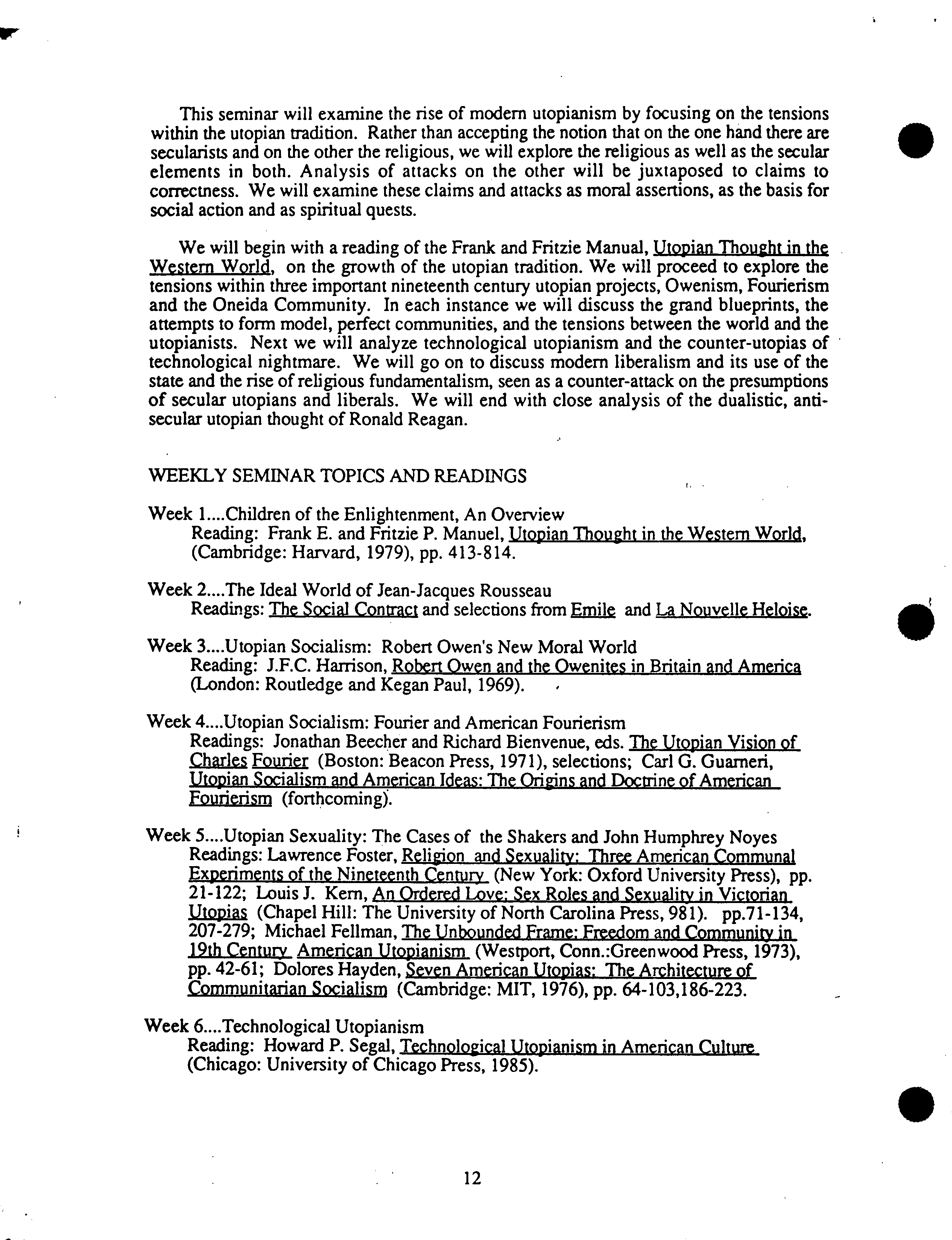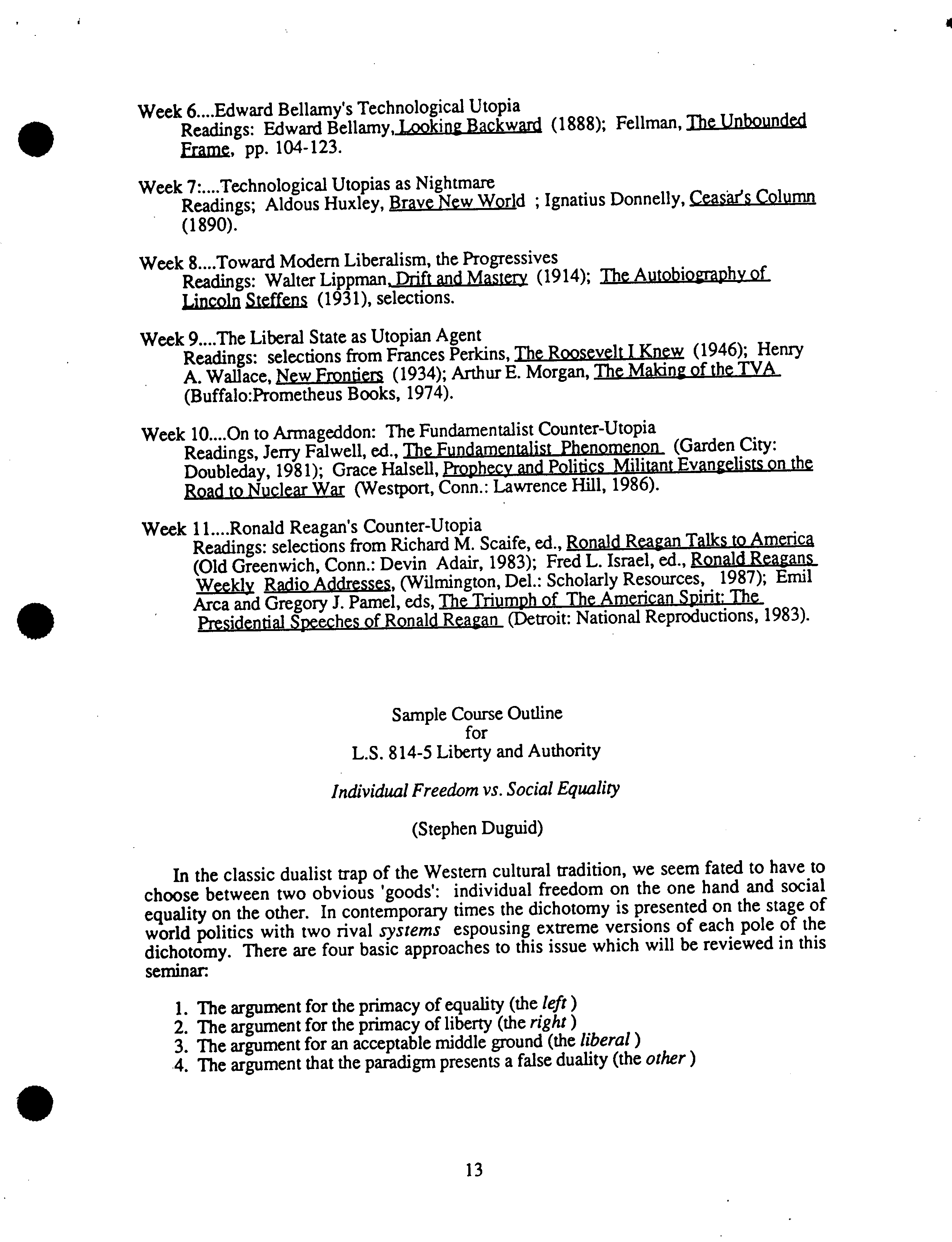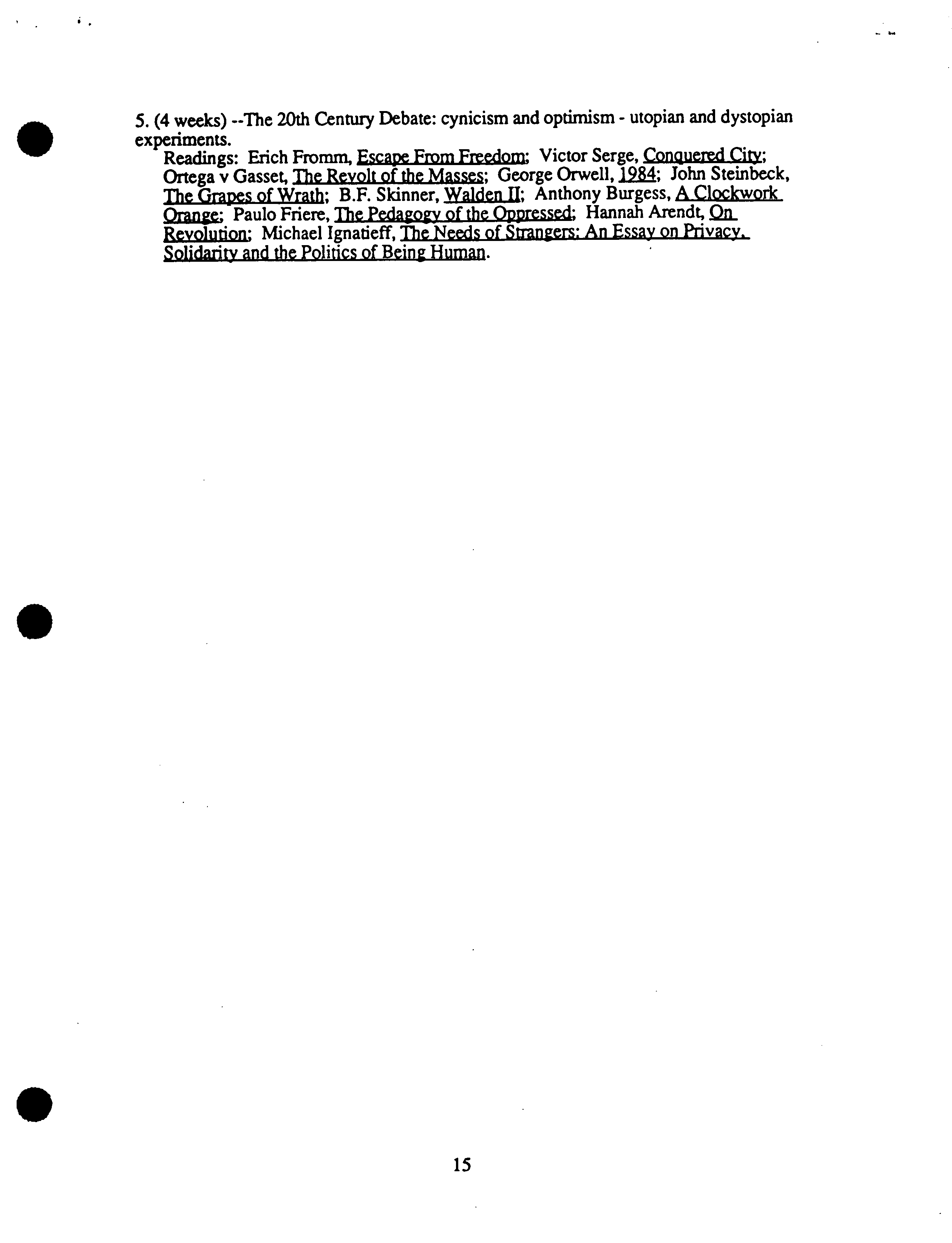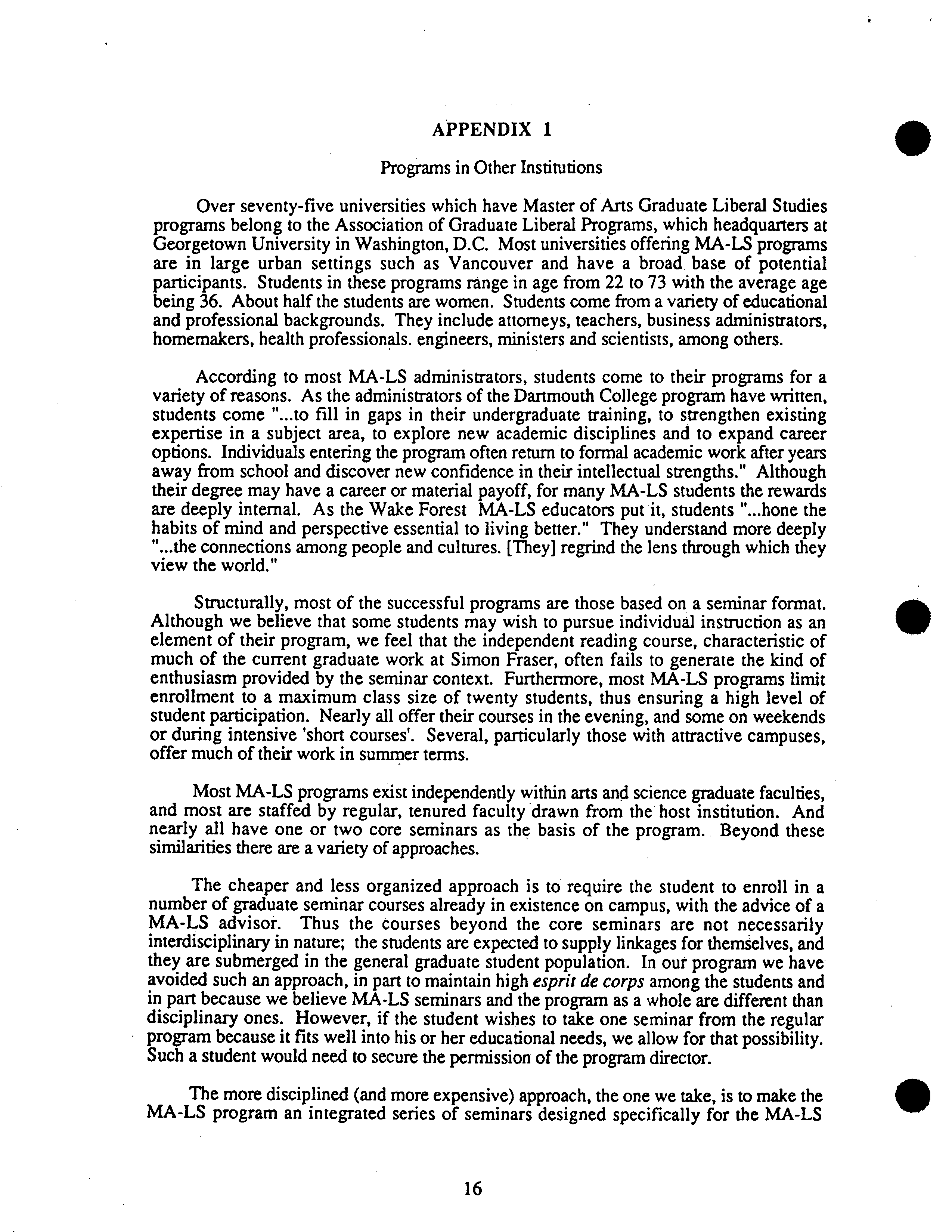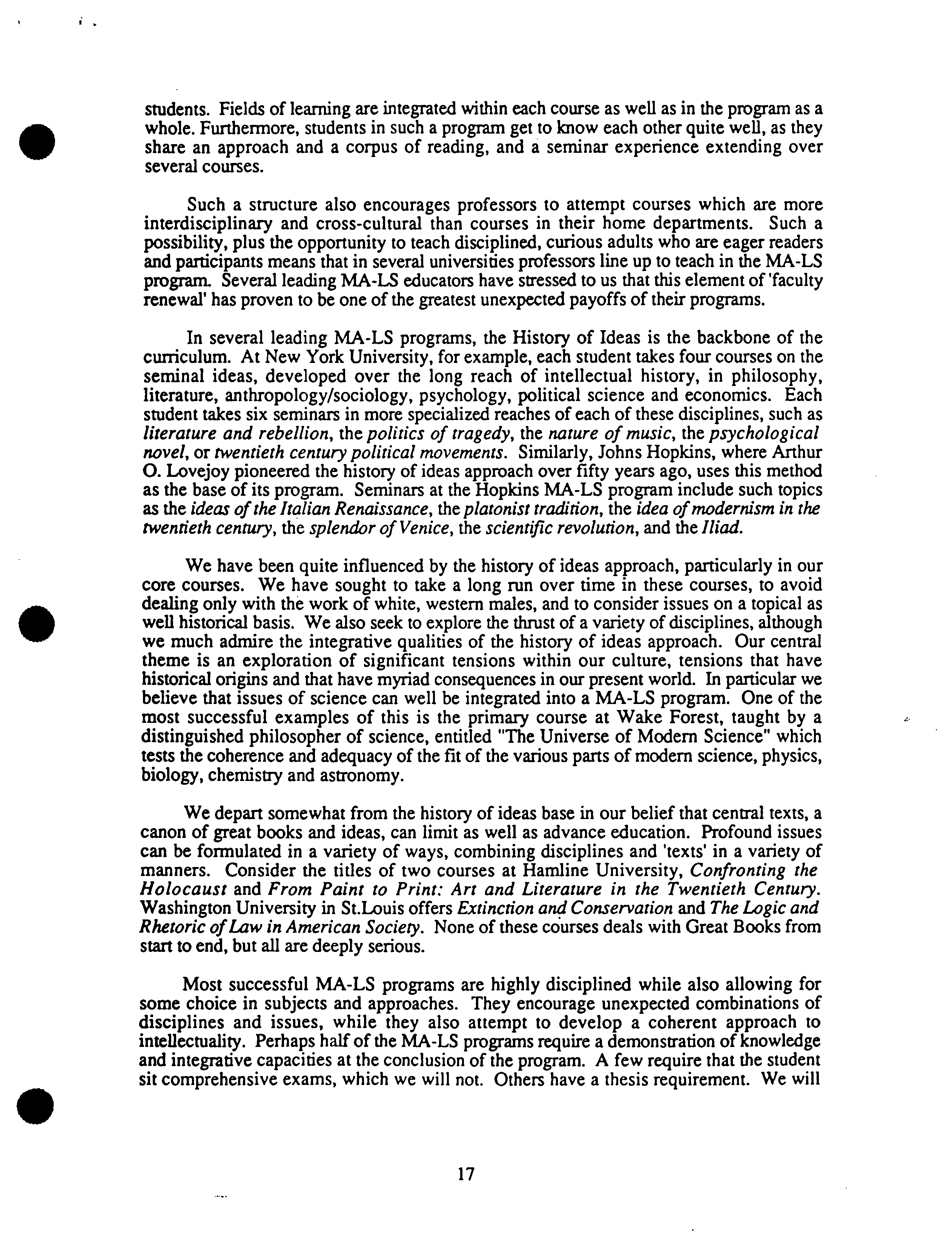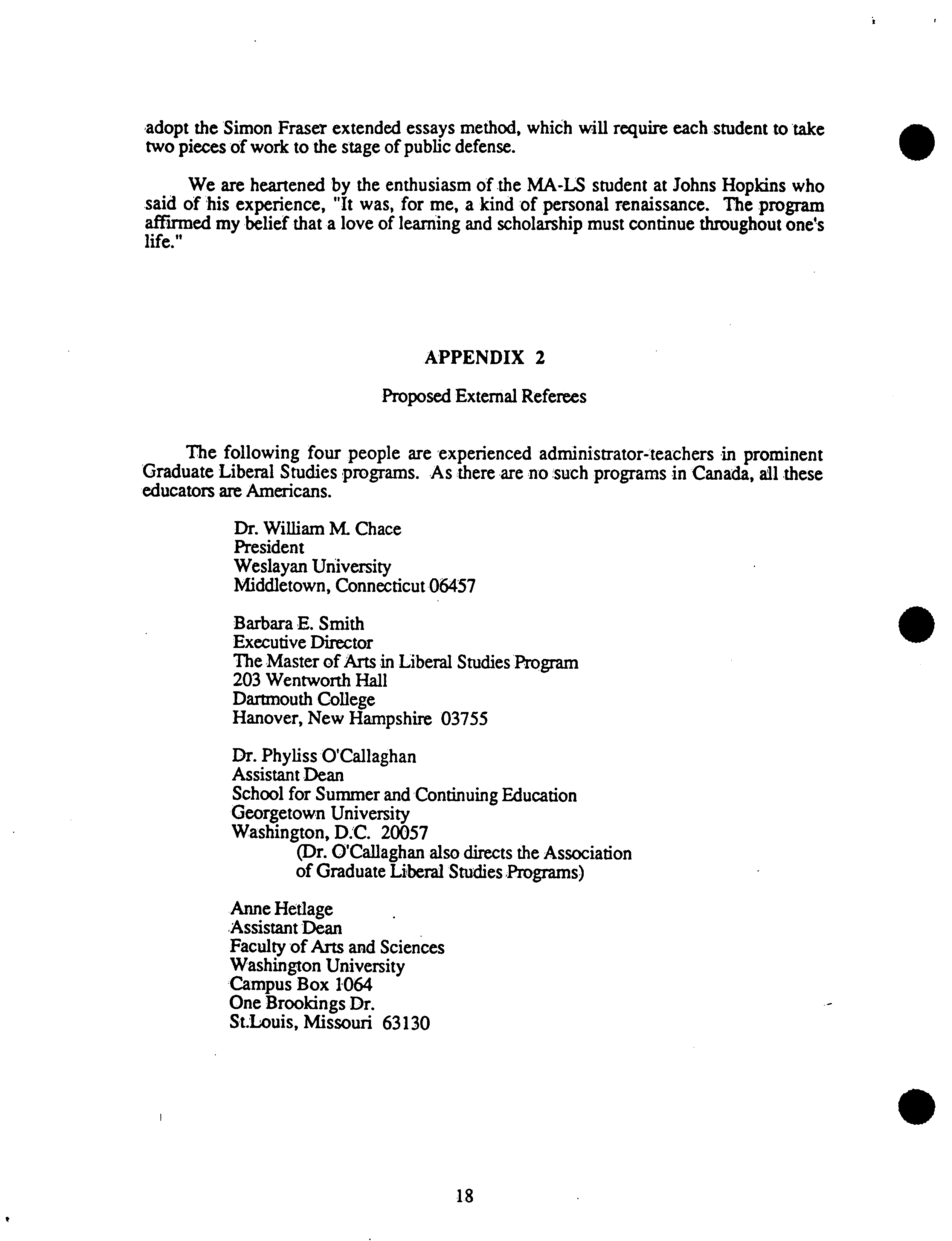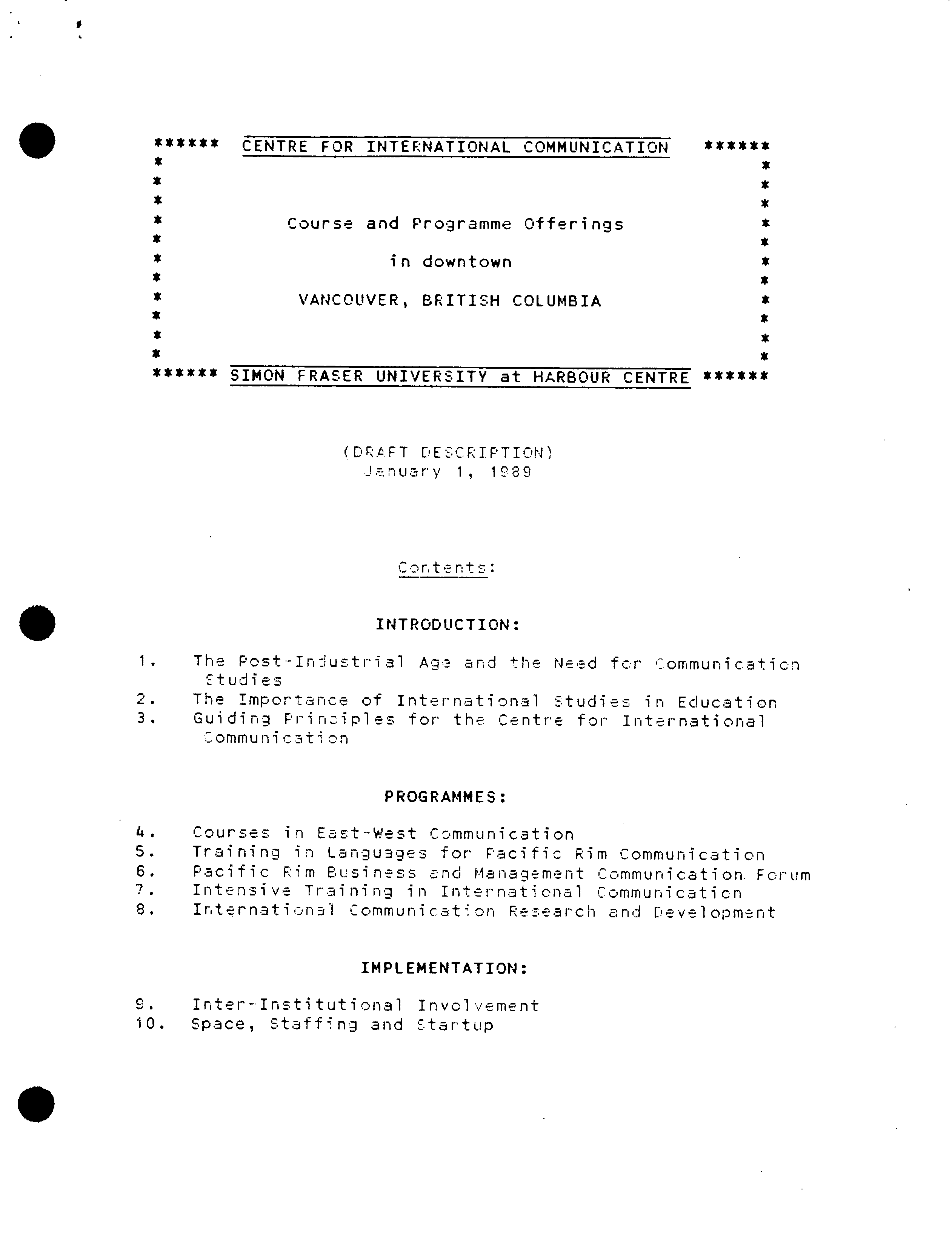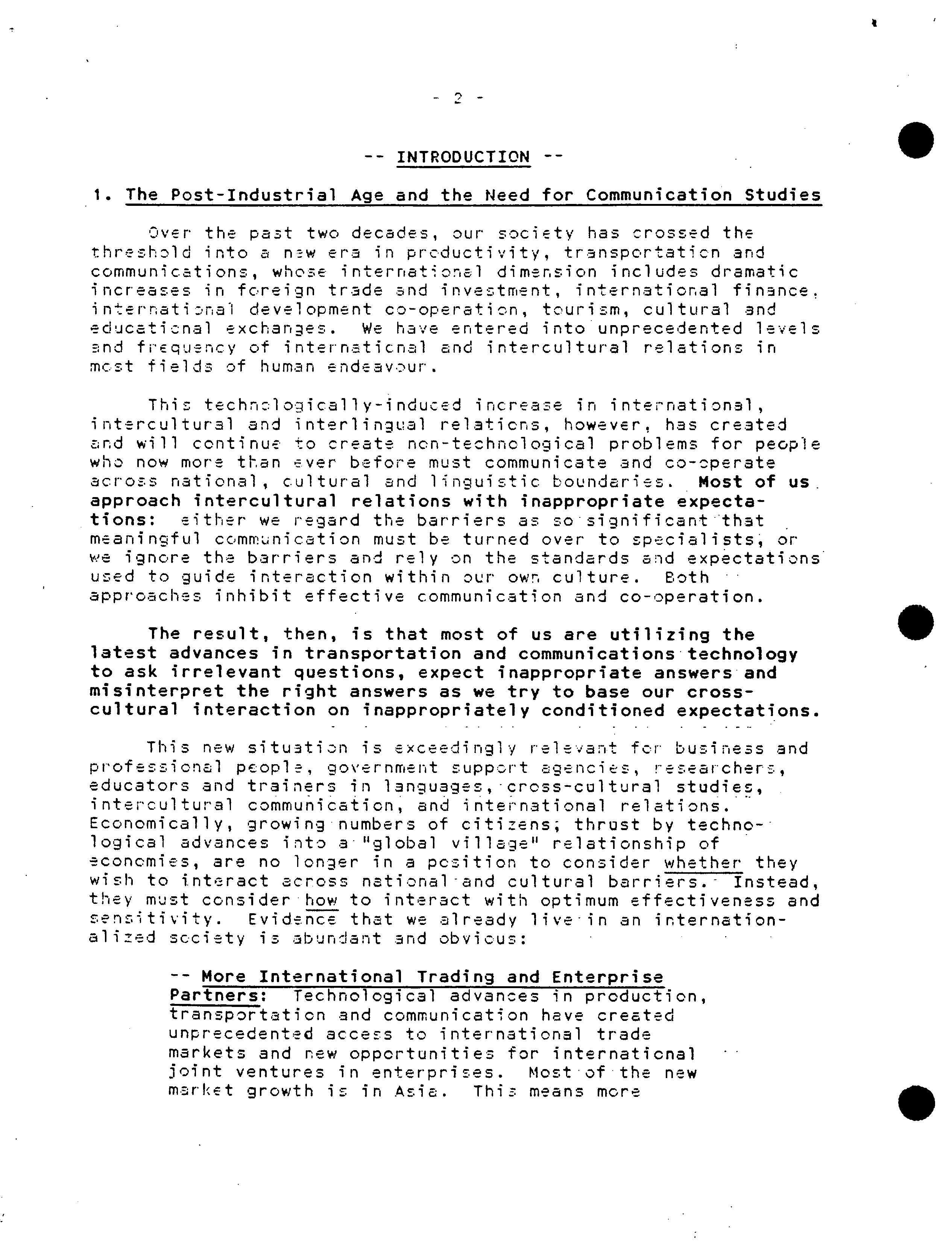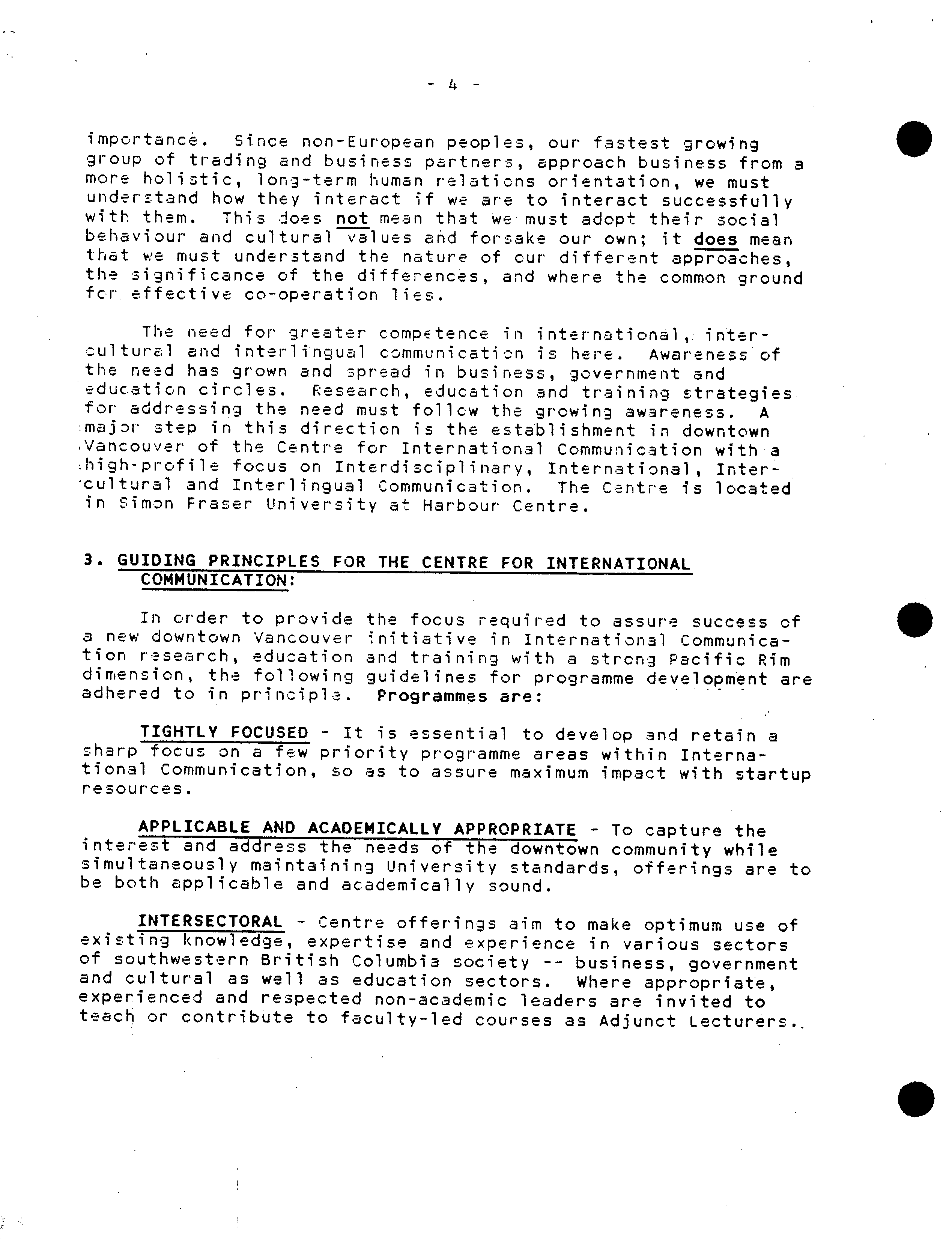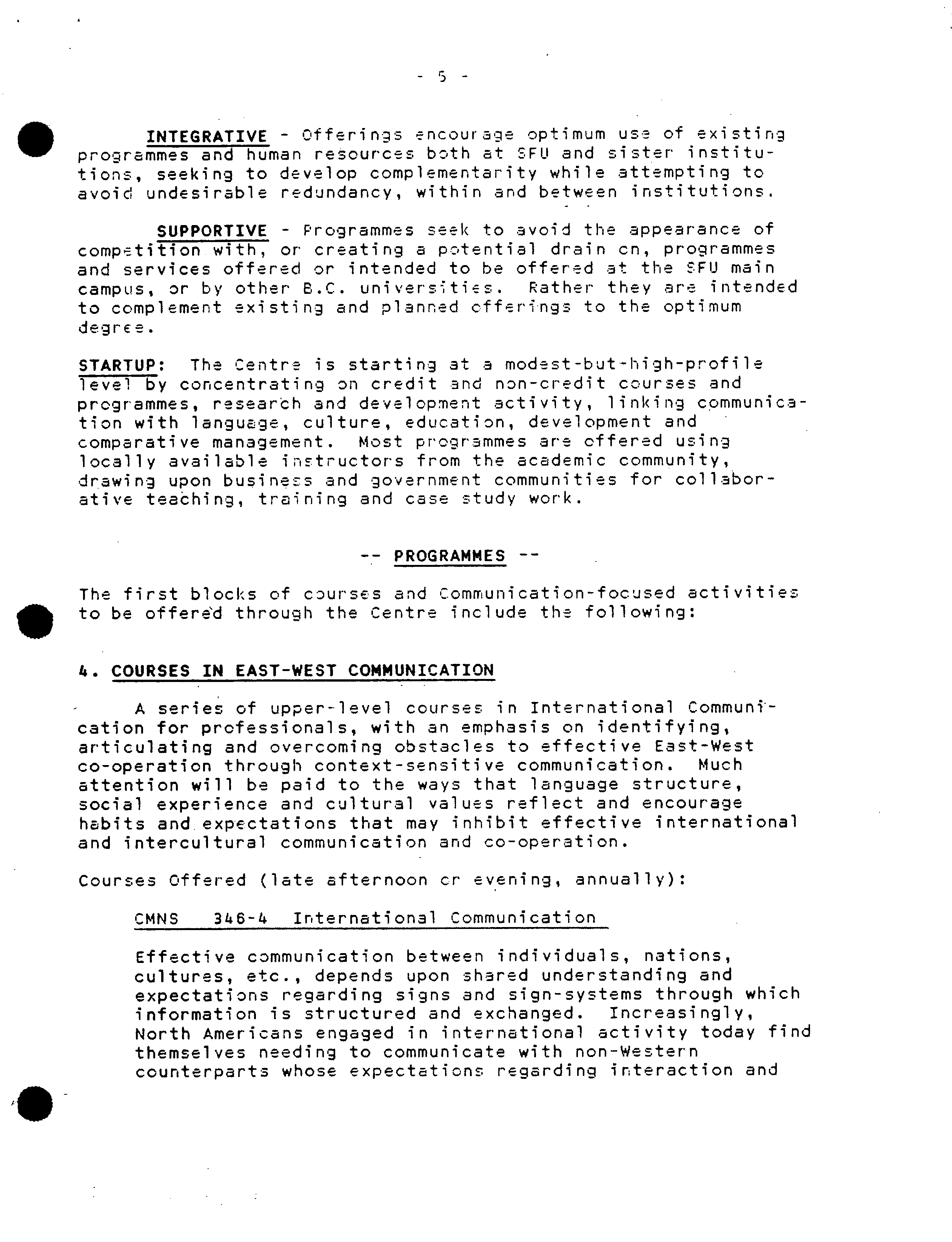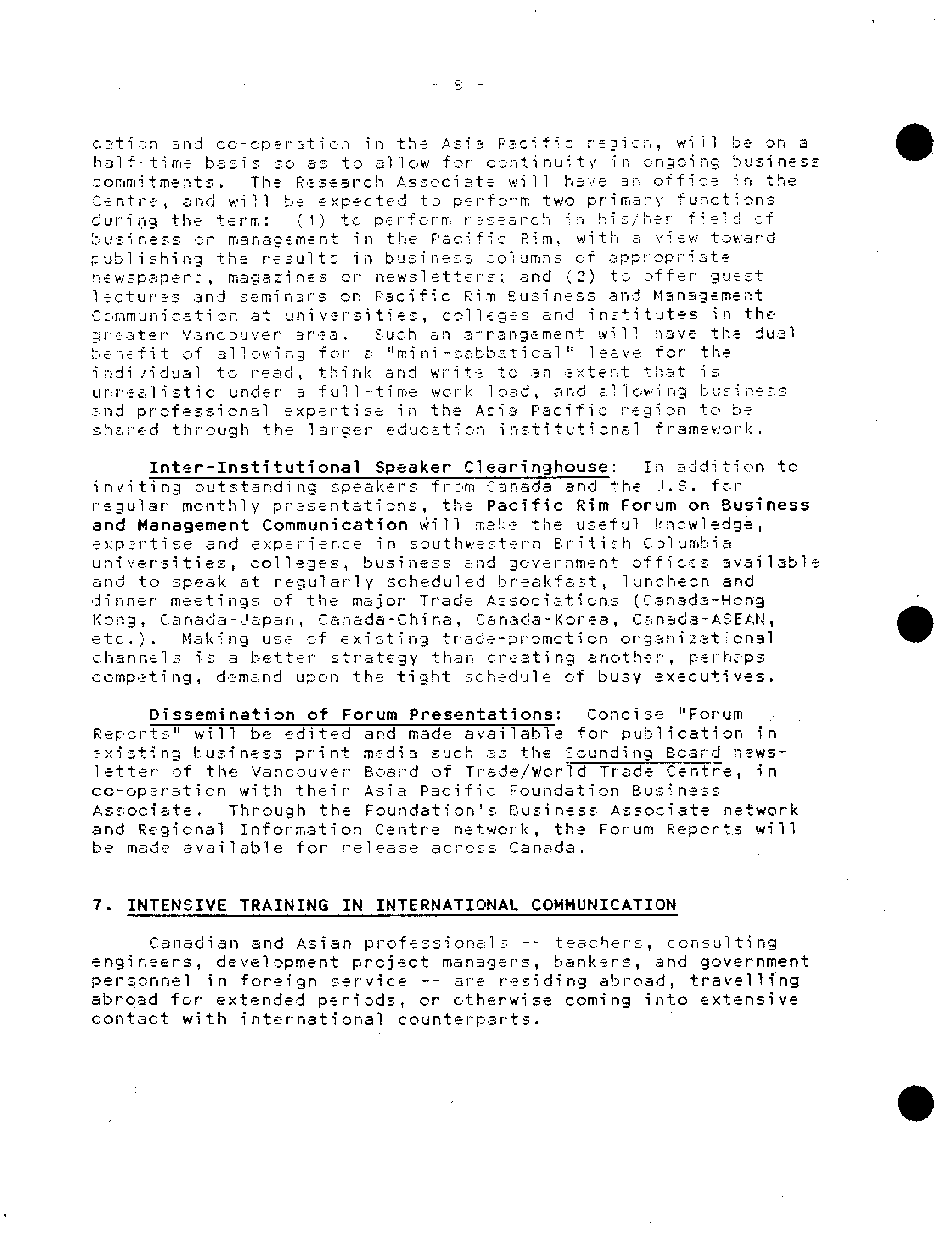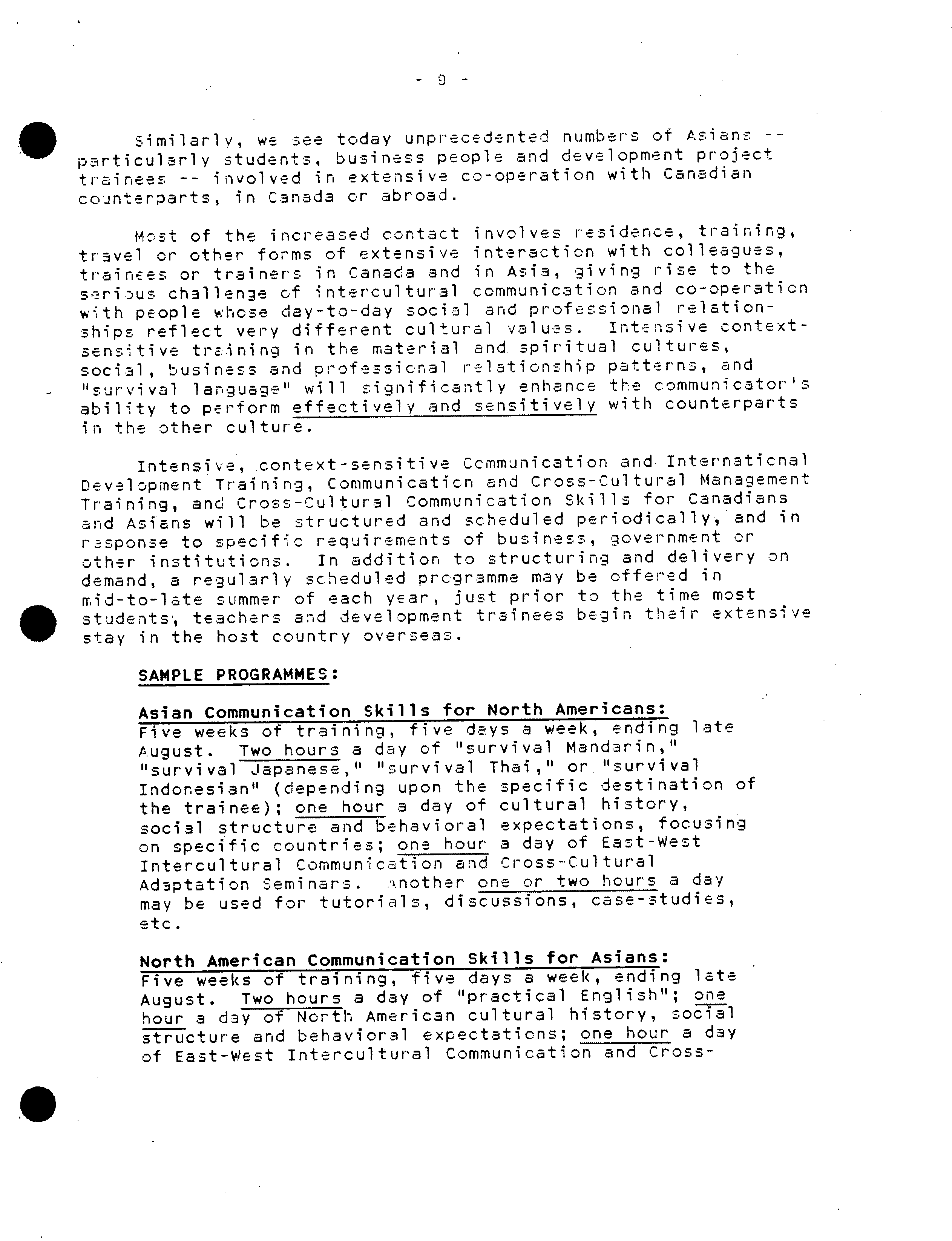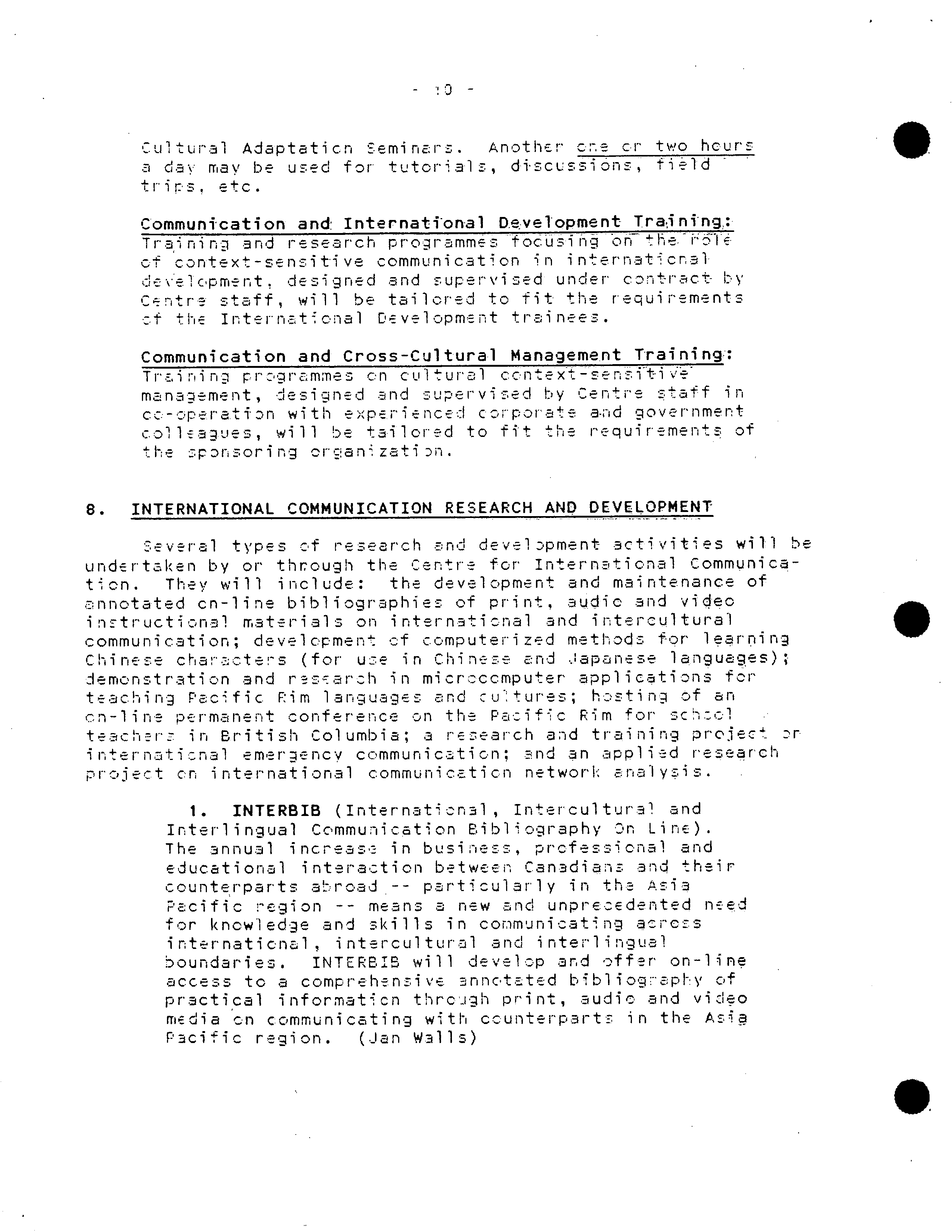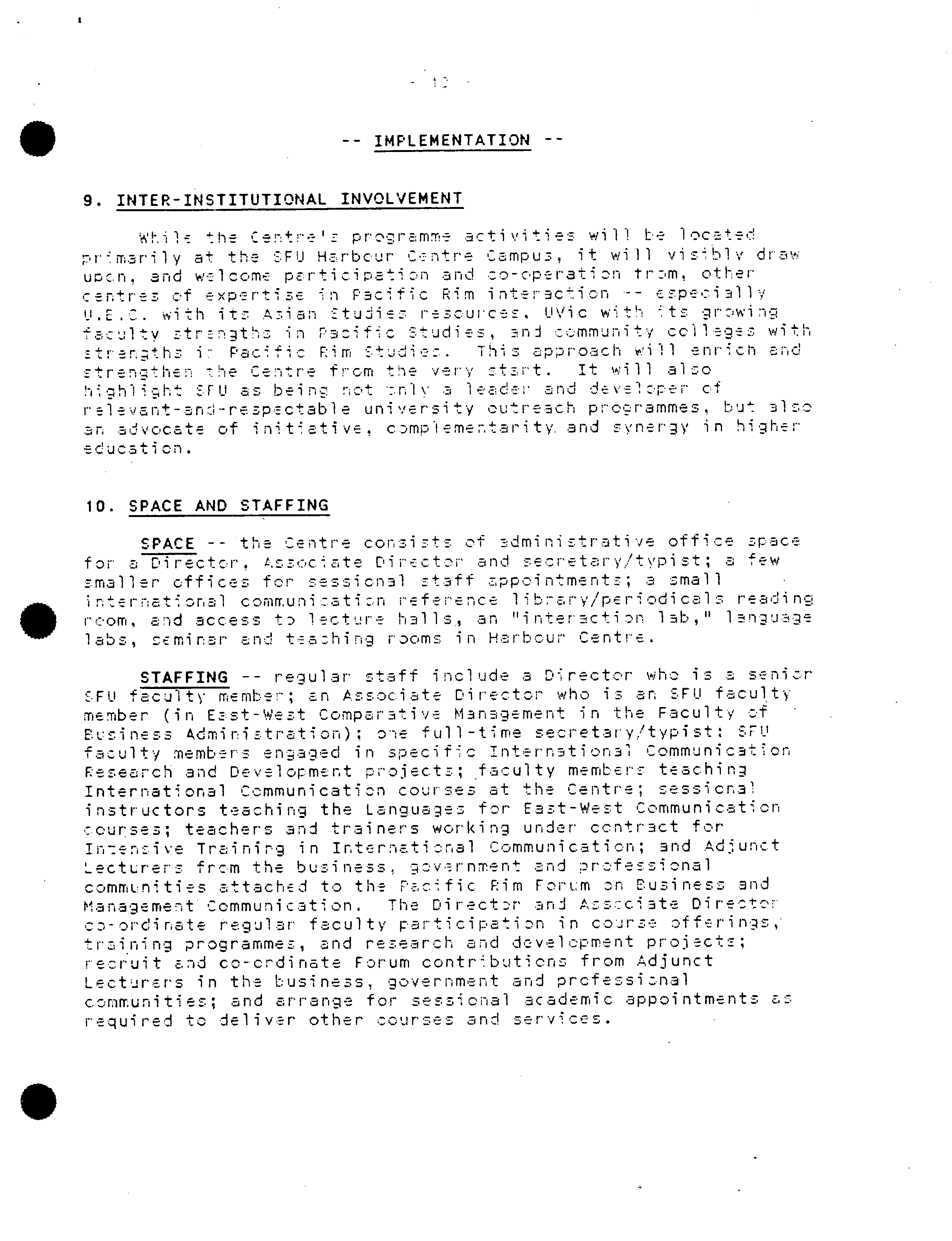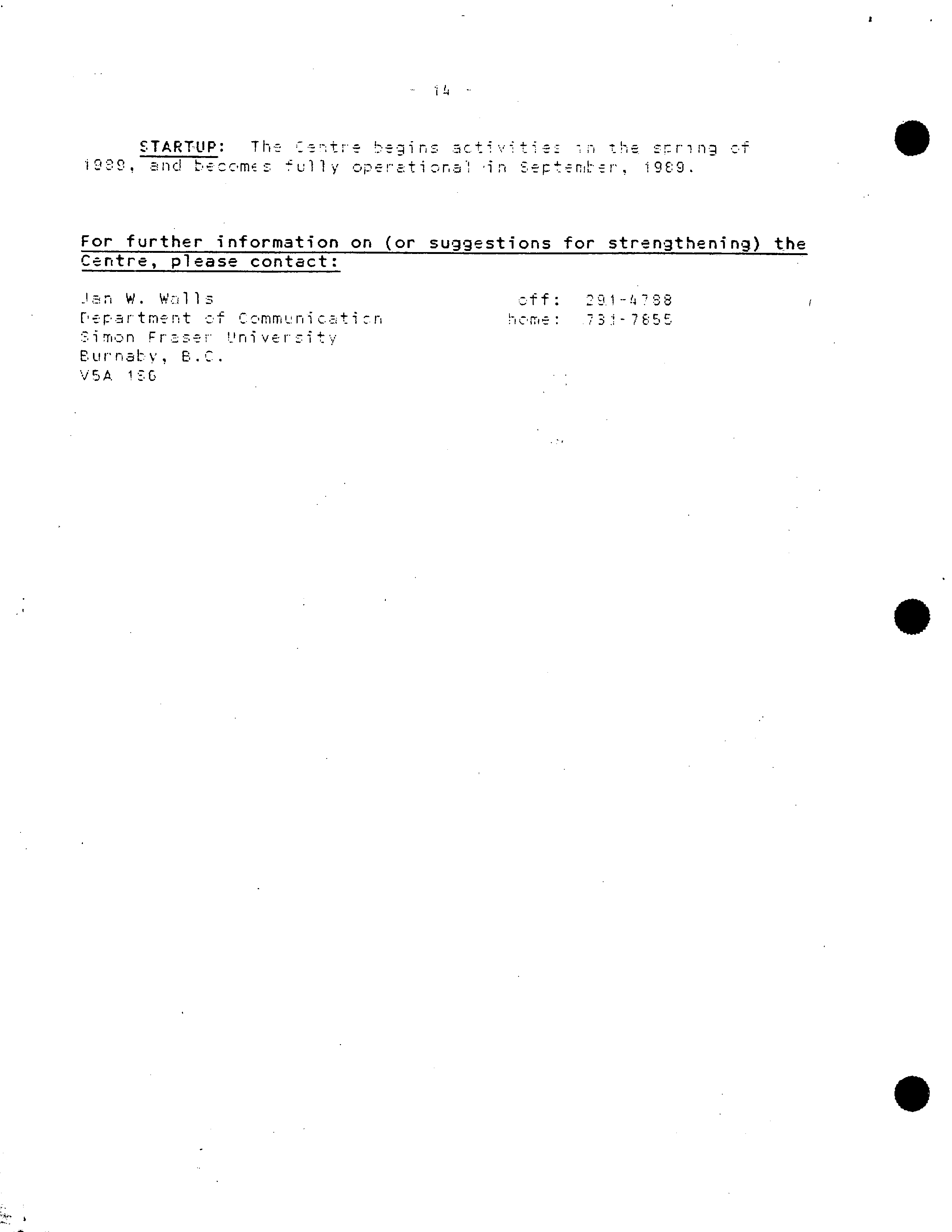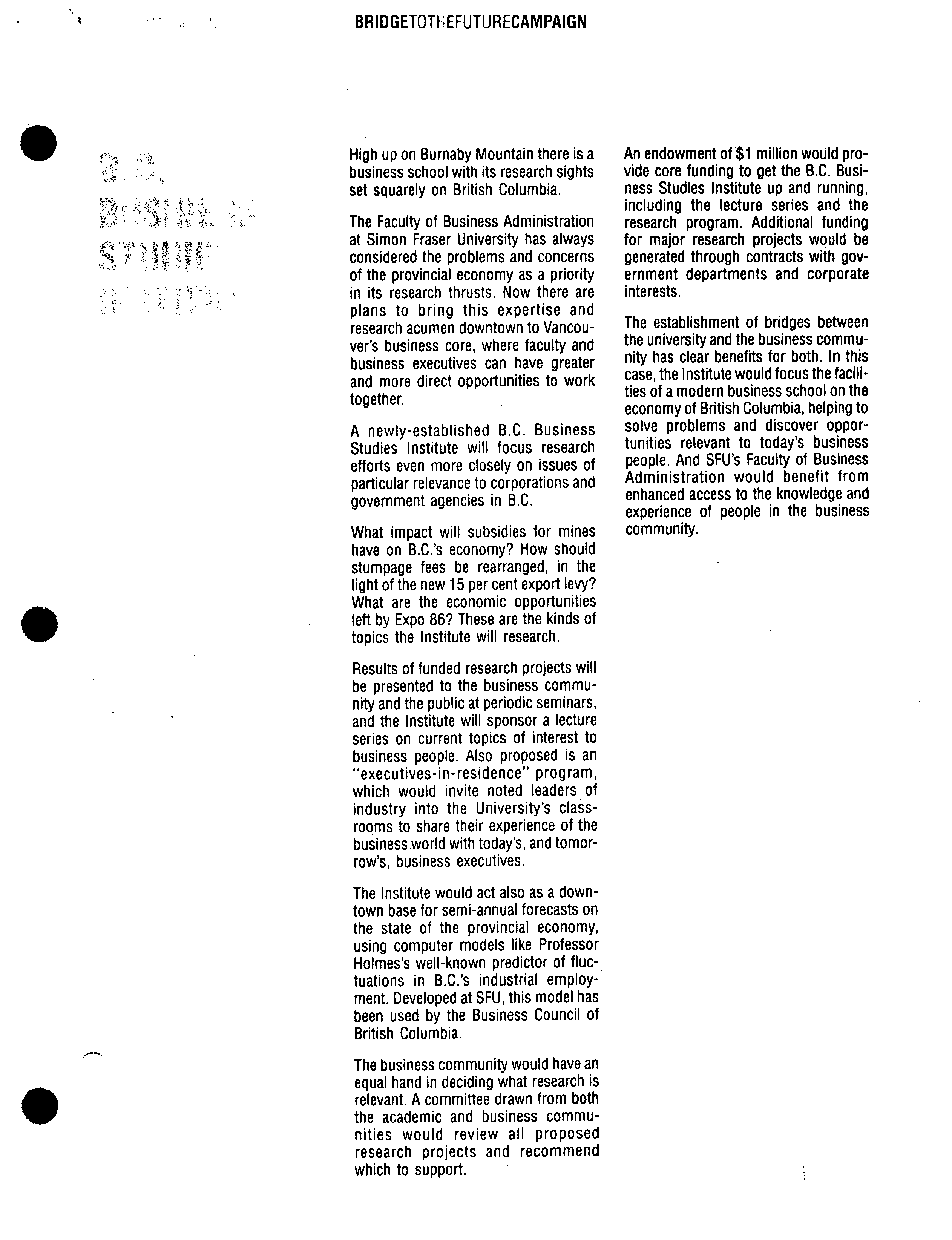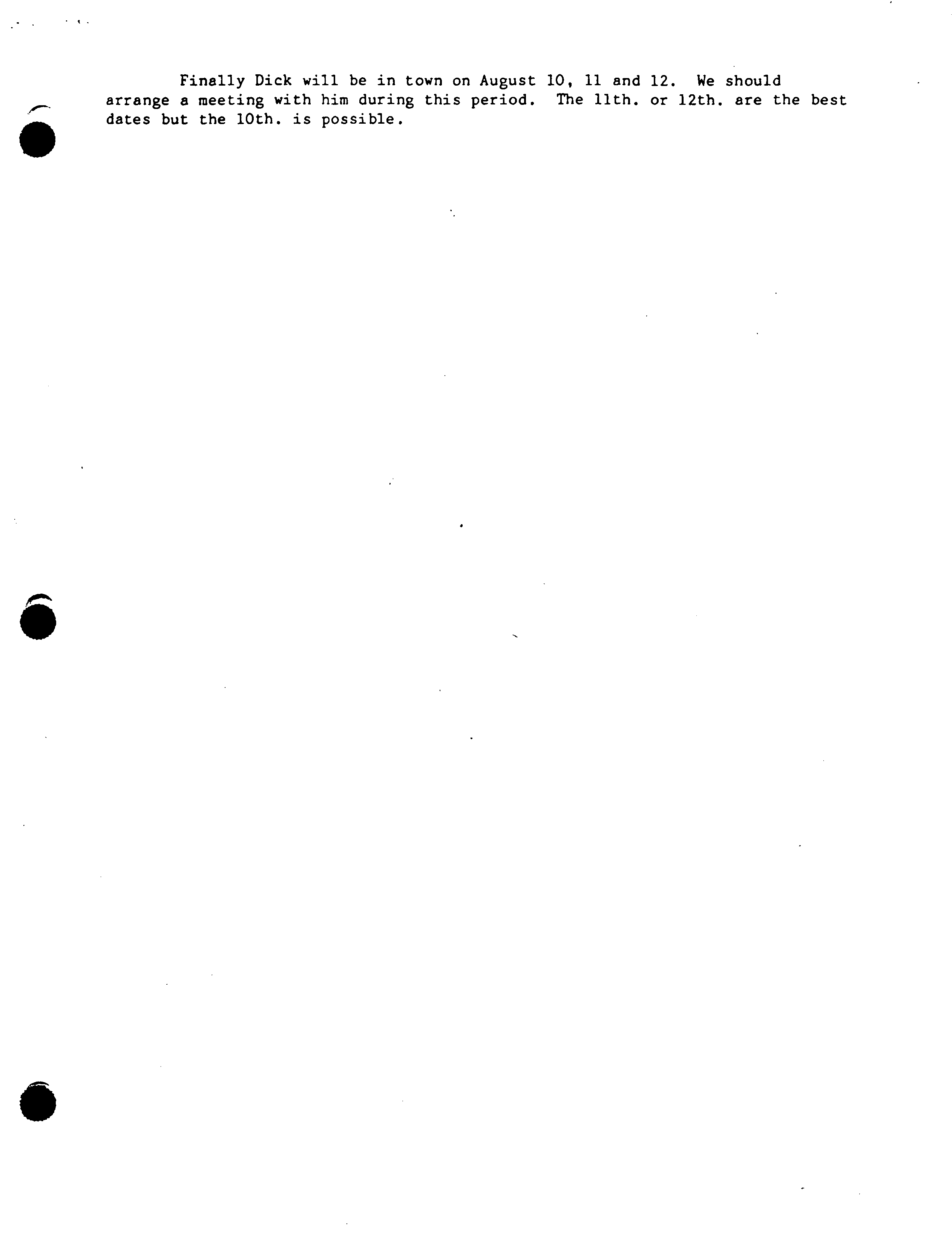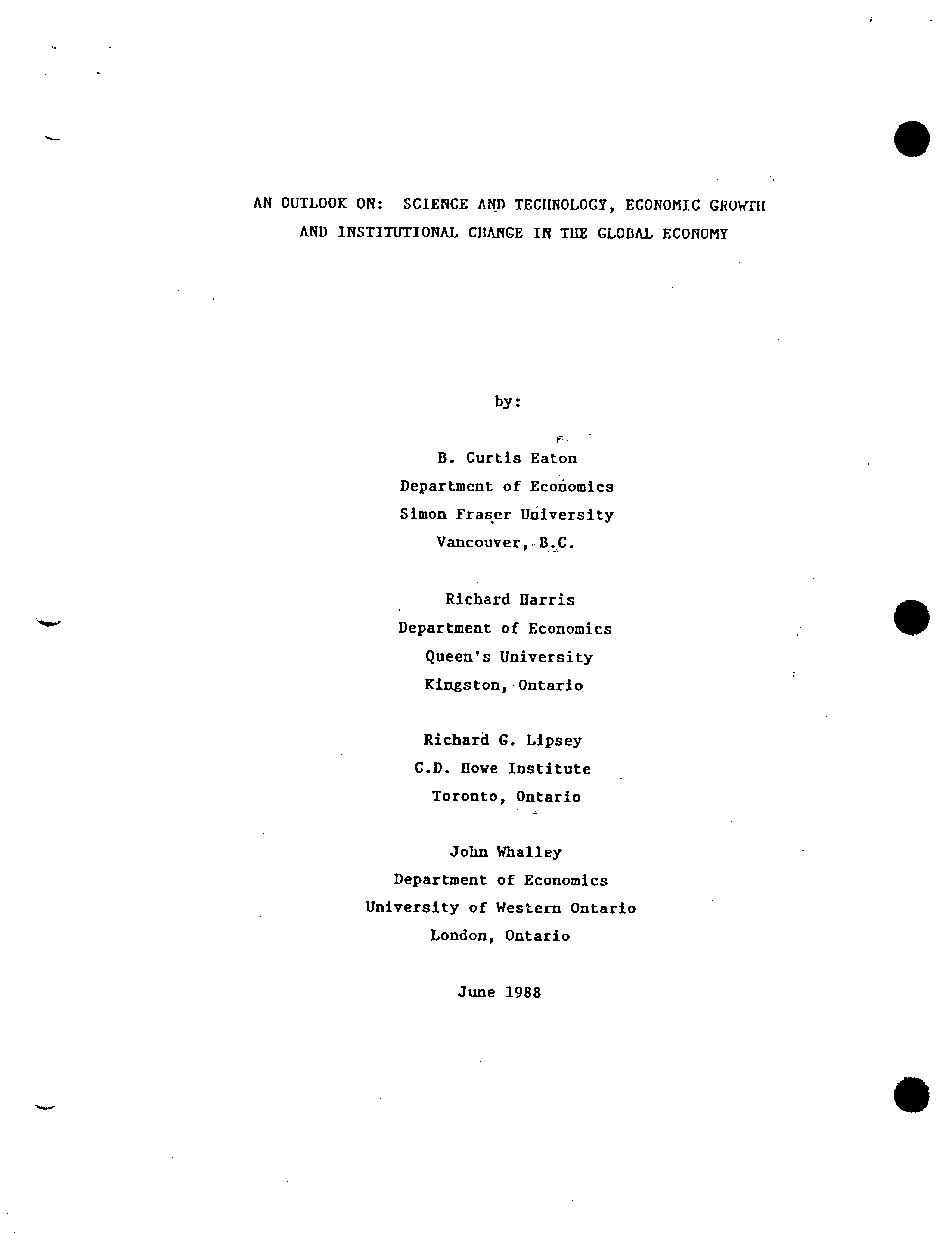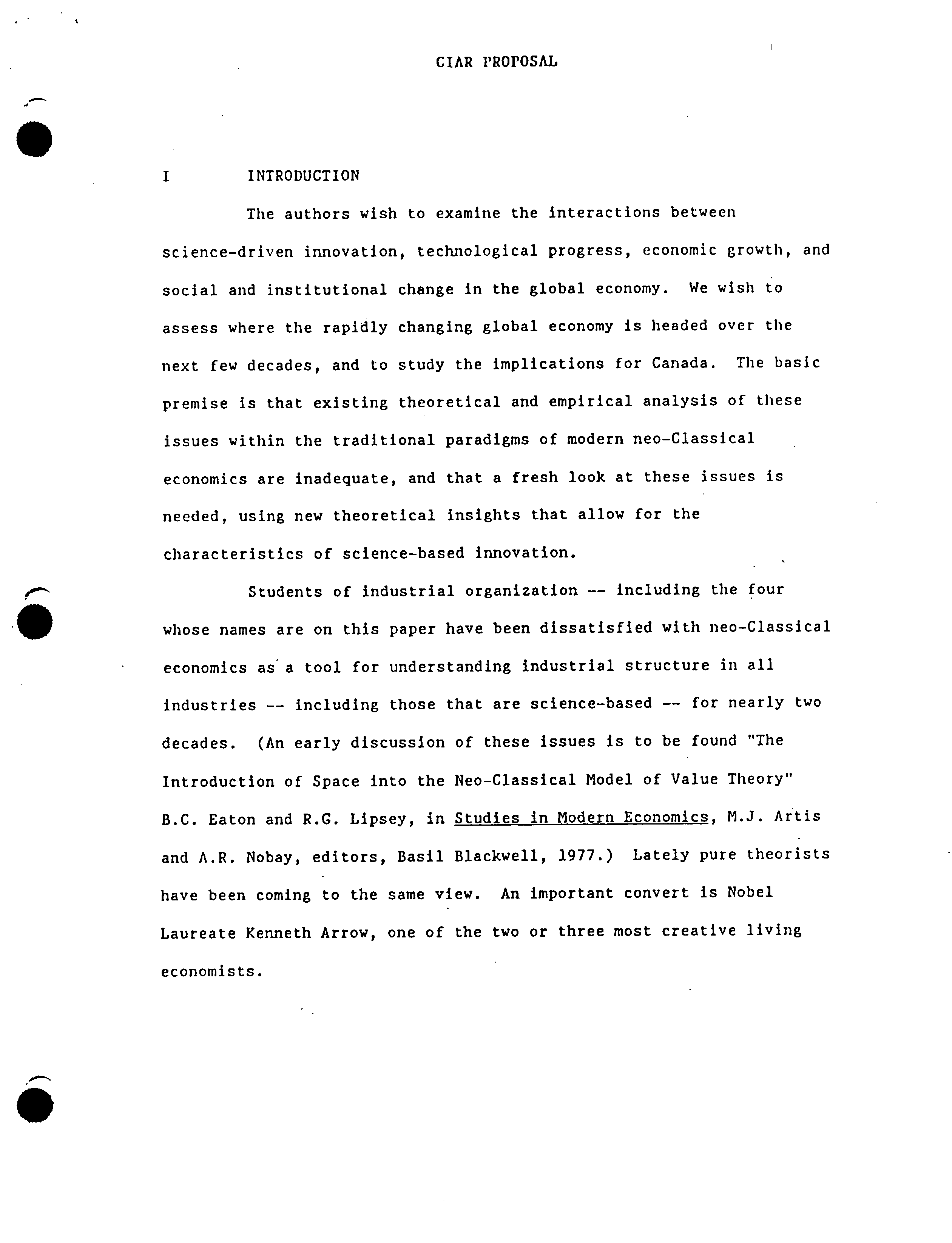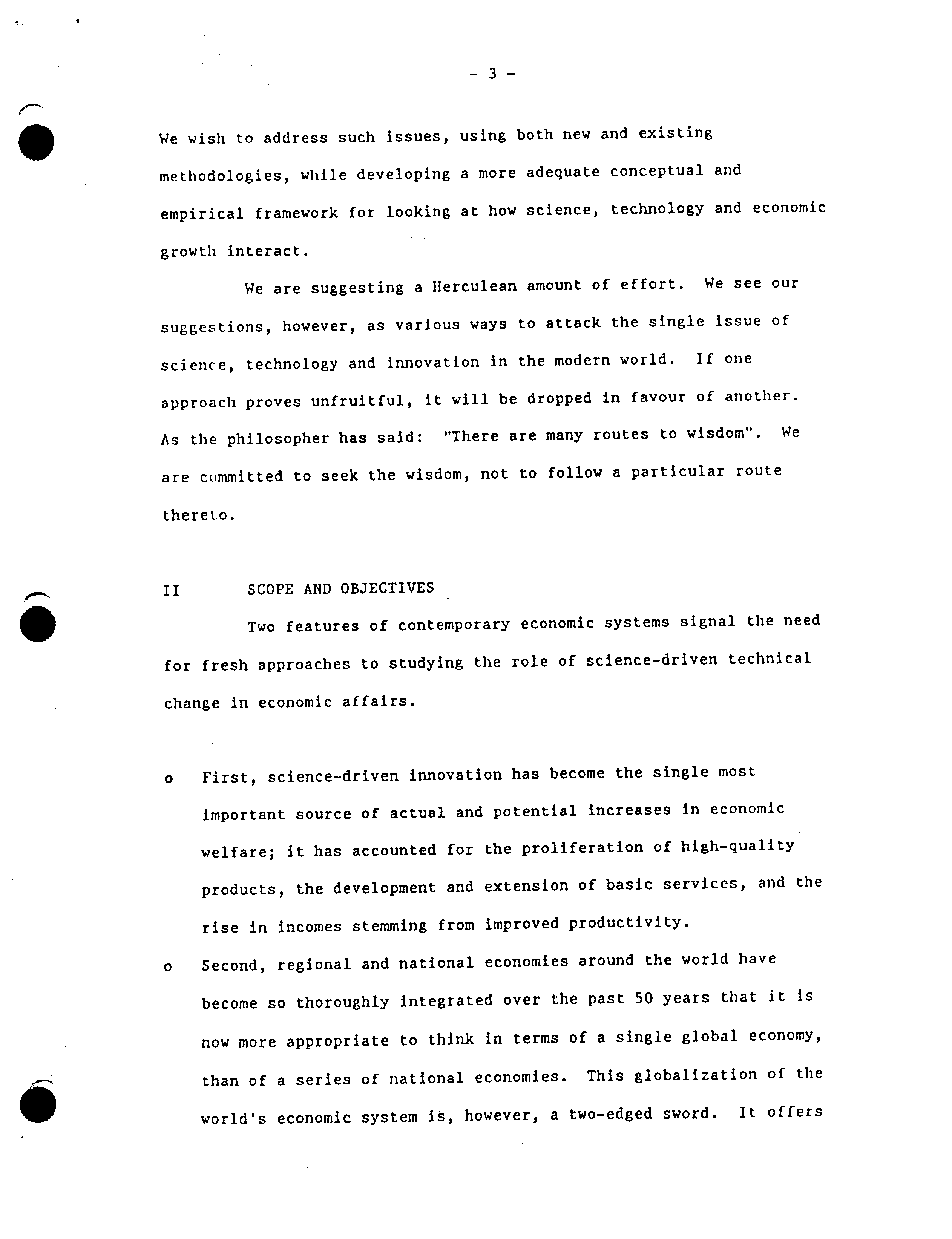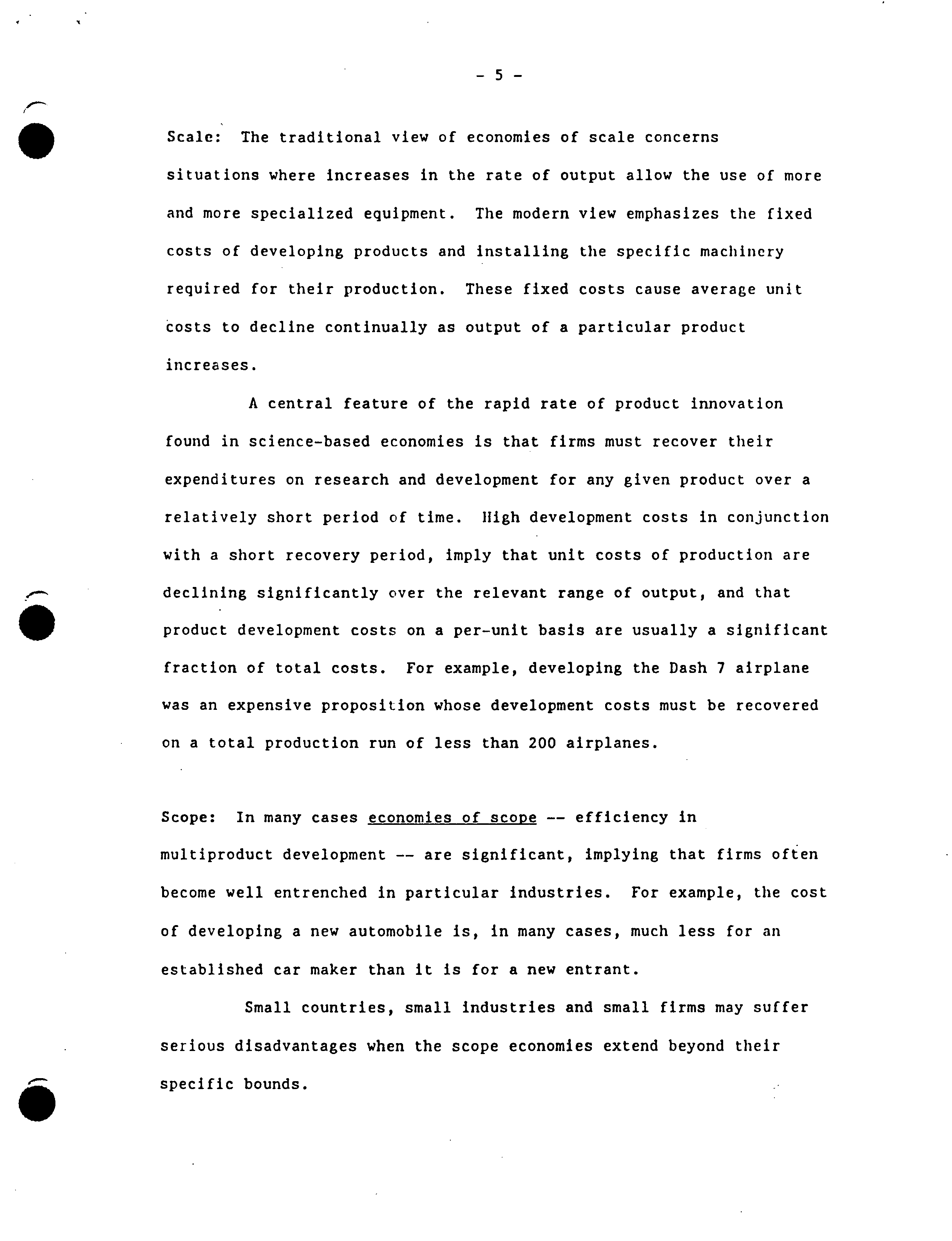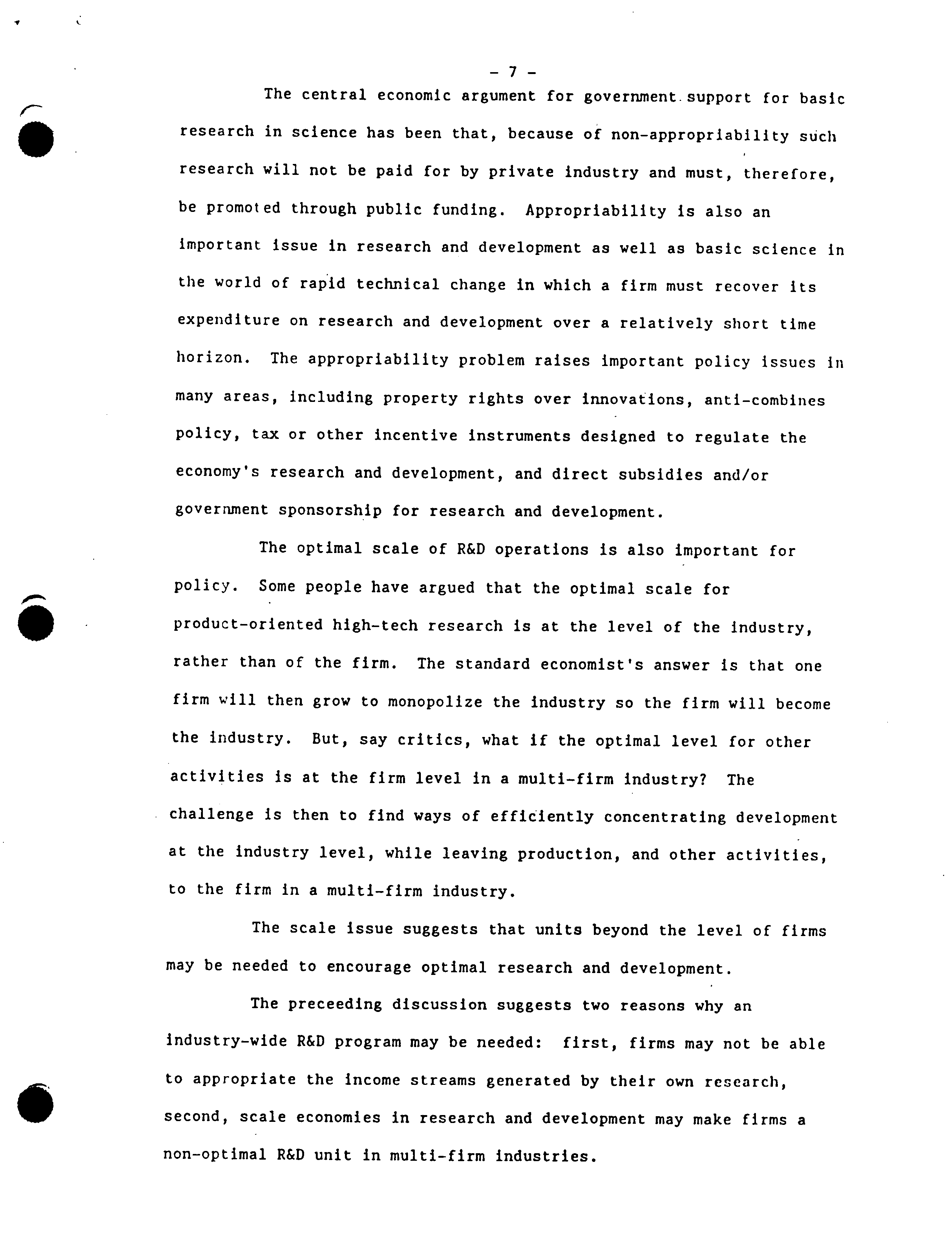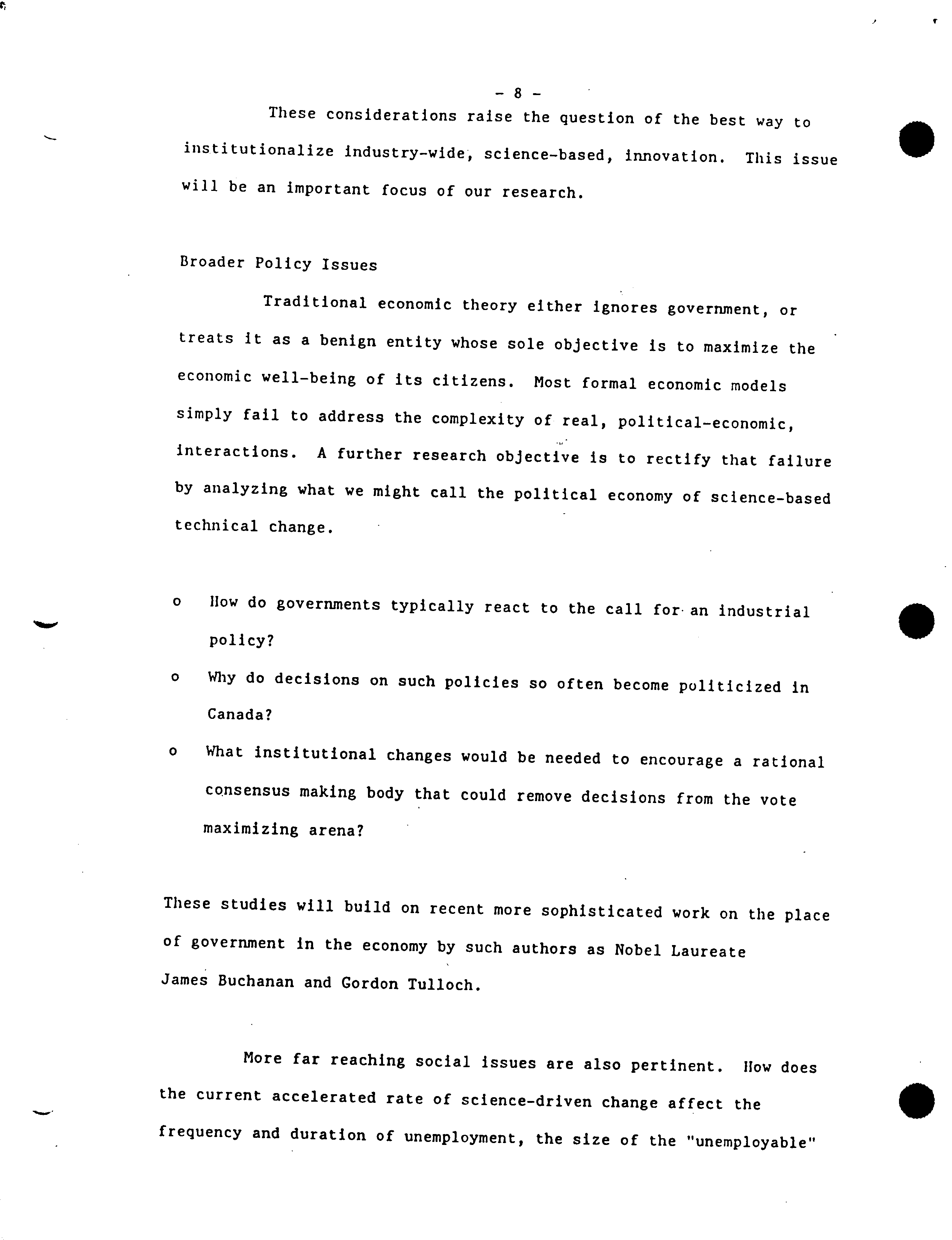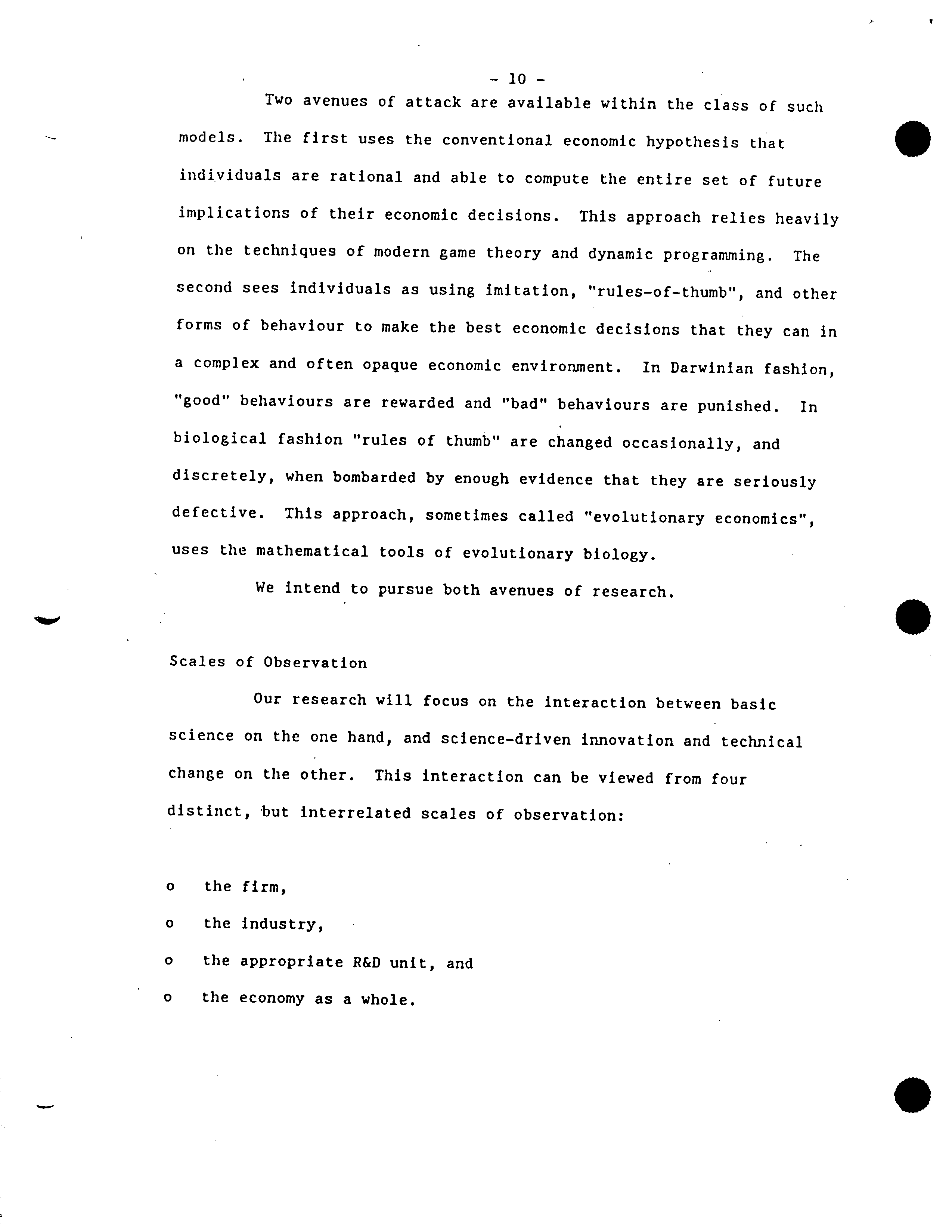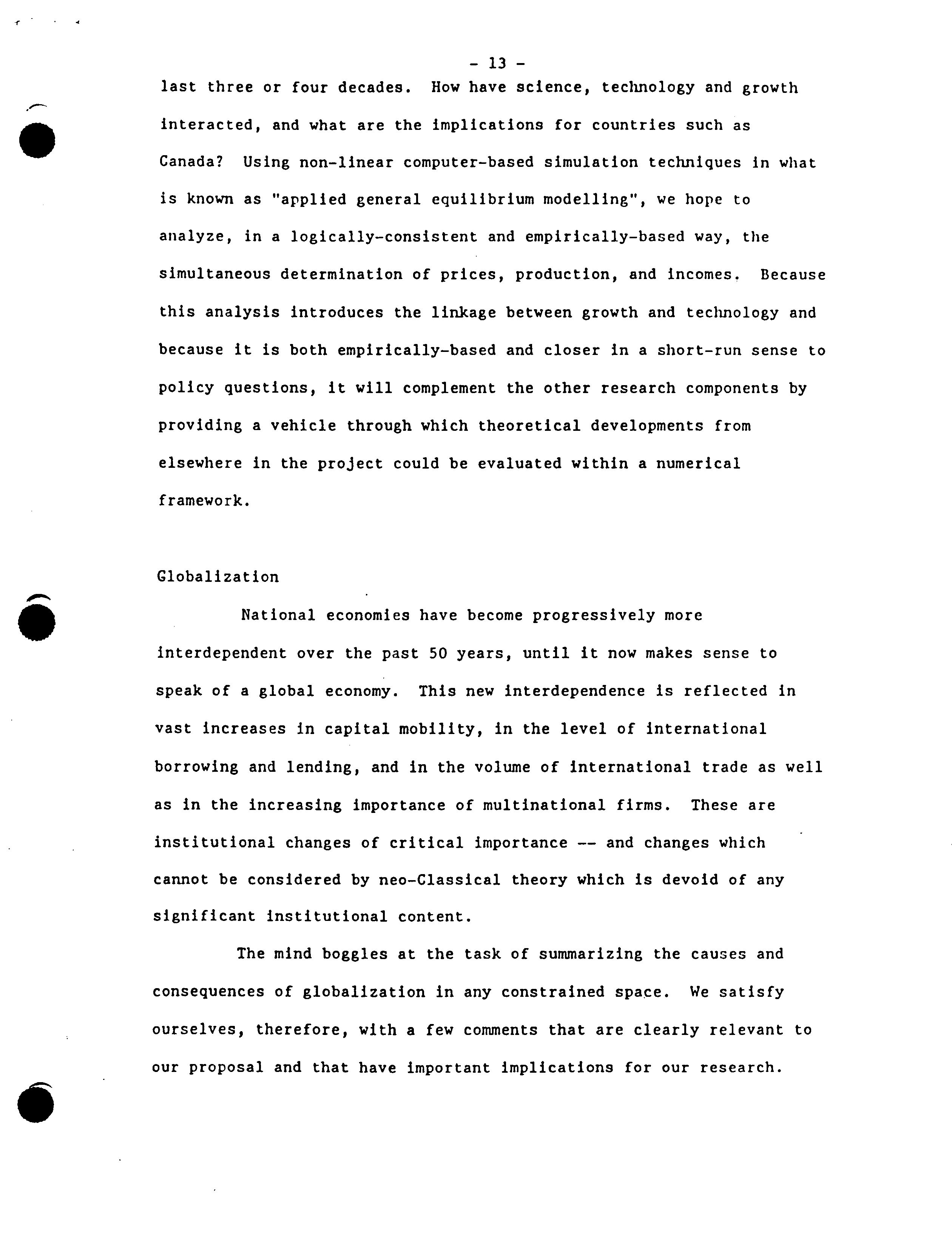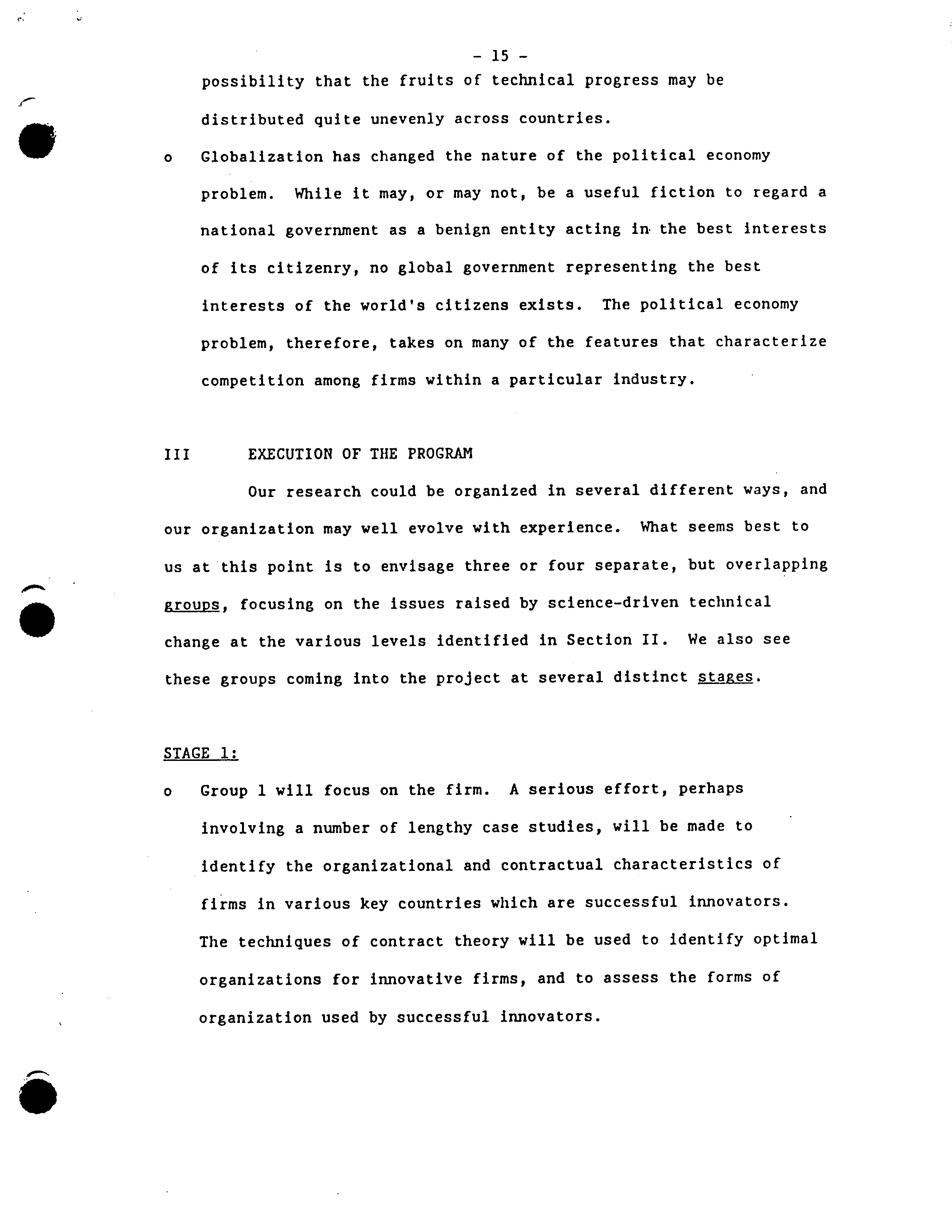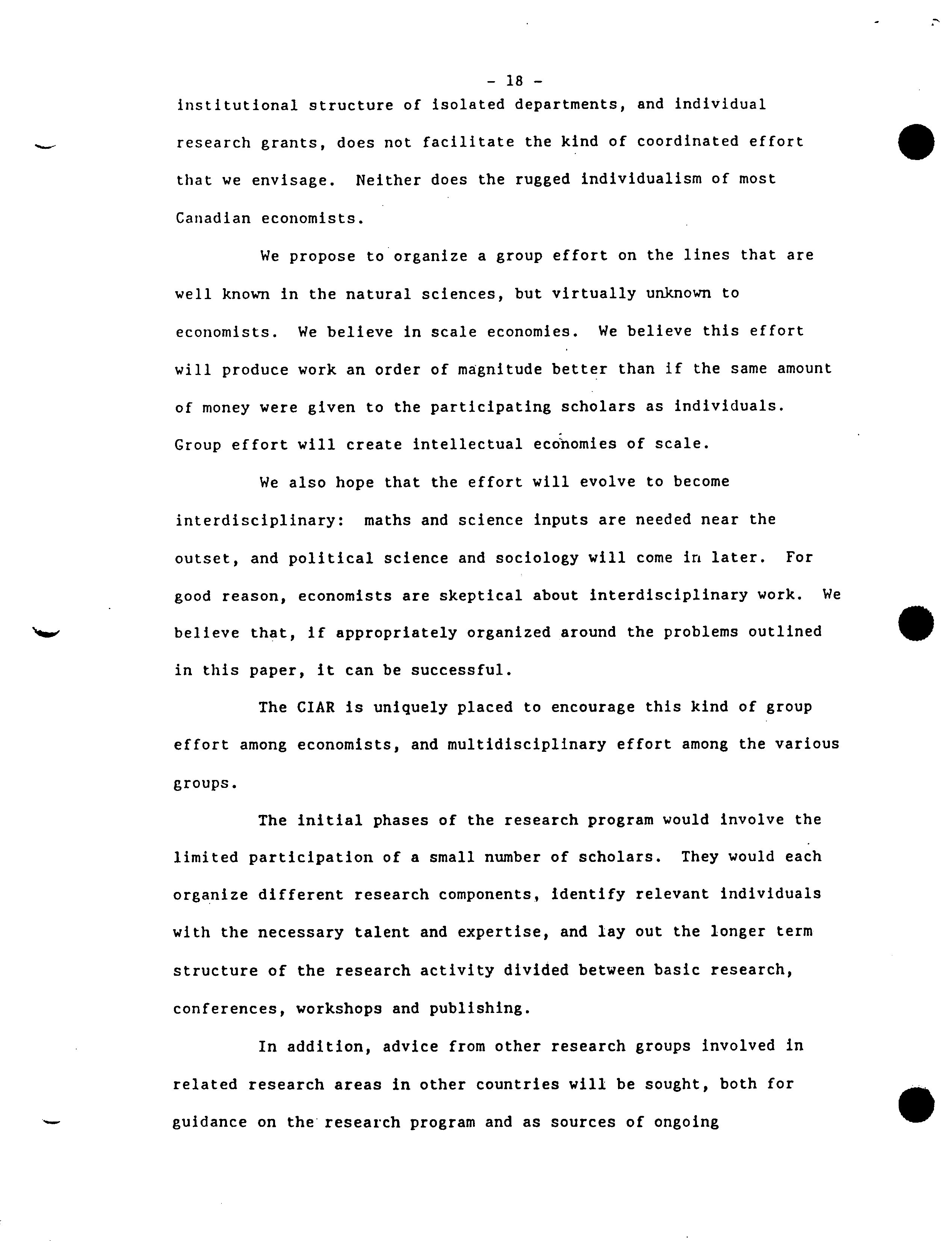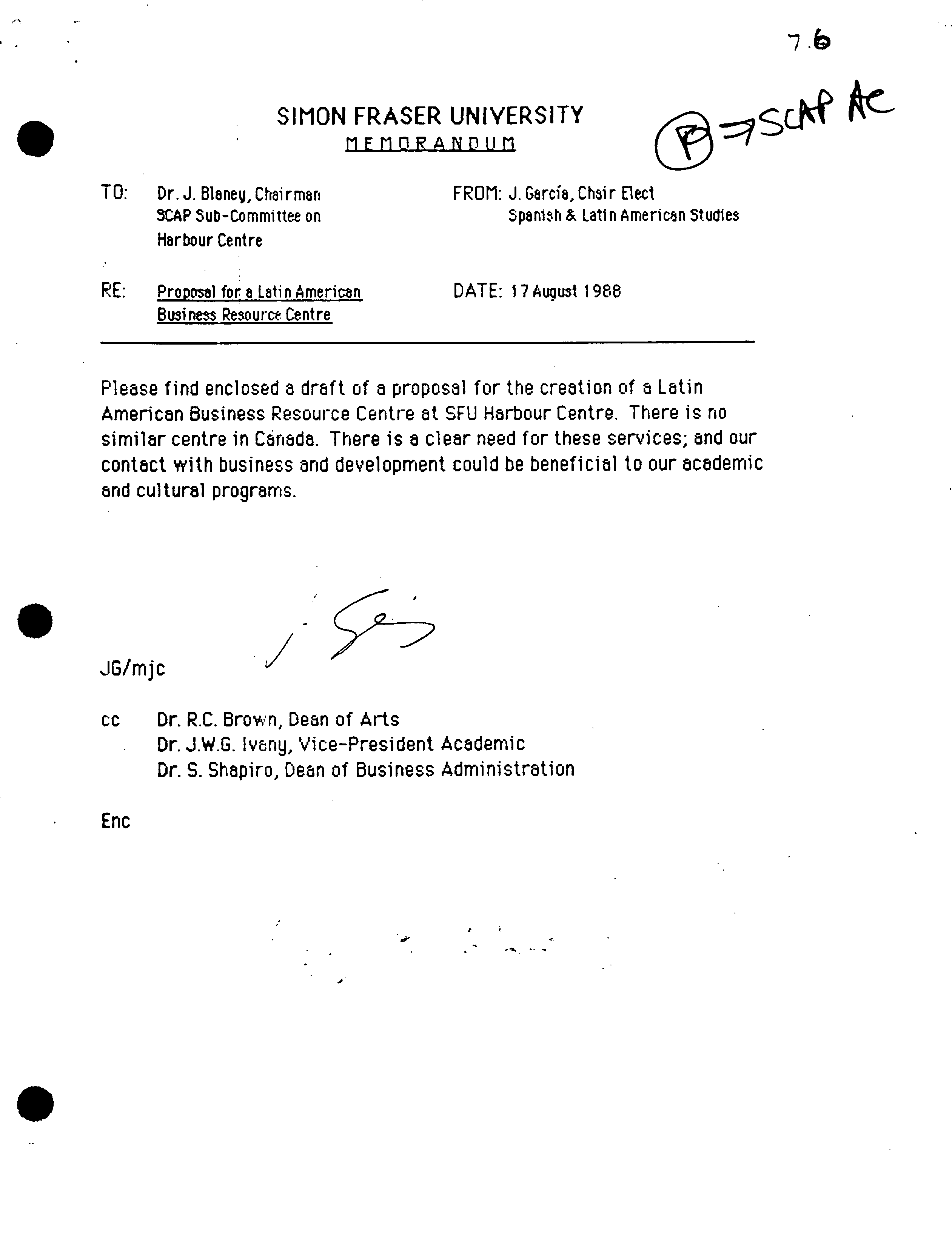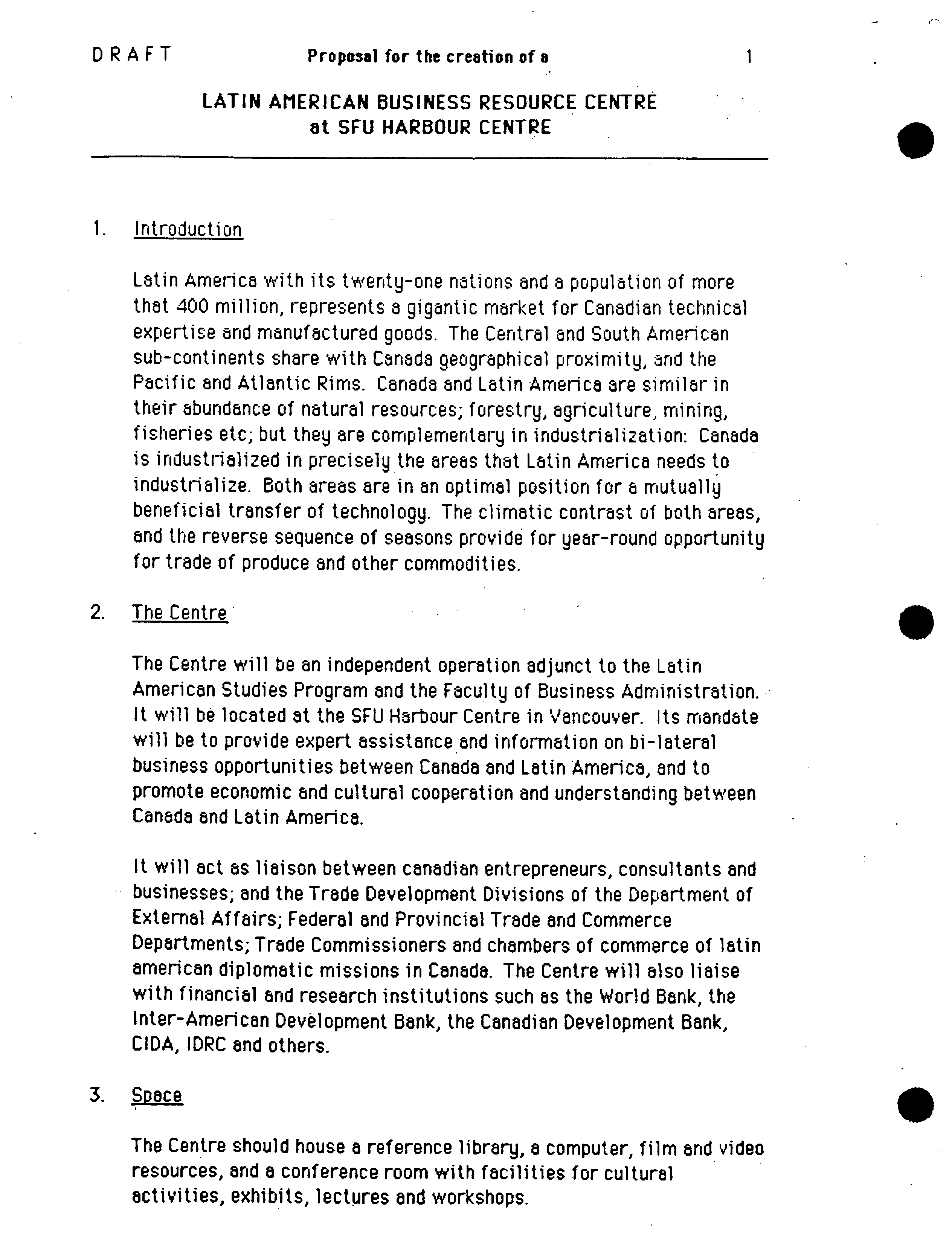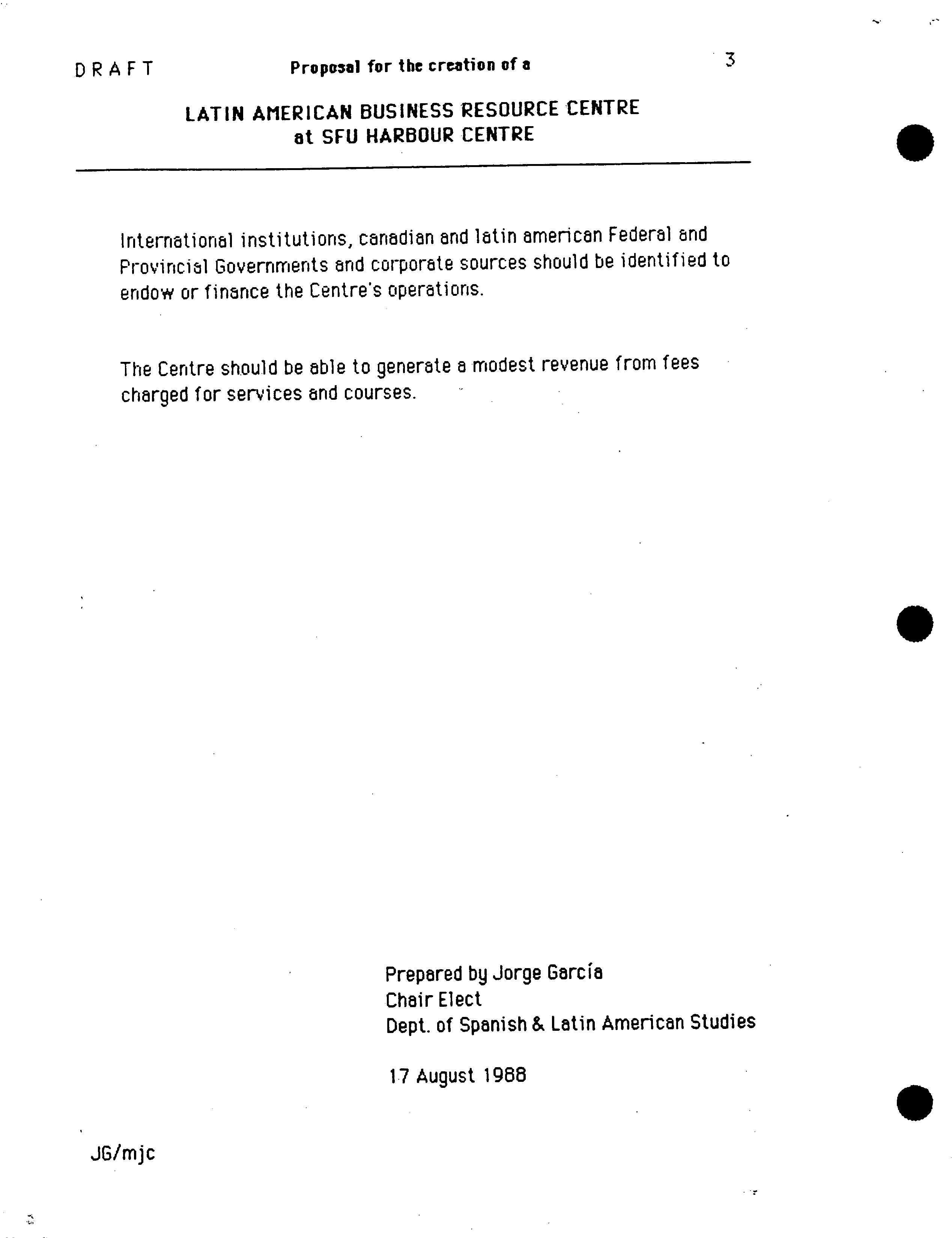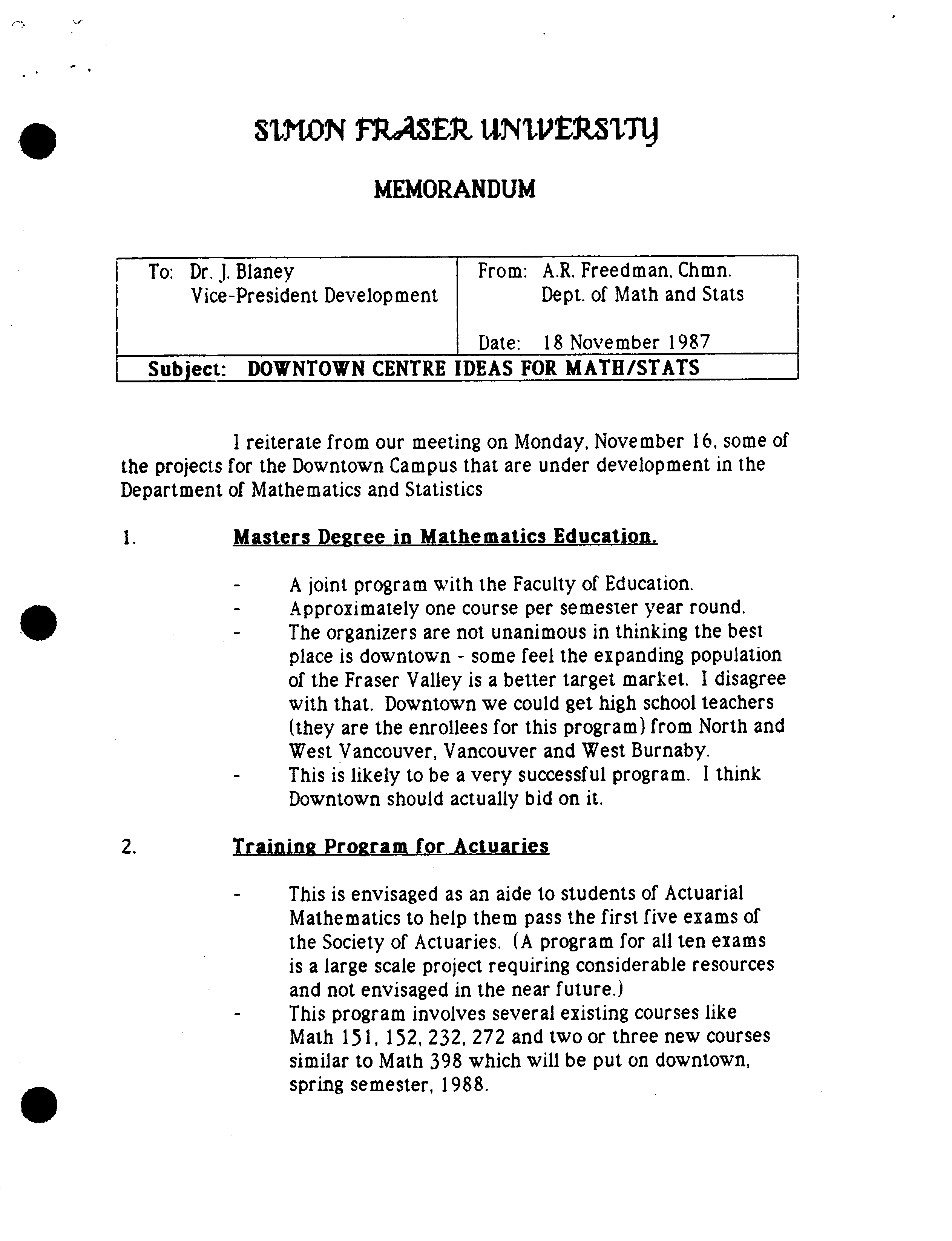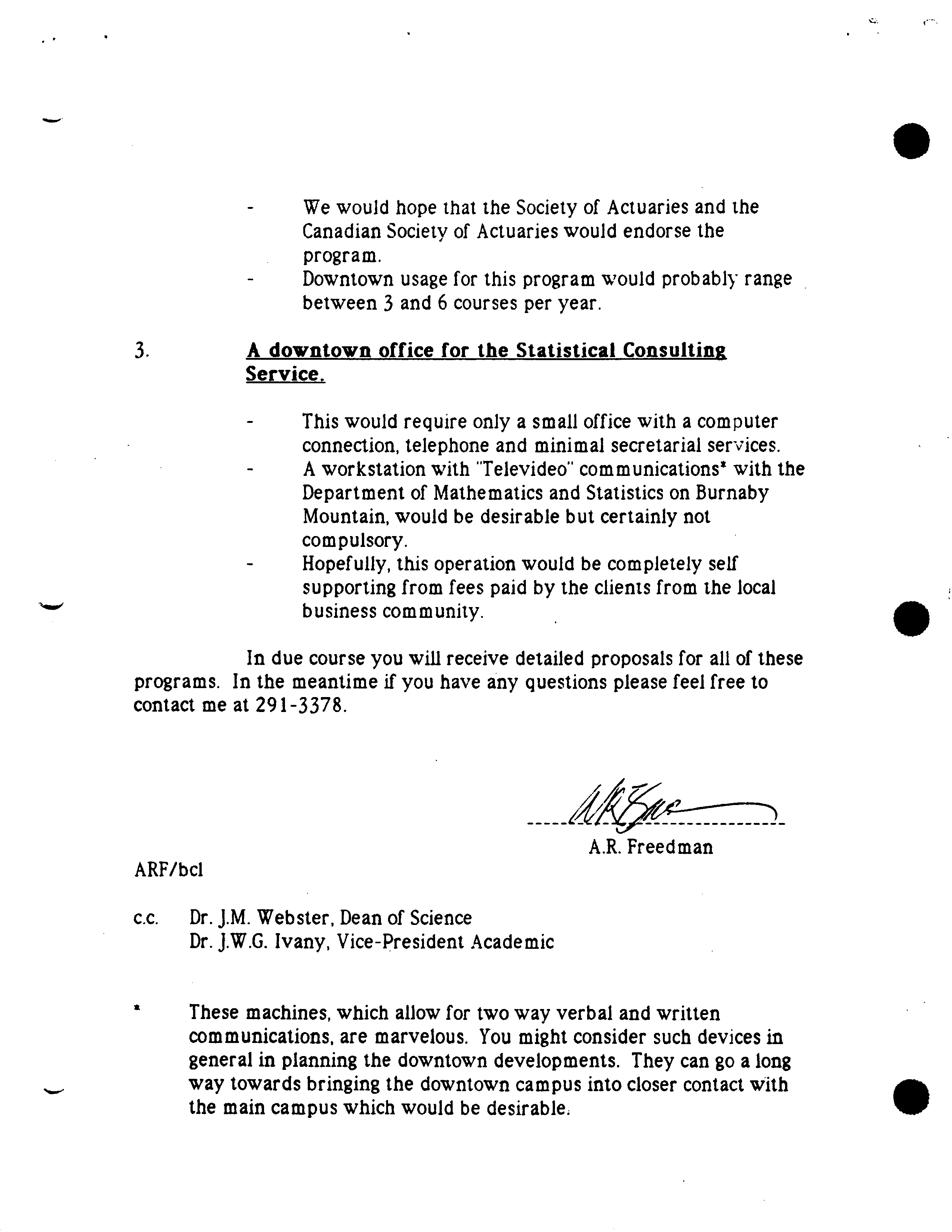
1--
"
F)R INFORMATION
S.89-13
SIMON FRASER UNIVERSITY
S
MEMORANDUM
TO: SENATE
FROM: Senate Committee on
Academic Planning
RE:
SCAP/Harbour Centre
DATE:
17 February, 1989
Program Recommendations
At its meeting of February 15th, 1989, The Senate Committee on
Academic Planning considered a number of program initiatives from the
SCAP/Harbour Centre Committee. These are attached for the information
of Senate.
SCAP has approved the programs put forward as appropriate for the
Harbour Centre Campus and has agreed that further planning and
development and exploration of funding initiatives should proceed at this
time. It is understood that SCAP approval at this time does not obviate
the need for full academic approval through the usual senate committee
process, i.e., SCUS, SCGS, SCAP, SENATE.
0
OFFICE OF THE VICE-PRESIDENT FOR
SIMON FRASER UNIVERSITY AT HARBOUR CENTRE
Memorandum
To:
Dr.
J.W.G. Ivany, Chairman
From:
Jack Blaney, Chairman
SCAP
SCAP Harbour Centre
Sub-Committee
Subject:
Program Recommendations
Date:
February 8, 1989
Following from the statement on mission and objectives for the Harbour Centre
campus approved by SCAP (SCAP 88-8) and Senate (S 88-33), the SCAP-Harbour
Centre Sub-Committee has reviewed the program proposals received from
across the university. The Committee unanimously believes that the following
programs (which are in various stages of development and funding) would be
central to the program focus approved for Harbour Centre and would contribute
materially to its development. The programs are of three types: A) new
program initiatives; B) programs previously approved by SCAP (April 9, 1986)
as appropriate for a downtown campus and C) existing programs which are to be
transferred to Harbour Centre, either in their present or in an adapted form.
.
Copies of the proposals for new program initiatives are appended.
Recommendations on other programs will be brought to SCAP following further
review by the Sub-Committee.
A. New Program Initiatives
1.
Centre for Image Sound Research
2.
Canadian/American Business Studies Centre
3.
Master of Arts in Liberal Studies
4.
Centre for International Communication
5.
B.C. Business Studies Institute
6.
Canadian Institute for Advanced Research
7.
Latin American Business Resource Centre
8.
Actuarial Mathematics
(For the most part, the above initiatives represent extensions of existing
programs or are already entered into the normal approval process.)
B. Programs Previously Aoproved
•
1. Human Performance Centre
2.
Criminal Justice Administration
- currently under revision
(
Dr. J.W.G. Ivany
Chairman, SCAP
Page 2
,. Transfers of Existing Programs/Services
1.
Executive MBA
- from the Burnaby Mountain campus
2.
Liberal Arts and Sciences/Certificates and Diplomas
- refined and potentially expanded from the base established downtown
over the past nine years. The Certificate in Liberal Arts will be a key
to the selection and organization of courses.
3.
Short Courses and Seminars Organized Through Continuing Studies
- eg., the Writing Program, the DesignProgram, professional
development programs in management, management skills for advanced
technology, public policy studies
4. Praxis Film Development Workshop
- to be relocated from rented space downtown
5. Psychology and the Law Institute
- from the Burnaby Mountain campus
6.
Statistical Consulting Service/Industrial Statistics
- development of a downtown service modelled, in part, after the
Burnaby Mountain campus service
The SCAP Harbour Centre Sub-Committee requests that these programs be
approved as appropriate for the Harbour Centre campus. Given approval, further
development and funding initiatives will be undertaken as required. Program
implementation will occur when all three requirements (approval, development
and funding) are satisfied. In the case of new program initiatives, it is
understood that approval by SCAP at this time does not obviate the need for
approval through the usual procedures (SCUS, SCGS, etc. to Senate).
.
SIMON FRASER UNIVERSITY
DEVELOPMENT OFFICE
P0. BOX 12094
RI'JJ
555 W. HASTINGS STREET
VANCOUVER, B.C. V613 4N5
Telephone: (604) 685-4448
CENTRE FOR IMAGE/SOUND RESEARCH
PROJECT SUMMARY
The Centre for Image/Sound Research (ISR) will be located at
Simon Fraser University's new Harbour Centre campus in downtown
Vancouver. Initiated early in 1987 by the faculty of SFU's Centre
for the Arts, the Centre for ISR is designed to be a partnership
between SFU and the high technology industry in British Columbia and
Canada.
The Centre for Image/Sound Research will be an interdisciplinary
research facility where problems and opportunities arising in the
area of arts and culture are addressed through strategic research
initiatives. Artists of several interrelated disciplines and their
considerable audiences will ultimately benefit from the work
conducted at the Centre for Image/Sound Research.
Throughout the 1980's it became increasingly clear that the
cultural industries were rapidly developing into a major economic
• sector in Canada and abroad. The fine and performing arts and the
multi-faceted, ubiquitous entertaiiiment industries which are based on
the arts, are of unprecedented importance in the information age we
live in.
Evolving art media and communications technologies are delivering
more music, dance, theatre and literature through film and video to a
global audience which expects more and more challenging content and
increasing fidelity of image and sound. There are strong signs that
audio and the printed word will be integrated with moving images to
an even greater extent in the near future.
The arts and entertainment sector is an extremely volatile
domain, subject to dramatic shifts in production techniques and
audience receptivity. With the rise of advanced digital technologies
there will be far greater changes in the immediate future. The
Centre for ISR at SFU has emerged as an absolute necessity, a timely
spin-off of the Centre for the Arts.
Like Praxis, a film development workshop which commenced
operations in 1987, the Centre for ISR will complement research in
progress by the faculty of SFU by providing an independent,
non-academic research environment, designed to serve the arts and
related industries in British Columbia and Canada.
-
The main objective of the Centre for ISR will be to conduct
applied research in the use of new technologies in the cultural
industries. This will involve its staff in pre-production and
production initiatives (post-production will be contracted out), in
direct partnership with private industry involved in the development
of software and hardware essential to the technology-driven arts and
entertainment industries.
In order to meet the demands of applied research in such a
complex field the Centre for Image/Sound Research will draw upon the
knowledge of the faculties of SFU's Centre for the Arts, its Schools
of Computing and Engineering Sciences, its Department of
Communication, the Canadian Centre for Publishing Studies and its
planned Centre for International Communication.
The Centre for ISR will also actively pursue collaborative
research with other universities and colleges, in particular UBC,
tJVIC and BCI'r, as well as with independent researchers, be they
artists or engineers based in non-profit or for-profit companies in
British Columbia and throughout Canada. Appropriate channels of
communication will be opened with governments, institutions, groups
and individuals involved in related work nationally and
internationally.
At the heart of the Centre for ISR will be its partnership with
private industry in B.C. and Canada. While the Centre for ISR will
need a high percentage of public financing over the course of its
.,,first three years of operation, from the day the doors open there
must be a steady climb towards self-sufficiency based on contract
research in collaboration with the private sector. The problems and
opportunities will emerge from the arts and entertainment
sectors--the solutions will result from profitable, collaborative
research with industry. Strategic research initiatives designed to
result in technology transfer will determine the direction of the
Centre for Image/Sound Research.
The Centre for ISR will have its own staff which will work in
close association with an advisory committee. This advisory
committee will be comprised of representatives of industry, SFU and
the regional academic community, as well as independent researchers
from the national arts community. While no formal academic courses
will be offered by the Centre for ISR, it is anticipated that
graduate and advanced students from the academic community will be
employed as contract staff. Training and new skill development will
be the product of applied research.
The diffusion of information on new uses of technology in the
cultural field will be a very high priority at the Centre for ISR.
To this end publications (paper, tape and electronic) and
demonstrations via audio/video teleconferencing will emanate from
this research centre on a frequent and ongoing basis. The Canadian
Centre for Publishing Studies and the Centre for the Arts are
fundamental to such a strategy. Industry will benefit directly from
'such an emphasis on diffusion. Hardware and software can be
effectively promoted through artistic statement and performance.
.
I
.
The Centre for ISR will actively collaborate with government,
industry and institutions inclined to diffuse non-proprietory
information to the public on a national and international basis.
While this reasearch centre will be first and foremost a Canadian
institution, as a national institution it will communicate
internationally with like-minded institutions and interested publics
around the world.
The Centre for ISR will naturally continue to place an emphasis
on communication with Asia-Pacific nations. From its advantageous
position in Vancouver it will serve as a catalyst for an ongoing
exchange of culture-related technical information between Canada and
the Asia-Pacific Region. To maximize such a trans-
p
acific exchange,
the Centre for Image/Sound Research anticipates a productive
association with SFU's planned Centre for International
Communication.
There is tremendous potential for an institution which can bridge
the gap between technological development and cultural trends. In
the academic environment it is clear that interdisciplinary research
can be structured around the 'science of image and sound'. Within
SFU's Department of Communication, a Media Analysis Lab is permitting
to perform social-scientific analysis of advertising and
• popular culture.
From the perspective of researchers in SFU's Schools of Computing
and Engineering Sciences there is an interest in problems of
visualization of scientific data, creating new models for perceiving
the nature of complicated data terrains. On a more general level, an
immense amount of work has to be done with respect to human factors
in computing. How can human/machine interfaces be improved?
In the Canadian arts and entertainment industry there is rarely
time or the means to address the fundamental problems or real
opportunities arising from the rapid development of new technologies
in the cultural industries. As this sector of our economy continues
to grow there is a crucial need for effective infrastructure in this
field.
With the assistance of government the Centre for Image/Sound
Research will establish common ground between academic community and
the hardware and software industry. Through shared research
initiatives culminating in timely technology transfer the Centre for
Image/Sound Research will make it possible for those with vision to
participate in the creation of our future of image and sound.
February 1988
Vancouver
9
CENTRE FOR CANADIAN-AMERICAN BUSINESS STUDIES
PROPOSAL
Policy Group
Faculty of Business Administration
Simon Fraser University
April, 1988
C
1
RATIONALE:
The Faculty of Business Administration believes that a
Vancouver-based research institute which focused on
Canadian-American business issues, with particular emphasis
on the western provinces and states, could serve a very,
worthwhile purpose. There istdolittle study of Canadian-
U.S. issues in general, and no specialized institutions for
the study of business issues specific to the western regions
of both countries.
For a number of reasons over the last decade and a
half, the effort expended on the study of Canadian-American
relations has not been commensurate with the degree of
interdependence between these two nations. In the early
1970s, as a reaction.to
perceived over-dependence on the
United States, Canada sought a "third option," and academic
research followed this pursuit. More recently, in
recognition of the economic achievements, some would say
supremacy, of Japan and the other trading powers of Asia,
public interest has focused on Pacific Rim issues, and
academic research has followed the trend. Nevertheless,
relations, particularly business relations, between Canada
and the United States are as important as ever, and will,
likely become more important with the imminent introduction
of liberalized trade.
While there are research institutes on both sides of
the border which address, or even specialize in Canadian-
American issues, recent events have shown
,
clearly that
greater attention should be directed to business issues
involving western Canada and the western United States. The
recent trade disputes over shakes and shingles, softwood
lumber, potash, and fish were primarily regional problems
which might have been made more tractable had there been an
independent business research institute with regional
p
expertise. No such research centre exists in western Canada
today.
It is also clear that implementation of the free trade
agreement over the next decade will generate considerable
demand for independent analysis of its consequences. This
is especially true given the framework format of the
agreement---much detail remains to be worked out, and this
should be based upon dispassionate, objective background
research. Unfortunately, to date the free trade debate has
been dominated by the private interest pleadings of regional
and sectorial interest groups. For issues involving western
Canada, policy makers, industry, and the public at large,
would certainly benefit from recourse to the work of an
independent, reputable, and regionally specialized research
centre.
.
In summary, there is clearly a need for a study centre
specializing in western Canadian-American business
relations. Utilizing the reports such a centre would
prepare, policy makers could more confidently design
programs that would reduce the unemployment level and
support individual business initiatives. Alert corporations
would also be provided with information on new markets and
regional windows of opportunity.
PROGRAM:
Focus:
It is our opinion that study centres often adopt so
broad a focus that the result is a dissipation of resources
and confusion of goals. To avoid this, the proposed centre
will emphasize the study of business issues which are of
•
immediate concern to western Canada, and which are
compatible with the interests and expertise of SFU faculty.
3
Such areas would include, but are not limited to the
following.
A.
Resource Industries. The economies of the western
provinces are primarily resource based, and export
oriented. A significant proportion of western Canadian
resource exports are either destined for U.S. markets,
compete with similar U.S.. exports in third markets, or
both. Simon Fraser University Faculty, particularly in
the Faculty of Business Administration, the Department
of Economics, the Institute of Fisheries Analysis, and
the Master of Resource Management Program, have an
established expertise in areas related to the
economics, management, and public policy environment of
western Canada's resource industries. SFU's areas of
particular competence include forestry, fisheries,
minerals, agriculture, water, hydro-electric power, and
fossil fuels.
B.
Direct Foreign Investment. Of on-going concern is the
extent, form, and consequences of trans-national direct
investment. Canadian public opinion and public policy
have vacillated on the the desirability of foreign
ownership, particularly U.S. ownership, of Canadian
industries. Currently there is a heightened
sensitivity towards "foreign takeovers" in the United
States. Finally, implementation of the free trade
agreement will raise policy questions over the role of
offshore investment in Canada and the United States to
gain access to the free trade area. Simon Fraser
University faculty, primarily in the Faculty of
Business Administration and in the Department of
Economics, have established a strong research record in
this area.
0
4
C.
Trade in services. International trade in services has
become increasingly important, and for some economies
has come to equal or surpass trade in goods. In
western Canada the financial industries,
telecommunications, engineering services, tourism and
transportation are especially important in this regard.
Trade liberalization in the service sectors has not
progressed as fully as in goods sectors, due primarily
to a plethora of subtle non-tariff barriers to trade.
Trade in services will become an increasingly
contentious issue between the United States and Canada,
and western Canada can be expected to share these
problems. Again, Simon Fraser University's Faculty of
Business Administration, Department of Economics and
Department of Communications have significant research
expertise in these areas.
D.
Creation, exchange, dissemination and exploitation of
"intellectual property." The creation and use of ideas
and information are of increasing importance in
•
Canadian-American relations. Issues range from
pharmaceutical patents, to protection of software; to
distribution rights over artistic material. Western
Canada has not escaped involvement in international
disputes in this area--threats to the nascent British
Columbia film location industry resulting from conflict
over film distribution rights is a case in point.
Again, Simon Fraser faculty have a strong research
record in this increasingly important area of concern.
E.
Trans-national business management. Expanded trade
relations between the United States and Canada will
confront business managers in both countries with a
more complex decision-making environment. For example,
human resource management, government regulation of
business and corporate culture differ markedly between
5
the two countries. To successfully exploit the
expanded opportunities provided by liberalized trade,
managers will need to identify the changed
environment
and adopt strategies to deal with it. The Faculty of
Business Administration is particularly strong in the
fields of business strategy, human resource management,
international business, and public policy towards
business, all of which bear upon these business
environment issues.
Functions:
The mission of the proposed centre would be to enhance
knowledge of western Canadian-American business issues
through research and education.
1. Research Activities
The primary function of the centre would be to
facilitate research on western Canadian-American business
issues by providing research support for relevant projects
involving SFU faculty and students,. Support would take the
form of stipends for researchers and research assistants.,
secretarial services, computer time,, and general office
support. The centre could also provide stipends for
visiting scholars.
At the outset, this support would be funded directly
from the centre's initial operating sUbvention,. With time
it is expected that grants, appropriate contract research,,
commissioned by both public and private sectors., and the
sale of publications would largely replace this governmental
core funding.
)
0
2. Education
The centre's education function would be satisfied
primarily through the dissemination of its research
findings. Emphasis would be upon scholarly journal
publications and research monographs. However, to make
research findings more accessible to policy makers, interest
groups and the general public, the centre would endeavor to
open and maintain channels to the print and electronic
media. Centre associates would be encouraged to provide
non-technical summaries of their research to the print media
and to make themselves available on a reasonable basis to
the electronic media for interviews and background material.
As an ancillary educational service in cooperation with
Continuing Studies, the centre would on occasion arrange
open seminars, lectures, and ultimately, conferences on
relevant, topical issues. Visiting scholars, guest
lecturers and members of the centre would be expected to
participate in these activities. The centre would not be
directly involved in degree programs, although it would
•
assist existing programs through, for example, support for
relevant graduate student research.
'ORGANIZATION
1. Location
The SFU/Harbour facility provides an ideal location for
the proposed centre. Pragmatically, there is space
available. Importantly, the downtown location will
facilitate interaction between academics, practitioners and
the public. It is proximate to many government offices,
business institutions, the media, and support groups such as
Continuing Studies. The centre's documentation requirements
could be satisfied through integration with the proposed
7
downtown SFU satellite library. Its public seminar/lecture
room needs could be met by the downtown facilities.
0
2. staffing and Governance
•
At the outset the centre would require a full-time
director appointed by the SFU Faculty of Business
Administration,
a full time administrative assistant and
clerical support. Provision would also be made for a
researcher in residence. To avoid unnecessary initial
organizational costs, research projects should be run in a
decentralized fashion. That is, proposals should be
solicited from both SFU facul
ty
and other researchers,
evaluated, and funded on a competitive basis. The
adjudication process would be conducted by an evaluation
board with representation from government, the private
sector and the University. Recipients would be made largely
responsible for the
organization,
and realization of the
project. With time, it may prove more efficient for the
centre directly to provide additional clerical staff,
research assistance and the like.
The centre would be governed in accordance with
existing SFTJ policies concerning research institutes and
centres.
0
8
SOURCES AND APPLICATION OF CENTRE FUNDS:
Western Diversification funding will be required to
establish the proposed centre.
However, the requested level
of support from that source decreases steadily over time and
disappears entirely after the fifth year of operation.
The
local award of Western Diversification funding requested is
$1,900,000.
A proposed flow of funds statement is reproduced below
and more detailed budgetary information will be furnished
upon request. When the proposed statement of expenses is
reviewed, the reader will notice that there has been no
indexing to reflect increases in the cost of living. The
impact of inflation should be offset by prudent cash
management policies. Similarly ' , there is no separate
budgeting item for fürnitüre, furnishingsand related
capital equipment.
We expect such acquisitions to be
purchased from funds freed up by the fact that the Centre's
three full-time staff members will not all be on payroll at
the time of initial launch.
The identified expense items should be self-
explanatory.
Expected sources of funding include a
decreasing Western Diversification fund subvention; a fixed
annual contribution, from'yèar two on, of $25
;
000 provided
from the endowment earnings of the SFU Institute of Business
Studies; and increasing amounts of revenue generated by a)
the centre's annual corporate subscription program; b) the
volume of contract research that will be undertaken; and
C)
the centre's seminar and publication programs.
.
Extendi ture s
1.
Director (including salary & benefits) .................
$ 90,000
2.
Administrative Officer (including salary & benefits)..
.$
40,000
3. Clerical
support....................................... $ 20,000
4.
Research support (project funding and support
for
visiting
scholars) ...............................
$235,000
5.
Promotion
and
Public
Relations ......................... $ 40,000
6. Space
(including
light
& heat) ......................... $ 50,000
7.
SFIJ
administrative
support
............... ...............
$
35,000
8.
Communication (including postage, telephone,
courier
and
facsimile) ...............................
$ 15,000
9. Staff
travel........................................... $ 15,000
10.
Library
support
& maintenance ..........................
$ 10.000
El
9
$550,000
.
WDF Subvention
IBS Subvention
Contract Research
Corporate Associates
Subscription
Seminar/Short
Courses
Publication Revenues
Sources of Revenue - Years 1-6
1
Z
6
$550,000 $475,000 $400,000 $300,000 $175,000
-
25,000
25,000
25,000
25,000
25,000
-
50,000
75,000 125,000
200,000
300,000
-
-
25,000
50,000 75,000
100,000
-
-
25,000 35,000
55,000 100,000
-
-
-
15.000
20.000
25.000
$550,000 $550,000 $550,000 $550,000 $550,000 $550,000
0
10
Resume Extracts
The Policy Group of the SFU Faculty of Business
Administration was primarily responsible for the preparation
of this proposal. To provide a feel for the range of
intellectual interests of that group, information is
furnished on their academic activities during 1986 and 1987.
Should more detail of this type be considered desirable,
complete curriculum vitae can be furnished. This could be
done not only for members of our Policy Area, but also for
colleagues in other areas of Business Administration with a
demonstrated interest in Canadian-American business studies
as well as the many SFU professors from related disciplines
who possess relevant expertise:.
.
0
II
STEVEN GLOBERMAN
Professor
B.A.
(Brooklyn), M.A. (California), Ph.D. (New York)
.
Specialization and Research Interests
.
-
International Business:. foreign exchange risk management; international investments. Industrial Organization:
economics of telecommunications industry; transactions cost models; combines: and regulatory policies;
entrepreneurship and venture capital markets, culture industries and policy.
Publications
"Government Sponsored Venture-Capital Programs: Survey Results and Analyses,"
Journal of Small Business
and Entrepreneurship, Vol. 4,
No. 4, Spring 1987, pp. 7-17.
"Economic Issues Surrounding International Product Piracy,"
Portfolio: International Economic Perspectives,
Denis Unkowc (ed.), Vol. 12, No. 7, Washington: -United States Information Agency, 1987,
pp.
1-12.
Culture, Governments and Markets: Public Policy and the Culture Industries,
Vancouver: The Fraser Instititue,
1987, 52 pages.
Foreign Ownership and Canada's Feature Rim Distribution Sector: An Economic Analysis,
Vancouver: The
Fraser Institute, 1987, 104 pages, (with A. Vining).
Economics I,
lesson notes prepared for CGA Canada, Vancouver: CGA Canada, 1987, 154 pages.
"Canadian Culture Under Free Trade,"
Canadian Business Review,
Volume 13, No. 2, Summer 1986, pp.18-22,
(with A. Vining).
"The Argument for Free Trade,"
CMA —The Management Accounting Magazine,
May-June 1986,
pp.
42-46.
"Dynamic Efficiency and Firm Size in the Life Insurance Industry,"
Journal of Risk and Insurance,
Volume LIII,
June 1986,
pp.
278-293.
Fundamentals of International Business Management,
Englewood Cliffs: Prentice-Hall, Inc., 1986, 415 pages.
"The Organization of Vertically Related Transactions in the Forest Products Industry,"
Journal of Economic
Behavior and Organization,
Volume 7, 1986,
pp.
199-212, (with R.W. Schwindt).
"Changing the Telephone Pricing Structure: Allocative Distributional and Political Considerations,"
Canadian
Public Policy,
Volume XII, March 1986,
pp.
214-226, (with B. Stanbury).
'The Merger Provisions of Bill C-91: An Evaluation," in
Reaction: The New Combines Investigation Act,
Waiter
Block (ed.), Vancouver: The Fraser Institute, 1986,
pp.
103-114.
Software Policies for Growth and Export,
Montreal: Institute for Research on Public Policy, 1986, 89 pages, (with
A. Wills and P. Booth).
Accepted for Publication
Canada's
Telecommunications Service Sector
Vancouver: The Fraser Institute.
Trade Liberalization and Imperfectly Competitive Industries,
Ottawa: The Economic Council of Canada.
Research In Progress
"Recent Exchange Rate Volatility: Implications for Management"
"Canadian Investment Policy and Regulation"
"The Influence of University Programs on Entrepreneurship," (with A. Wyckham and W.C. Wedley).
Papers Delivered at Conferences
"Evaluating Canadian Cultural Nationalism," The Association for Canadian Studies in the United States
Conference, Montreal, October 1987.
12
"Government Sponsored Venture Capital Programs: A Policy Evaluation," 32nd Annual World Conference of the
S
International Council for Small Business, Vancouver, June 1987
"Determinants of Government Policies Toward Foreign Direct Investment," annual conference of The North
American Economics and Finance Association, New Orleans, December 1986.
"The Economic and Regulatory Outlook for Satellite Services in Canada," Fibresat Conference, Vancouver,
September 1986.
Research Grants and Contracts
$60,000,1987-89. CIDA, "The Role of Schools of Management in Entrepreneurship," (with A. Wyckham)
$15,000,1986. The Economic Council of Canada, "Trade Liberalization and Oligopolistic Competition."
$11,000,1986. The Max Bell Foundation, "Provincial Government Venture Capital Programs."
Other Activities
Reviewer,
Canadian Journal of Administrative Sciences, Canadian Public Policy, Canadian Journal of Economics,
1987
Advisor, Consumer and Corporate Affairs, Government of Canada, 1987
Presented seminar on "Formal Education and the Adaptability of Workers and Managers to Technological
Change," to British Columbia Goverment, Ministry of Finance, April 1986.
Participant, public debate on Free Trade in the Film and Broadcast lndustries,organized by the Toronto Festival
of the Arts, Toronto, September 1986.
Special Awards and Honours
S
Invited participant in C.D. Howe Institute Workshop on Industrial Policy and International Trade, Toronto,
September 1986
0
13
JOHN G. RICHARDS
Assistant Professor
B.A. (Saskatchewan), B.A. (Cambridge), M.A., Ph.D. (Washington, St. Louis)
Specialization and Research Interests
Public policy; resource policy; labour relations.
Publications
"Political Economy of Resource Policy," and "Saskatchewan Potach Industry: An Exercise in What Could Have
Been," in
Resource Rents and Public Policy,
Halifax: IRPP (with T. Gunton, eds.), 1987.
"Expectations in 'Next Year Country',"
Transactions of the Royal Society of Canada,
(with T. Gunton, eds.), Series
V. Vol. I., 1987.
"Introduction", "The Case for a New Social Contract", "Attitudes Towards Unions and Worker Participation in
Management," in Canada, What's Left? A New Social Contract, Pro and Con,
Edmonton: Newest Press, 1986.
"Industrial Democracy," in
After Bennett: A New Politics for British Columbia, W.
Magnusson, et al. (eds.),
Vancouver: New Star Books, 1986.
Review, Rethinking the Economy,
by J. Laxer,
Labour/Le Travailleur,
Volume 17, 1986.
Accepted for Publication
'What Do Workers Want? Attitudes Towards Collective Bargaining and Participation in Management,"
Relations
Industrielles,
(with G. Mauser and A. Holmes).
"Labour Relations in Western Canada,"
London Journal of Canadian Studies.
Review,
The New Populism,
H.C. Boyle and F. Riessman (eds.),
Citizen Action and the New American Populism,
H.C. Boyle et al,
Beyond Revolution,
D.A. Ross and A. Larkin,
Labour/Le Travail.
Papers Delivered at Conferences
"The Administrative Burden Within Community Health Centres," Saskatchewan Community Health Centres
Association, June 1987.
"Labour Relations in Western Canada," London Conference for Canadian Studies, November 1987.
"Expectations in 'Next Year Country'," annual meeting of The Royal Society of Canada (with T. Gunton), 1986,
"Natural Resources and Economic Development," Conference on Industrial Challenge and Transformation in
Australia and Canada, SFU (with T. Gunton), 1986.
Research Grants and Contracts
$2,000, 1986. Douglas-Coldwell Foundation, "The Economics of Social Democracy," conference co-sponsored
by Douglas-Coldwell Foundation and McGill University, Economics Department.
Other Activities
Reviewer,
Journal of Policy Analysis and Management, Canadian Public Policy,
1987
Two invited lectures in Department of Economics, University of Ottawa, 1987
S
40
14
RICHARD SCHWINDT
.
Associate Professor
A.B., Ph.D. (California, Berkeley)
Specialization and Research Interests
Industrial organization of resource industries, particularly fish and forest.
Publications
"The British Columbia Forest Sector: Pros and Cons of the Stumpage System," Chapter 6, pp.
181-214 and
"Public Policy and the Pacific Salmon Fishery's Harvesting Crisis," Chapter 7, pp. 215-248, 1987, in
Resource
Rents and Public Policy in Western Canada,
Gunton and Richards (eds.), Halifax: IRPP.
"The Organization of Vertically Related Transactions in the Canadian Forest Products Industries,"
Journal of
Economic Behavior and Organization,
Volume 7, 1986,
pp.
199-212, (with S. Globerman).
"Proposal for a Future Delivery Market for Transplant Organs,"
Journal of Health Politics, Policy and Law,
Volume
11, No. 3, 1986,
pp.
483-500, (with A. Vining).
"The Dual: The Market and Planning," Chapter 7 in
Canada What's Left? A New Social Contract, Pro and Con, J.
Richards and D. Kerr (eds.), Edmonton: Newest Press, 1986,
pp.
113-127.
"A Taxonomy of International Banking," abstracted in
Atlantic Economic Journal,
No. 3, September 1986,
pp.
82,
(with J.W. Dean).
Research In Progress
industrial Organization of the Salmon Aquaculture Industry - An International Comparison," (with T. Bjorndal)
Papers Delivered at Conferences
• "Norwegian Direct Investment in the B.C. Salmon Aquaculture Industry," WRSA, Kona, Hawaii, February 1987.
Other Activities
Referee,
Journal of Health Politics, Policy and Law,
1987
Invited seminar, Norwegian School of Economics and Business Administration, March 1987
Research Fellow, University of Tromso and Norwegian School of Economics and Business Administration,
February—May 1986
0
15
CAROLYNE F. SMART
Associate Professor
B.Comm., M.B.A., Ph.D. (British Columbia)
Specialization and Research Interests
Strategic planning/management: organizational decision-making processes, environmental analysis.
Policy analysis: implementation of organizational change.
Research In Progress
International financial centres project
Strategic planning processes in the North American banking industry
Papers Delivered at Conferences
"Information and the Competitive Environment," Sixth Annual Strategic Management Society
Conference, Singapore, October 1986, (presented by co-author I. Vertinsky).
Research Grants and Contracts
$1500, 1987. Dean's Grant, "North American Banking Industry."
Other Activities
Reviewer,
Administrative Science Quarterly, Strategic Management Journal, Human Relations,
1987
Director, Undergraduate Program, 1986-87
MARVIN N. STARK
Assistant Professor (Part-time)
B.A., LL.B. (British Columbia)
Specialization and Research Interests
Law, business and society; legal relations; the role of lawyers in society and areas such as corporate and
commercial law; torts, contracts and professional standards of the legal profession.
Other Activities
Senior Partner, Stark Christian Henderson, Barristers & Solicitors.
Member, Canadian Human Rights Tribunal Panel.
Chairman, Special Committee, Law Society of British Columbia Subcommittee regarding Solicitor's Legal
Opinions
Member, Law Society of British Columbia Sub-Committee on Conflict of Interest and Lawyers as Business
(since 1985)
Chairman, Law Society of British Columbia Sub-Committee regardingSolicitor's Legal Opinions, 1987
Member, Executive Committee, Canadian Jewish Congress, Pacific Region and Co-Chairman, Law and
Social Action Committee (since 1986)
Member, Tribunal Panel of the Canadian Human Rights Commission (since 1985)
Lifetime member, President's Club, Simon Fraser University
Member, Campaign Committee, SFU, Bridge to the Future Campaign, Legal Profession Solicitation
16
.
AIDAN
R. VINING
Associate Professor
LL.B.(Hons.) (King's College, London), M.B.A. (California, Riverside), M.P.P., Ph.D
.
.(California, Berkeley)
Specialization and Research Interests
State-owned and mixed enterprises; conceptual issues in policy analysis and various aspects of criminal justice
policy.
Publications
Foreign Ownership and Canada's Feature Film Distribution Sector: An Economic Analysis,
Vancouver: The
Fraser Institute, 1987, 104 pages, (with S. Globerman).
"Issues Relating to Sentencing Guidelines: An Evaluation of U.s. Experiences and Their Relevance for Canada,"
Research Reports to the Canadian Sentencing Commission, Research Report No. 2, Ottawa: Ministry of Supply
and Services, 1987.
Review, 'The Economics of Non-Profit Institutions,"
Journal of Policy Analysis and Management,
Vol. 6, No. 4,
1987.
"Prison Labor Markets: The Supply Issue,"
Policy Sciences,
Volume 19, 1986,
pp.
83-111, (with D. Marks).
"Proposal for a Future Delivery Market for Transplant Organs,"
Journal of Health Politics, Policy and Law,
Volume
11, No. 3, 1986,
pp.
483-500, (with A. Schwindt).
"Use of Statistical Evidence in Employment Discrimination Litigation,"
Canadiar Bar Review,
December 1986, pp.
660-702, (with A. Boardman and D. McPhillips).
"Canadian Culture Under Free Trade,"
Canadian Business Review,
Volume 13, No. 2, Summer 1986,
pp.
18-22,
•
(with S. Globerman).
"Public Enterprises in Canada," in
Public Ente,prises in the World,
R.K. Mishra and s. Ràvishankar (eds.),
Bombay: Himalaya Publishing House, 1986,
pp.
131-192.
"The Advantages and Disadvantages of Mixed Enterprise,"
inMultinalional Corporations and State-Owned
Enterprises: A New Challenge in International Business,
A. Negandhi, H. Thomas and K. Rao (eds.), Greenwich,
Conn.: JAI, 1986,
pp.
221-244, (with A. Boardman and C. Eckel).
Accepted for Publication
"Ownership and Performance in Competitive Environments: A Comparison of the Performance of Private, Mixed
and State Owned Enterprises,"
Journal of Law and Economics,
(with A. Boardman).
"A Proposal to Increase the Supply of Transplant Organs for Infants and Other Minors,"
Journal of Policy Analysis
and Management,
(with A. Schwindt).
"The U.S. and Canadian Experience in Sentencing Guidelines,"
Research in Law and Policy Studies,
Greenwich,
CT: FAI Press.
"Policy Analysis: Concepts and Practice," N.Y.:
Prentice-Hall.
Research In Progress
"A Framework for Mixed Enterprise"
"The Performance of Canadian State-Owned Enterprises and Mixed Enterprises"
"Information Asymmetry: A Policy Framework"
"A Theory of Public Production"
Papers Delivered at Conferences
17
"Ownership and Performance in Competitive Environments: A Comparison of the Performance of Private, Mixed
and State Owned Enterprises," Symposium on Industrial Policy in the EEC and Spain, Barcelona, Spain, June
1987.
"The Performance of SOE, Mixed and Private Enterprises," Association of Public Policy and Management,
University of Texas, Austin, November 1986.
Research Grants and Contracts
$34,000, 1987. SSH RC, "Privatization and Mixed Enterprise," (with A. Boardman).
Other Activities
Referee,
Journal of Policy Analysis and Management, Economic Inquiry, Canadian Public Administration,
1987
Seminar "A Future Delivery Market for Organs," Department of Economics, University of Rochester, New York,
1987
0
0
NEW PROGRAM PROPOSAL
for a
MASTER OF ARTS (LIBERAL STUDIES)
at
SIMON FRASER UNIVERSITY
RATIONALE:
The Master of Arts (Liberal Studies) degree will be a graduate degree with a
difference. Unlike conventional postgraduate degrees, it will provide an avenue for
students of widely varying backgrounds and ages to pursue paths of learning which
integrate knowledge from many of the traditional disciplines. The graduate Liberal Studies
program will provide an alternative educational choice for those students who wish in their
graduate work to develop not merely expertise within a single field but a deeper intellectual
grounding in the values and traditions which have shaped our culture as a whole.
Although there are
75
such graduate programs in the United States, in places as
diverse as Harvard, Johns Hopkins, Chicago and the University of Oklahoma, this will be
the first such program in Canada. The Liberal Studies Program will not duplicate existing
graduate programs, and it will reach new students, particularly as it will be offered at SFU
Harbour Centre.
At the center of the Liberal Studies Program will be the sense of the underlying ties
between the disciplines. This focus is based on the belief that discovering these intrinsic
relationships among the fundamental ideas of our civilization forms a coherent basis for
intellectual growth The program will provide a rigorously structured, broadly conceived
curriculum which will place learning in the widest available contexts, lending coherence
and depth to issues of perennial human concern.
The Liberal Studies curriculum will be based on careful analysis of central intellectual
tensions which are interwoven into the fabric of our culture. An interdisciplinary approach
to these fundamental historical themes will cut through the traditional boundaries that tend
to lead to intellectual segregation in many curricula. Because such basic themes of our
intellectual culture as the dialectic of reason and passion in human affairs, the relation of
self to society, and the struggle between tradition and modernity have resonances in many
disciplines, a curriculum structured around the study of such tensions will permit the
contribution of faculty from many parts of the university. Because such themes have both
an historical dimension and clear applicability to present concerns, they will provide an
effective curricular structure for mature students who wish to gain intellectual grounding
for their action in the contemporary world. The program will lead students to clearer, more
deeply based questioning of contemporary cultural assumptions understood in the light of
cultural traditions.
S
STUDENTS:
Judging from the experience of other similar programs, the student body will consist
largely of mature students with ages ranging from 23 to
65,
about -evenly divided between
men and women. Some will have been out of university for many years, whether in
business and professional careers, or as ,housewiyes and mothers. Others will be more
recent university graduates who have not begun a career and who .do -not wish t9 pursue
graduate work in a specialized field. Some will go on to do ,a Ph.D. in a professional field,
though for many more the Liberal Studies Program will be part of career reorientation or
intellectual enrichment for those who feel constrained by the naripwness of thejr careers
and their earlier educations. For all these students, the program will offer a far deeper and
more structured educational challenge than that offered by other forms of adult education,
and a more flexible and broader program than that given in traditional, specialize4 graduate
'programs. Given Simon Fraser's long tradition of interdisciplinary innovation to meet the
educational needs of a diverse student body, we seem particularly well suited to this kind of
academic program. To be offered at SF0 Harbour Centre, this -program will contribute -a
'strong liberal studies presence within the overall mandate of that campus.
NOTES ON THE PROGRAM:
The structure of the program is detailed in the -attached
draft calendar entry. 17hc
following notes augment that information.
-1. Each seminar will be for five graduate credits. All students will-enter dining the Fall
semester, and will 'be required to take the two core seminars in -sequence -duing the first
-year. A brief pre-seminar for entering students will overview the prograinand-sharpen the
scholarly skills of-new students. Each student will also complete
.
four additional, seminars,
at his or her own pace. Itis anticipatedthat one or two such additionalcourses will be
-offered each Fall ,and Spring
,
semester.
2.
In addition to the thirty credit hours earned in this fashion, each student will
,
present
two of his or her essays for formal examination in order -to satisfy the Simon Fraser
extended essays requirement'fora Master's degree. It is anticipated that the defense,might
take place within a seminar situation tailored to,the program, in order toenhance-cpllegiality
within the program.
3.
Normal graduate grading standards-will apply throughout'theprogram. To maintain
the quality of seminar discussions, enrollment will be-limited-to, abciuttwenty,newstuclentS
each year.
4.
The touchstone of the Liberal Studies Program will be the two integrated core
seminars whic
inc
h
om
al
i
l
ng students will'berequired to takein sequence. -Both-pourses
Will deal with texts which address profound human concerns that ihaveiremained
'fundamental over a-long span of time. A series of brief essays written ' in- these
,
seminars
will enable students to elucidate themes raised during intense and
.critical class discussions
To maintain coherence ,the.teaching and thecontent of the two core seminars - will -be
carefully coordinated. This-mayinvolve either team:teaching or a more limited.bu
t
still
intense participationbyeach teacher in the other,s class. In addition, experts onspecific
issues, some of whom may teach other courses in the program, will be invited-to join-
,.the
core seminars fromtime to time. It is anticipated -that asthese 'courses are rçfiuied over
time,, a substantial' number, of the texts will 'be regularly used, so that sudentstiffçiejt
stages of the program will have some common background.
.2
.
..5. The other seminar courses will have more varying content, within the general theme
-,t-V of the course. This approach will enable faculty from various disciplines to teach in the
program, either individually or in collaboration. Typically, a faculty member might work
out an approach to the course theme in consultation with the Program Director, and then
invite one or more experts to participate in the instruction at various points in the course.
However these courses may be taught from time to time, they are interdisciplinary in
conception and should never include only a single disciplinary perspective.
STAFFING AND FUNDING:
The program will be guided by a steering committee of senior academics, appointed
by the Dean of Arts. This committee will serve as the Graduate Program Committee, and
will approve all individual course offerings. The Dean will also nominate a Director for the
program to the Vice-President, Academic, to serve a term of three years.
Teaching faculty will be drawn from well established scholar-teachers at Simon
Fraser, augmented by distinguished visitors. It will be essential to offer attractive incentives
for participants in the program, and to their home departments when secondment is
involved.
A substantial endowment for the program is being sought, and currently close to a
million dollars has been secured. When complete, the endowment should finance a very
substantial portion of the program's operating costs We estimate the annual costs of the
program at full operation (6 courses per year) to be distributed as follows:
Director (half time)
$40,000
4
course secondments per year
@
$8,000/course
32,000
•
Honoraria for guest specialists @$500/course
3,000
-
Program Assistant (half-time)
10,000
Office and publicity expenses
5.000
Total
$91,000
PROGRAM IMPLEMENTATION:
An essential step in the implementation of the Liberal Studies Program will be the
appointment of a Director. Following Senate approval of the Program a search for this
individual should begin. Optimally a senior faculty person will be appointed to provide
continuing intellectual and administrative leadership.
It
may be appropriate
to
bring a
senior scholar to the university, jointly appointed with a regular Arts department.
The director will be expected to co-ordinate, lead and shape the evolution of the
Program, soliciting the interest of faculty across the University and insuring the coherence
of
course offerings over time. The following course descriptions have been developed
prospectively in order
to
help articulate the shape
of
the Program and to demonstrate the
strong Liberal Studies Program that this University can offer. When actually mounted, the
specific content of the courses may differ from the attached sample course outlines, within
the general shape now proposed.
3
The Program will be phased in over a three year period, starting in the first semester
with one of the core courses, followed in the second semester by the second core course
and one seminar. By the start of the second year one of the two core courses should be
offered each Fall/Spring semester, accompanied by at least one of the other seminar
courses.
Proposed Calendar Entry
Master of Arts (Liberal Studies)
The Faculty of Arts offers a program of Liberal Studies leading to a Master's Degree.
The program is intended for appropriately prepared individuals who wish to pursue a
liberal education at the graduate level. It offers the opportunity for wide reading, careful
reflection and intense discussion about human thought, values and experience. The
program is offered through evening study at SFU Harbour Centre, and is designed
primarily for persons who can only undertake part-time study.
The central theme of the program is an exploration of significant tensions within our
intellectual culture, tensions that have historical origins and that have practical
consequences in our present world The required series of seminar courses and the
preparation of extended essays will enable participants to understand the intellectual and
cultural contexts of contemporary problems, to reflect on central dilemmas that have
marked human civilization, and to enrich their lives by encounters with important texts and
seminal ideas.
0
ADMISSION
Applicants must satisfy the Liberal Studies Graduate Program Committee of their academic
suitability for the program. In addition to fulfilling the normal university graduate
admission requirements, prospective students must demonstrate their readiness for the
program through letters of reference, samples of written work, and normally an interview.
Exceptionally, the Graduate Program Committee may recommend for admission applicants
who do not meet normal university requirements, but who by reason of prior experience,
strong interest, and demonstrated competence are particularly suited to the program.
DEGREE REQUIREMENTS
Students are required to complete six seminar courses, and to submit two extended essays
for oral examination: Two of the six required courses are core courses, which must be
completed in the first two semesters of attendance. These are: L.S.
800-5,
Thinking about
Human Passion, and L.S. 801-5, The Capacity and Limits of Reason. The remaining four
courses may be selected from among those offered within the program. Students may
enrol for one or two courses per semester. Exceptionally, and by agreement of both the
Graduate Program Committee and the department involved, a student may be permitted to
take one graduate course in another department toward the Liberal Studies degree.
2
The extended essays will normally be developed from papers completed for course work.
.
They will be examined as for the examination of a Master's thesis under 1.10.1 of the
General Regulations.
The Liberal Studies Program is designed for students who seek educational breadth at the
graduate level. It emphasizes a community of inquiry and discussion over independent
research. For this reason, the program entails several special expectations, within the
general regulations for graduate study at Simon Fraser.
1.
Students admitted to the program are required to attend an introductory short-course
conducted prior to the beginning of the first core course in the Fall semester.
2.
Supervisory committees will be arranged by Director of the Program. By approval
of the Dean of Graduate Studies, the supervisory and examination process for the
extended essays requirement may be modified to emphasize collegial exchange.
3.
Students should expect to participate in out of class activities, such as occasional pre-
class dinners, that are designed to encourage interchange among the participants, and
to enhance a sense of intellectual community.
4..Because the program is designed for individuals having other obligations, who may
for that reason require greater or lesser amounts of time to complete the program, the
normal SFU graduate tuition fees have been adjusted for this program. See the
appropriate entry under graduate student fees. *
•
LIBERAL STUDIES COURSES
Liberal Studies Courses are designed as intensive seminar courses. The two core
courses, L.S. 800 and 801, will develop a common base of readings for all students in the
program. The other six courses may be expected to vary considerably in approach and in
specific content on each occasion of their offering. Each of them, however, will address a
central tension in our intellectual lives, trace some of its sources, and consider its impact on
our experience of the present. All the courses are cross-disciplinary in orientation and may
draw on faculty from across the university to contribute expertise to the discussions.
L.S.
800-5 Thinking about Hwnan Passion
The first of two core courses that constitute an extended examination of the tension
between reason and passion in human experience. This course will emphasize close
reading and discussion of works, drawn from different cultures and epochs, that reflect on
human passion.
* It is proposed that fees should be set on a per course basis, equal to the normal fees
required for a Master's candidate who completes a degree in two years -- currently $3234,
or
$539
per course. It is further proposed that from endowment funds dedicated to this
program, a graduate bursary be established for students within it, with a maximum value of
tuition reimbursement.
5
L.S. 801-5
The Capacity and Limits of Reason
The second of two core courses that constitute an extended examination of the tension
between reason and passion in human experience. This course will examine writings by
some of those who have insisted on the indispensability of reasoning as a guide to action
and the source of truth, as well as writings by some of those who on various grounds have
cast doubt on this faith in human reason.
L.S. 810-5
Self and Society
This course will examine some aspects of the relationship between selfhood, as idea
and experience, and social organization. Approaches to the topic will vary, but may
involve scientific, social scientific, philosophical and aesthetic perspectives.
L.S. 811-5
Tradition and Modernity
This course will examine ways in which ideas of tradition and traditional societies
have come into conflict with forces of modernization and ideas of modernity.
L.S. 8
12-5 Science and Human Values
This course will deal with issues surrounding the nature of the scientific attitude, the
growth of scientific knowledge and the impact of scientific and technological change.
Specific attention will be given to the value implications of science and technology in
relation to other forms of human understanding and experience.
L.S. 813-5
Religious and Secular W orld Views
This course will deal with the conflicts and continuities of secular and religious
approaches to such fundamental issues as the origins of the universe and of the human
species, human virtue, and human destiny.
L.S. 814-5 Liberty andA uthority
This course will examine the tension between liberty and authority as expressed some
of the following: political and judicial ideas and systems; conflicting economic ideologies;
personal relationships.
L.S. 8
15-5 Organizing Social Realities: Gender, Class, Race, Nation
This course will examine how distinctions among people create pattern and conflict,
by studying some of the fundamental organizing concepts of society which both unite and
divide people.
L.S.
819-5 Selected
Topics
This course provides an opportunity for the occasional offering of a seminar course
appropriate to the program but on a topic outside the regular courses. Not more than one
such offering may count toward the Liberal Studies degree.
L.S.
829-5 Directed Study
This course provides an opportunity for individual study on a topic of the student's
choice, under the guidance of one or more faculty. Arrangements for this course must be
approved by the Graduate Program Committee in advance of registration. Not more than
one such offering may count toward the Liberal Studies degree.
Master of Arts (Liberal Studies)
S
.
Sample Course Outline for Core Course #1
L.S. 800-5
Thinking A bout Human Passion
This course will explore a variety of texts that express or reflect upon the human passions.
The readings are grouped thematically, but this does not limit their relevance to a single
perspective. The intent is to derive interlocking issues from the texts themselves. Students
will be expected to keep up with extensive reading as assigned at the beginning of the
course. The developing interests of the group will determine which works will provide the
focus for weekly discussions. The course will provide an opportunity for wide-ranging
discussion about the force of feeling in human experience.
1.
(1 Week) Romantic love -- We will begin with a consideration of the power and limits
of romantic love, and of the tradition that gives it a central place in our culture. Reading
and discussion of Shakespeare's Romeo and Juliet will be accompanied by a brief selection
of love lyrics from the early Renaissance forward.
2.
(1 Week) Passion as an inherent reality -- We will read two Greek tragedies by
Euripides, The Medea and The B
p
cchae, works that examine in disturbing ways the power
of passion in our lives and the costs of failing to acknowledge that power.
3.
(2 Weeks) The divisions of the human soul -- We will study selections from two classic
works, from the traditions of East and West, that discuss the need to control emotion.
Plato's Republic and The Bhagavadgita, in different ways, both provide reflections on our
cultural assumptions about the proper place of emotion in human experience.
4.
(1 Week). The philosophy of passion -- We will approach the thought of Friedrich
Nietzsche, primarily through selections from The Birth of Tragedy, as a nineteenth century
attempt to re-envision the centrality of passion for thought and experience. Some attention
will be given to the musical correlatives of Nietzsche's thought in Richard Wagner.
5.
(2 Weeks) Religious passion -- Through a wide variety of religiously inspired texts, we
will explore some of the ways in which religion has elicited, shaped, and directed human
feeling. Texts will include: The Book of Job, selections from St. Augustine and Martin
Luther, poems by John Donne and Gerard Manley Hopkins, and a sermon by Jonathan
Edwards. Some attention will also be given to other expressive forms -- a gothic cathedral,
paintings of the Italian and Spanish baroque, the music of Handel.
6.
(1
Week) Form and Feeling -- One of the strongest powers of art lies in its ability to
express human feeling, but artistic expression shapes feeling in intricate ways. We will
examine the relationship between form and feeling in art through a consideration of selected
works from European modernism, including selected poems by William Butler Yeats and
Rainer Maria Rilke, prose works by Gertrude Stein, and paintings by Van Gogh,
Kandinsky, Kollwitz and Matisse.
7.
(1 Week)
Passion as "the feminine" -- Women have often been viewed, paradoxically
both by feminists and anti-feminists, as in some ways closer than men to the sources of
passion -- closer to bodily experience, less imprisoned within rationality, more emotional in
orientation. We will examine some aspects of this concept of femininity, in its traditional
and contemporary variants, through reading and discussion of essays such as Sherry
Ortner, 'Is Female to Male as Nature is to Culture?"; Hélène Cixous, "The Laugh of the
Medusa"; Luce Irigaray, This Sex Which is Not One (selections).
'4
8. (2 Weeks) Passion and neurosis. -- We will explore, through both literary sources and
psychological writings, some of the ways in which pathological behavior can arise through
the distortion or repression of emotion. Readings: Franz Kafka, "The Metamorphosis";
Sylvia Plath, The Bell Jar; Bruno Betteiheim, "Individual and Mass Behavior in Extreme
Situations"; Jules Henry, Pathwa
y
s to Madness (selections).
9 (2 Weeks) Passion within "a regime of pleasure" -- We will examine some recent
imaginative and theoretical writings that challenge some of our conventional assumptions
about passion, by calling into question the relevance of individual subjectivity under the
conditions of "postmodernism." Possible readings: Jean Genet, The Balcony; Jean
Baudrillard, "The Implosion of Meaning in the Media"; Laura Mulvey, "Visual Pleasure
and Narrative Cinema"; Roland Barthes, Image. Music. Text (selections); Paul Smith,
Discerning the Subject; Jean-François Lyotard, The Postmodern Condition: A Report on
Knowledge.
•
Master of Arts (Liberal Studies)
Sample Course Outline for Core Course #2
L.S. 801-5
The Capacity and Limits of Reason
The on-going debate about the proper role of reason in human affairs in a peculiarly central
issue within the Western cultural tradition.. Our own era mirrors this fundamental tension
in our culture between faith in reason, science and progress on the one hand and, on the
other, basic, even cataclysmic, doubts about the viability of reason as a guide in human
affairs. Thus we witness the expansion of religiosity within an increasingly
scientistic/technicist age, evidence of infinite progress paralleled by evidence of imminent
annihiliation, 'third wave' utopias countered by popular fantasies of post-armageddon
pastoralism or barbarism. This is a recurrent theme in western culture, reflecting the
sophistication of a cultural system that replicates the essential duality in each of its
members, searching for reconciliation but tolerant of conflict and ambiguity.
This course examines this tension over reason and its manifestations in science, politics and
belief in progress by examining specific cases or eras in which the debate was particularly
salient. One such era begins with the 'Scientific Revolution' in the 17th century and
proceeds through the era of the 'Enlightenment', followed closely by the rise of
'Positivism' and 'Modern Science' through to what some see as the "reactionary
modernism' of the Nazi era, the dystopian tradition of Orwell, Huxley and Zamiatin, and
the ecological/political catastrophe eras of Rachel Carson, Helen Caldicott and E.P.
Thompson.
The course begins with a two week introduction to the central issue of the course, the on-
going tension in western culture over the proper role or place for reason in human affairs.
The reading consists of a major text(s) which focusses on the conceptual rather than the
particular. Examples could include: John Passmore, The Perfectibility of Man, Otto Bird,
Cultures in Conflict, Alasdair Maclntyre, After Virtue, or Willem Vanderburg, The Growth
of Minds and Cultures.
.
8
Following this introduction, the course unfolds as follows:
1.
(2 weeks) The Promise of Reason -- The development of the scientific method and faith,
in both its French -- Voltaire's Candid
e, Descartes' Discourse on Method -- and its English
rationalist forms -- selections from Newton, Locke's Second Treatise on Government, and
A Letter Concerning Toleration, selections from Adam Smith's Wealth of Nations. Tom
Paine's_Common Sense, and David Hume's Enquiry Concerning Human Understanding.
2.
(2 weeks) Doubts From Within -- While this new modernism endured attacks from the
existing late medieval institutions, the more important attack came from within the
enlighten-ment tradition. Readings here would include J.J. Rousseau's Second Discourse
and Social Contract, Burke's Reflections on the Revolution in France. Jane Austen's
Mansfield Park and selections from Godwin's Enquiry Concerning Political Justice.
3.
(2 weeks) Reason Politicized and Mobilized --The rationalist tradition emerges from the
disarray of the revolutionary/Napoleonic era in a more politicized form, more organized,
empiricist, aggressive and imperialist, vanquishing its reactionary opponents and by-
passing the new romantic and subjectivist modernism. The debate of the enlightenment
ends in a temporary world of two solitudes. Readings include Karl Marx, The Critique of
Political Econom y
and The Communist Manifesto, selections from Comte, Bentham, Kant
and Hegel, selections from Wordsworth and Blake, and selections from the Marquis
deSade.
4.
(3 weeks) Reason Triumphant --It is with the full flowering of 19th century science that
reason assumes its true grip on the imagination of western culture and, coincidentally, on
the lives of
all
its members. This 'scientistic' world view is pervasive in the
S
scientific/technical world as well as in the realms of political and social philosophy/policy.
To illustrate the profound effect of this scientism on culture we will examine selections
from Darwin's work on evolution and Freud's work on psychology. In literature, the
novels of George Eliot show the substitution of positivism for religion in the search for a
moral basis for human action, the political philosophy of John Stuart Mill offers a
utilitarian rationale for behaviour, and B.F. Skinner's behaviourist utopia Walden Two
offers a new rationale for rule by the rational philosopher-king.
5.
(2 weeks) The Re-Emergence of Doubt --The First World War shook the foundations of
this cultural comfort with science and reason and by the mid-20th century the tradition of
doubt, even scepticism and cynicism, was laying claim to equal status. The experience of
fascism at the very centre of the culture was central to this. Jeffrey Herfs Reactionary
Modernism and Hannah Arendt's Eichmann in Jerusalem examine the complex nature of
the relationship between fascism and modernity. Within the scientific tradition itself doubts
were also being raised. Selections from Stephen Jay Gould (The Mismeasure of Man) and
Albert Einstein will be read.
F_.^
Sample Course Outline
'L.S. 811-5 Tradition and Modernity
A ncients and Moderns
(Paul Dutton and Evan Alderson)
A perennial tension in the intellectual life modern western societies is a confrontation
between those who espouse the primacy of traditional wisdom and those who advance the
claims of new knowledge. 'This intellectual tension, while it reflects competing positive
concepts of human value, is also clearly responsive to changing political and economic
circumstances and to scientific and technological innovation. Increasingly, this tension has
come to mark discussions of humanistic study itself.
This course will examine some variants of these competing claims to loyalty -- to'the
party of the past and the party of the future. It will range across differing epochs and
cultures, in order both to bring new perspectives to our experience 'of modernity, and
ultimately to ask questions about the nature of humanistic inquiry.
1.
(1 week) -- Introduction
Reading: selections from Hannah Arendt, Between Past and Futur
2.
(2 weeks) -- The 'Roman case: from Republic to Empire
Within traditional societies, the very concept of tradition as well as the sense of a
possibly threatening future may be the product of new conditions. 'The 'transition to
'Empire was an early case in 'the West of
: both a new situation 'which some
"traditionalists" decried, and of the use of "traditionalism" .as apolitical justification Of
the new.
Readings: from Sallust, On the Conspirac
y
of Cataline and Cicero, Catalinarian
Orations, against the new 'dynastic politics; and from Virgil, Aeneid, justifying new
'ways by recreating old ones in the Augustan 'restoration of Rome.w
3.
(2 weeks) -- The Enlightenment
Growing from new scientific attitudes, and in reaction to monarchical cultural
aggrandizement of the early modem period, enlightenment skepticism .and faith in
reason led to a welcoming of modernity and entrenchmentof'the idea of'
progress --but
not without a "quarrel" between ancients and moderns that exemplifies the interaction of
scientific, political and cultural attitudes.
'Readings: from Bacon, Novum Organum;.Fontanelle On the Ancients and the
Moderns; 'Perrault, A Comparison of the Ancients and Moderns; 'Condorcet, An..
Historical Pictureof the Progress of the Human Mind.
4.:(2 weeks) -- AeSthetic modernism
The pressures of modernity are often revealed through the arts, and were particularly
visible 'in 20th century modernism. Among the many branches of this disruptive break
with tradition, surrealism is especially revelatory, for its attempts at once to radically
undermine aesthetic and social .complacencies, to find new sources .ofauthenticity, and
.to create aesthetic interventions in the world.
Readings: -Jarry, 'Ubu Roi; Breton, What is Surrealism?; and numerous 'reproductions
Of art works, such as Max Ernst's "The Virgin 'Spanks the'Christ Child before'Three
Witnesses" and "Benjamin Peretinsulting a Priest."
10
5.
(2 weeks) -- Japan and the modem: The case of Mishima
New perspectives on the longstanding tension between ancients and moderns within
the European intellectual tradition are available from the even sharper confrontations
of tradition with modernization in non-western societies. There are a large number of
books on the modernization of Japan, but the sense of alienation and adjustment it has
produced is best expressed in Japanese novels.
Readings: Tanizaki, The Makioka Sisters; Mishima, The Temple of the Golden
Pavilion; and The Deca
y
of the Angel.
6.
(2 weeks) -- Nation, dependency and modernity: The case of Canada
The responses to modernity are strongly interwoven with both political and intellectual
attitudes,
all
the more so where the conservation of values can be equated with the
preservation of a nation. Intellectual differences in Canada are both a way to study
these interconnections and to understand them as creating choices for action as well as
substance for reflection.
Readings: George Grant, Lament for a Nation; and Technolog
y
and Empire; Marshall
McLuhan, Understanding Media.
7.
(2 weeks) -- Tradition and modernity in the university
The contemporary debate about educational purpose in the human sciences provides
both a pointed case of the quarrel between ancients and moderns and an opportunity for
reflection on the most important meanings and uses of education, or indeed of a Liberal
Studies program.
Readings: From Alan Bloom, The Closing of the American Mind; E. D. Hirsch,
Jr.Cultural Literac
y
; Henry Giroux, Theor
y
and Resistance in Education; Jean
Francois Lyotard, The Post-Modern Condition.
Sample Course Outline
for
L.S. 813-5 Religious and Secular World Views
Tensions W ithin Utopia
(Michael Feliman)
Even as the secularists of the Enlightenment turned against organized religions, which
they equated with superstitious authoritarianism, they posited other means of attaining
human perfection. For them worldly means would suffice to attain a Heaven on earth.
Secular utopias were efforts, in part, to replace the telos of religions. For the traditionally
religious, such secularism was blasphemy, the very Antichrist. Yet secular utopianism can
best be seen as a religious heresy rather than as inimical to religion--as an attempt to
displace religion rather than to destroy the religious sentiment.
Today, as in the Eighteenth Century, religious utopians denounce what they now call
secular humanism, while they seek to usher in their total solution, now often through
political means. In many respects their most powerful foes are those technologists and
scientists who believe that they can end want, disease and suffering through correct
application of rational means.
.
11
This seminar will examine the rise of modem utopianism by focusing on the tensions
within the utopian tradition. Rather than accepting the notion that on the one hand there are
e
se
le
c
m
ula
e
r
nt
ist
s
s
i
a
n
nd
bot
on
h.
the
Ana
othe
lys
r t
i
he
s of
rel
a
igi
tta
ous
cks
, w
on
e w
the
ill e
ot
xpl
he
or
r
e
w
the
ill
r
be
eligi
juxt
ous
a
a
pos
s w
e
e
d
ll
t
a
o
s
c
the
lai
s
m
ec
s
ul
to
ar
Is
correctness. We will examine these claims and attacks as moral assertions, as the basis for
social action and as spiritual quests.
We will begin with a reading of the Frank and Fritzie Manual, Utopian Thought in the
Western World, on the growth of the utopian tradition. We will proceed to explore the
tensions within three important nineteenth century utopian projects, Owenism, Fourierism
and the Oneida Community. In each instance we will discuss the grand blueprints, the
attempts to form model, perfect communities, and the tensions between the world and the
utopianists. Next we will analyze technological utopianism and the counter-utopias of
technological nightmare. We will go on to discuss modem liberalism and its use of the
state and the rise of religious fundamentalism, seen as a counter-attack on the presumptions
of secular utopians and liberals. We will end with close analysis of the dualistic, anti-
secular utopian thought of Ronald Reagan.
WEEKLY SEMINAR TOPICS AND READINGS
Week l .... Children of the Enlightenment, An Overview
Reading: Frank E. and Fritzie P. Manuel, Utopian Thought in the Western World,
(Cambridge: Harvard, 1979),
pp.
413-814.
Week 2 .... The Ideal World of Jean-Jacques Rousseau
Readings: The Social Contract and selections from Emile and La Nouvelle Heloise.
Week 3 .... Utopian Socialism: Robert Owen's New Moral World
Reading: J.F.C. Harrison, Robert Owen and the Owenites in Britain and America
(London: Routledge and Kegan Paul, 1969).
Week 4.. ..Utopian Socialism: Fourier and American Fourierism
Readings: Jonathan Beecher and Richard Bienvenue, eds. The Utopian Vision of
Charles Fourier (Boston: Beacon Press, 1971), selections; Carl G. Guarneri,
Uto p
ian Socialism and American Ideas: The Oridns and Doctrine of American
Fourierism (forthcoming).
Week 5... .Utopian Sexuality: The Cases of
Readings: Lawrence Foster, Religion
Experiments of the Nineteenth Centur
y
(New York: Oxford University Press), pp.
21-122; Louis J. Kern, An Ordered Love: Sex Roles and Sexualit
y in Victorian
Utopias (Chapel Hill: The University of North Carolina Press, 981). pp.71-134,
207-279; Michael Fellman, The Unbounded Frame: Freedom and Community in
19th Centur y
American Utopianism (Westport, Conn.:Green wood Press, 1973),
pp.
42-61; Dolores Hayden, Seven American Utopias: The Architecture of
Communitarian Socialism (Cambridge: MIT, 1976),
pp.
64-103,186-223.
Week 6.. ..Technological Utopianism
Reading: Howard P. Segal, Technological Utopianism in American Culture
(Chicago: University of Chicago Press, 1985).
L
12
Week 6 .... Edward Bellamy's Technological Utopia
.
Readings: Edward Bellamy, Looking Backward (1888); Feilman, The Unbounded
Frame, pp. 104-123.
Week 7 ....Technological Utopias as Nightmare
Readings; Aldous Huxley, Brave New World ; Ignatius Donnelly, Ceasäf s Column
(1890).
Week 8. ...Toward Modem Liberalism, the Progressives
Readings: Walter Lippman. Drift and Mastery (1914); The Autobiography of
Lincoln Steffens (1931), selections.
Week 9 .... The Liberal State as Utopian Agent
Readings: selections from Frances Perkins, The Roosevelt I Knew (1946); Henry
A. Wallace, New Frontiers (1934); Arthur E. Morgan, The Making of the TVA
(Buffalo:Prometheus Books, 1974).
Week 10 .... On to Armageddon: The Fundamentalist Counter-Utopia
Readings, Jerry Falwell, ed., The Fundamentalist Phenomenon (Garden City:
Doubleday, 1981); Grace Halsell, Prophecy and Politics Militant Evangelists on the
Road to Nuclear War (Westport, Conn.: Lawrence Hill, 1986).
Week 11 .... Ronald Reagan's Counter-Utopia
Readings: selections from Richard M. Scaife, ed., Ronald Reagan Talks to America
(Old Greenwich, Conn.: Devin Adair, 1983); Fred L. Israel, ed., Ronald Reagans
Weekly Radio Addresses, (Wilmington, Del.: Scholarly Resources, 1987); Emil
.
Arca and Gregory J. Paniel, eds, The Triumph of The American Spirit: The
Presidential Speeches of Ronald Reagan (Detroit: National Reproductions, 1983).
Sample Course Outline
for
L.S. 814-5 Liberty and Authority
Individual Freedom vs. Social Equality
(Stephen Duguid)
In the classic dualist trap of the Western cultural tradition, we seem fated to have to
choose between two obvious 'goods': individual freedom on the one hand and social
equality on the other. In contemporary times the dichotomy is presented on the stage of
world politics with two rival
systems
espousing extreme versions of each pole of the
dichotomy. There are four basic approaches to this issue which will be reviewed in this
seminar:
1.
The argument for the primacy of equality (the
left)
2.
The argument for the primacy of liberty (the
right)
3.
The argument for an acceptable middle ground (the
liberal)
4.
The argument that the paradigm presents a false duality (the
other)
13
The debate is set up nicely in the following from Ralf Dahrendorf, an advocate for a
somewhat right-of-liberal focus on the issue:
V
"This is the place to recall once again Kant's critical rejoinder to Rousseau, that inequality
is a 'rich source of much that is evil, but also of everything that is good'. There is
certainly reason to regret that children are ashamed of their parents, that people are
anxious and poor, that they suffer and are made unhappy, and many other consequences of
inequality. There are also many good reasons to strive
against
the historical and therefore,
in an ultimate sense, arbitrary forces that erect insuperable barriers of caste
or estate
between men. The very existence of social inequality, however, is an impetus toward
liberty because it guarantees a society's ongoing dynamic, historical quality. The idea of
a perfect egalitarian society is not only unrealistic it is terrible Utopia is not the home
of freedom, the forever imperfect scheme for an uncertain future; it is the home of total
terror or absolute boredom.*
The seminar will open with a review of contemporary thinking on the issue of equality,
sampling works from moral philosophy and political theory as well as some exposure to
recent sociological analysis of equality. The origins and evolution of the debate amongst
the four approaches will then be reviewed, starting with Plato and moving through the
Western intellectual tradition to Rousseau, Smith, Mill, and the 'moderns' With a
concluding focus on the nature of the debate in the 20th century.
1. (2 weeks) --The debate in contemporary context: political philosophy and the
.egalitarianism question.
Readings: Alan Ryan, ed. The Idea of Freedom: Essays in Honour of Isaiah Berlin;
Frank Lucash, ed., Justice and Equalit
y
Here and Now, selections from John Rawls, A
Theor y
of Justice and Robert Nozick, Anarch
y
State and Utopia
2.(2 weeks) -- A review of the extended debate. Explorations in the-history of political
philosophy.
Readings: Brian Redhead; Political Thought from Plato to NATO; Plato,
L
Republic; Thomas More, Utopia; Thomas Paine, The Rightsf Man
3. (3 weeks) -- The first modem crucible: individuality and frqtern
ite
in the era of the
French Revolution and earlymodernity
Readings: J.J. Rousseau, The Social Contract: Adam Smith, Selections from the
Wealth of Nations, Edmund Burke, On Revolution, Analtole France, The Gods Will
Have Blood, J S Mill, On Libert
y
, Judith Shklar, Men and Citizens A Stud
y of
Rousseau's Social Theor
y
, Carol Blum, Rousseau and the Republic of Virtue
.4. (2weeks) -- Setting the context for revolution in
VRussia:
the second crucible in the
debate over modernity.
Readings: N.G. Chernyshevsky, What Is To Be Done?: F. Dostoevsky, Notes from
VUnderound.
V V
VVV V
* Raif Dahrendorf, "On the Origin of Inequality Among Men, in Essa
y
s in the Theory of
S ociety
V
V
V
•V
.
.
.V..
14
•
5.
(4 weeks) --The 20th Century Debate: cynicism and optimism - utopian and dystopian
experiments.
Readings: Erich Fromm, Escape From Freedom: Victor Serge, Conquered City;
Ortega v Gasset, The Revolt of the Masses; George Orwell, 1984; John Steinbeck,
The Grapes of Wrath; B.F. Skinner, Walden II; Anthony Burgess, A Clockwork
Orange: Paulo Friere, The Pedagog
y
of the Oppressed Hannah Arendt,
Revolution: Michael Ignalieff, The Needs of Strangers: An Essay on Privacy.
Solidarity
and the Politics of Being Human.
.
.
15
APPENDIX 1
Programs in Other Institutions
Over seventy-five universities which have Master of Arts Graduate Liberal Studies
programs belong to the Association of Graduate Liberal Programs, which headquarters at
Georgetown University in Washington, D.C. Most universities offering MA-LS programs
are in large urban settings such as Vancouver and have a broad base of potential
participants. Students in these programs range in age from 22 to 73 with the average age
being 36. About half the students are women. Students come from a variety of educational
and professional backgrounds. They include attorneys, teachers, business administrators,
homemakers, health professionals. engineers, ministers and scientists, among others.
According to most MA-LS administrators, students come to their programs for a
variety of reasons. As the administrators of the Dartmouth College program have written,
students come " ...to
fill in gaps in their undergraduate training, to strengthen existing
expertise in a subject area, to explore new academic disciplines and to expand career
options. Individuals entering the program often return to formal academic work after years
away from school and discover new confidence in their intellectual strengths." Although
their degree may have a career or material payoff, for many MA-LS students the rewards
are deeply internal. As the Wake Forest MA-LS educators put it, students "...hone the
habits of mind and perspective essential to living better." They understand more deeply
"...the connections among people and cultures. [They] regrind the lens through which they
view the world."
Structurally, most of the successful programs are those based on a seminar format.
Although we believe that some students may wish to pursue individual instruction as an
element of their program, we feel that the independent reading course, characteristic of
much of the current graduate work at Simon Fraser, often fails to generate the kind of
enthusiasm provided by the seminar context. Furthermore, most MA-LS programs limit
enrollment to a maximum class size of twenty students, thus ensuring a high level of
student participation. Nearly all offer their courses in the evening, and some on weekends
or during intensive 'short courses'. Several, particularly those with attractive campuses,
offer much of their work in summer terms.
Most MA-LS programs exist independently within arts and science graduate faculties,
and most are staffed by regular, tenured faculty drawn from the host institution. And
nearly all have one or two core seminars as the basis of the program. Beyond these
similarities there are a variety of approaches.
The cheaper and less organized approach is to require the student to enroll in a
number of graduate seminar courses already in existence on campus, with the advice of a
MA-LS advisor. Thus the courses beyond the core seminars are not necessarily
interdisciplinary in nature; the students are expected to supply linkages for themselves, and
they are submerged in the general graduate student population. In our program we have
avoided such an approach, in part to maintain high
esprit de corps
among the students and
in part because we believe MA-LS seminars and the program as a whole are different than
disciplinary ones. However, if the student wishes to take one seminar from the regular
program because it fits well into his or her educational needs, we allow for that possibility.
Such a student would need to secure the permission of the program director.
The more disciplined (and more expensive) approach, the one we take, is to make the
MA-LS program an integrated series of seminars designed specifically for the MA-LS
16
students. Fields of learning are integrated within each course as well as in the program as a
whole. Furthermore, students in such a program get to know each other quite well, as they
share an approach and a corpus of reading, and a seminar experience extending over
several courses.
Such a structure also encourages professors to attempt courses which are more
interdisciplinary and cross-cultural than courses in their home departments. Such a
possibility, plus the opportunity to teach disciplined, curious adults who are eager readers
and participants means that in several universities professors line up to teach in the MA-LS
program. Several leading MA-LS educators have stressed to us that this element of 'faculty
renewal' has proven to be one of the greatest unexpected payoffs of their programs.
In several leading MA-LS programs, the History of Ideas is the backbone of the
curriculum. At New York University, for example, each student takes four courses on the
seminal ideas, developed over the long reach of intellectual history, in philosophy,
literature, anthropology/sociology, psychology, political science and economics. Each
student takes six seminars in more specialized reaches of each of these disciplines, such as
literature and rebellion,
the
politics
of
tragedy,
the
nature
of
music,
the
psychological
novel,
or
twentieth century political movements.
Similarly, Johns Hopkins, where Arthur
0. Lovejoy pioneered the history of ideas approach over fifty years ago, uses this method
as the base of its program. Seminars at the Hopkins MA-LS program include such topics
as
the
ideas of the Italian Renaissance,
the
plaronist tradition,
the
idea of modernism in the
twentieth century,
the
splendor of V enice,
the
scientific revolution,
and the
Iliad.
We have been quite influenced by the history of ideas approach, particularly in our
core courses. We have sought to take a long run over time in these courses, to avoid
• dealing only with the work of white, western males, and to consider issues on a topical as
well historical basis. We also seek to explore the thrust of a variety of disciplines, although
we much admire the integrative qualities of the history of ideas approach. Our central
theme is an exploration of significant tensions within our culture, tensions that have
historical origins and that have myriad consequences in our present world. In particular we
believe that issues of science can well be integrated into a MA-LS program. One of the
most successful examples of this is the primary course at Wake Forest, taught by a
distinguished philosopher of science, entitled "The Universe of Modem Science" which
tests the coherence and adequacy of the fit of the various parts of modern science, physics,
biology, chemistry and astronomy.
We depart somewhat from the history of ideas base in our belief that central texts, a
canon of great books and ideas, can limit as well as advance education. Profound issues
can be formulated in a variety of ways, combining disciplines and 'texts' in a variety of
manners. Consider the titles of two courses at Hamline University,
Confronting the
Holocaust
and
From Paint to Print: A rt and Literature in the Twentieth Century.
Washington University in St.Louis offers
Extinction and Conservation
and
The Logic and
Rhetoric of Law in American Society.
None of these courses deals with Great Books from
start to end, but all are deeply serious.
Most successful MA-LS programs are highly disciplined while also allowing for
some choice in subjects and approaches. They encourage unexpected combinations of
disciplines and issues, while they also attempt to develop a coherent approach to
intellectuality. Perhaps half of the MA-LS programs require a demonstration of knowledge
and integrative capacities at the conclusion of the program. A few require that the student
sit comprehensive exams, which we will not. Others have a thesis requirement. We will
17
adopt the Simon Fraser extended essays method, which will require each student to take
two pi
W
ec
e
es
ar
of
e he
wor
ar
k
te
t
ne
o t
d
he
by
sta
the
ge of
ent
publ
husi
i
a
c
s
de
m
f
of
ens
t
e
he
.
MA-IS student at Johns Hopkins who
0
said of his experience, "It was, for me, a kind of personal renaissance. The program
affirmed my belief that a love of learning and scholarship must continue throughout one's
life."
APPENDIX
2
Proposed External Referees
The following four people are experienced administrator-teachers in prominent
Graduate Liberal Studies programs. As there are no such programs in Canada, all these
educators are Americans.
Dr. William M. Chace
President
Weslayan University
Middletown, Connecticut 06457
Barbara E. Smith
Executive Director
The Master of Arts in Liberal Studies Program
203 Wentworth Hall
Dartmouth College
Hanover, New Hampshire
03755
Dr. Phyliss O'Callaghan
Assistant Dean
School for Summer and Continuing Education
Georgetown University
Washington, D.C.
20057
(Dr. O'Callaghan also directs the Association
of Graduate Liberal Studies Programs)
Anne Htlage
Assistant Dean
Faculty of Arts and Sciences
Washington University
Campus Box 1064
One Brookings Dr.
St.Louis, Missouri 63130
.
18
CENTRE FOR INTERNATIONAL COMMUNICATION
*****
*
Course
and Programme Offerings
*
*
*
*
in downtown
*
*
*
*
VANCOUVER, BRITISH COLUMBIA
*
*
*
*
*
*
*
*****
SIMON FRASER UNIVERSTTV
At
HLRRCIIP CFPJTP
******
(DRAFT [.ECRIPTIcN)
January 1, 189
C or t r t::
.
INTRODUCTION:
1.
The Post '-In:utrial Ac- and the Need fe: r:. ommunication
Studie
2.
The Importance of International Studies in Education
3.
Guiding
Fri
riiples
for
the Centre for International
:ommuni Cti
On
PROGRAMMES:
4.
Course in East-West Communication
5.
Training in Larugueqes for Pacific Rim Communication
6.
Pacific Rim Euines and Mana
q
ement Communication Forum
7. Inteni
y
e Training in In
t
ernational Comrnuricatic•n
S.
Irternation3l Communication Research and Development
IMPLEMENTATION:
.
Inter-Institutional Involvement
10.
Space, Staffing and .tar'tup
0
-- INTRODUCTION --
1. The Post-Industrial Age and the Need for Communication Studies
Over the past two decades, our society has crossed the
threshold into a nw era in productivity, transportation and
communications, whose international dimension includes dramatic
increases in foreign trade and investment, international finance.
international development co-operation, tourism, cultural and
educational exchanges. We have entered into unprecedented levels
End frequency of interruaticnsil and intercultural relations in
most fields of human endeavour.
This technologically-induced increase in international,
intercultural and I nterl i n
q
ual relations, however, has created
and will continue to create non-technological problems for people
who now more than ever before must communicate and co-operate
across rational, cultural and linguistic. boundaries.
Most of us.
approach intercultural relations with inappropriate expecta-
tions:
either we regard the barriers as sosi;nificantthat
meaningful communication must be turned over to specialists, or
WC
ignore the barriers and rely on the standards and expectations
used to guide interaction within our own culture. Both
approaches inhibit effective communication and co-operation.
The result, then, is that most of us are utilizing the
latest advances in transportation and communications-technology
to ask irrelevant questions, expect inappropriate answers and
misinterpret the right answers as we try to base our cross-
cultural interaction on inappropriately conditioned expectations.
This new situation is exceedingly relevant for business and
professional people, government support agencies, researchers,
educators and trainers in lan
g
uages,crcss-cultural studies,
intercultural communication, and international relations.
Economically, growing numbers of citizens; thrust by techno-
logical advances into a "global village" relationship of
economies, are no longer in a position to consider whether they
wish to interact across national and cultural barriers.
Instead,
they must consider how to interact with optimum effectiveness and
sensitivity.
Evidence that we already live-in an internation-
alized society is abundant and obvious:
--
More International Trading and Enterprise
Partners:
Technological advances in production,
transportation and communication have created
unprecedented access to international trade
markets and new opportunities for international
joint ventures in enterprises. Most ofthe new
market growth
is in
Asia. This means more
0
•
East-West trade negotiation and longer-term
interaction in enterprise-related co-operation and
problem solving.
--
More International Development Co-operation:
Canada, together with the other industrialized
nations of the world, has pledged to increase its
contribution to the interratcnal development
effort. Canada hs decided to emphasize Human
Resource Development Assistance, as opposed to
capital-intensive construction projects, and has
chosen to increese co-operation with developing
countries in the
Asia
Pacific region, such as
China, Indonesia and Thailand. These interna-
tional development policy emphases underscore the
need for more and better training in international
and intercultural communication with an Asian
focus.
--
More International Student and Teacher
Exchanges:
Internationalization of local
economies in the post-industrial era creates
unprecedented demands for internationalized
education. The continued growth
in
student and
teacher exchanges between Canada and other
countries, particularl
y
in the
Asia
Pacific
region, means that more students and teachers than
ever before are having extended and repeated
contact with people whose expectations regarding
human relations have been conditioned by very
•
different social experiences and cultural values.
2. The Importance of International Studies in Education
Traditional Expectations:
For North Americans
traditionally, knowledge, expertise and experience concerning
Asian peoples and cultures has been of peripheral importance --
an
interesting supplement to, but not an important part of, a
well-rounded, "standard" education. This belief and practice
have been reinforced by a philosophy and structure of education
and career training programmes that place heavy emphasis on the
separation of disciplines that reflect and reinforce the indus-
trial mentality.
In an era when non-industrialized cultures were
of peripheral economic importance to us (mere suppliers of raw
material for our industrial machine), this was understandable.
Current Needs:
As discussed above, however, the situation
today has changed. No longer are knowledge, expertise and
experience concerning non-Western cultures of peripheral
- L
i
- -
group
importance.
of trading
Since
and
non-European
business partners,
peoples,
approach
our fastest
business
growing
from a
.
more holistic, long-term human relations orientation, we must
understand how they interact if we are to interact successfully
with them. This does
not
mean that we must adopt their social
behaviour and cultural values and forsake our own;
it does
mean
that we must understand the nature of our different approaches,
the significance of the differences, and where the common ground
for effective co-operation lies.
The need for greater comp€tence in inter-national ,; inter-
cultural and interlingual communication is here. Awareness of
the need has grown and spread in business, government and
education circles.
Research, education and training strategies
for addressing the need must follow the growing awareness. A
:majo[' step in this direction is the establishment in downtown
Vancouver of the Centre for International Communication with
high-profile focus on Interdisciplinary, International, Inter-
cultural and Interlingual Communication. The Centre is located
in Simon Fraser University at Harbour Centre.
3. GUIDING PRINCIPLES FOR THE CENTRE FOR INTERNATIONAL
COMMUNICATION:
In order to provide
a new downtown Vancouver
tior research, education
dimension, the following
adhered to
in
principle.
the focus required to assure success of
initiative in International Communica-
and training with a strong Pacific Rim
guidelines for programme development are
Programmes are:
TIGHTLY FOCUSED -
It is essential to develop and retain a
Harp focus on a few priority programme areas within Interna-
tional Communication, so as to assure maximum impact with startup
resources.
APPLICABLE AND ACADEMICALLY APPROPRIATE -
To capture the
interest and address the needs of the downtown community while
simultaneously maintaining University standards, offerings are to
be both applicable and academically sound.
INTERSECTORAL -
Centre offerings aim to make optimum use of
existing knowledge, expertise and experience in various sectors
of southwestern British Columbia society -- business, government
and cultural as well as education sectors. Where appropriate,
experienced and respected non-academic leaders are invited to
teach or contribute to faculty-led courses as Adjunct Lecturers..
-5-
INTEGRATIVE -
O ff e
rings encourage optimum use of existing
programmes and human resources both at SFLI and sister institu-
tions, seeking to develop complemerrtarity while attempting to
avoid undesirable redundancy, within and between institutions.
SUPPORTIVE -
Programmes seek to avoid the appearance of
competition with, or creating a potential drain cn, programmes
and services
offered or intended to he offered at the EFIJ main
campus, or by other B.C. universities.
Rather they are intended
to complement existing and planned offerings to the optimum
degree.
STARTUP:
The Centre is starting at a modest-but-high-profile
level by concentrating on credit and non-credit courses and
programmes, research and development activity, linking communica-
tion with language, culture, education, development and
comparative management. Most programmes
are
offered using
locally available ir,!tructors from the academic community,
drawing upon buines and government communities for collabor-
ative teaching, training and case study work.
--
PROGRAMMES
--
The first blocks of courses and Communication-focused activities
to be offered through the Centre include the following:
4. COURSES IN EAST-WEST COMMUNICATION
A series of upper-level courses in International Communi
-
cation for professionals, with an emphasis on identifying,
articulating and overcoming obstacles to effective East-West
co-operation through context-sensitive communication. Much
attention will be paid to the ways that language structure,
social experience and cultural values reflect and encourage
habits and expectations that may inhibit effective international
and intercultural communication and co-operation.
Courses Offered (late afternoon cr evening, annually):
CMNS
3146-4 International Communication
Effective communication between individuals, nations,
cultures, etc., depends upon shared understanding and
expectations regarding signs and sign-systems through which
information is
structured and exchanged. Increasingly,
North Americans engaged in international activity today find
themselves needing to communicate with non-Western
counterparts whose expectations regarding interaction and
b -
communication differ significantl
y
from their own.
In this
seminar we will survey and interpret universals and
variations in signification and sign interpretation in
ricr'retbcnel cornmLnicaticr. We will consider perspectives
from which to identify and articulate differences as well as
universal peterns in sign interpretation arid communication
in international relations, and particularly in development
co-operation, economic and trade relations, Thr ou;hcut the
:orninar, comparative and contrastive examples will be drawn
from sign systems and communication practices current in the
Asia Pacific region.
CMN3
436-14 The Communication of Science and the Transfer,
of Technology
This course develops the critical- evaluation of the
communication of scientific knowledge and the transfer of
technology, particularly but not cxci usi vely, from
industrialized to non-industrialized settings.
Examples
include television software and hardware, bic'techncicgy,
telecommunication, health technology, and weapcns. Special
reference to the communication of values related to the use
of technologies, and to the role of science and technology
in international development. This course will p1ocede on a,
case-study basis and will include sessions in which students
present the results of their own research and analyze each
other's findings.
It will also test knowledge of theoreti-
cal and policy approaches to the communication of science
and the transfer of technology.
CMNS
46--14
Special
Topics in Communication
(East-West Communication for Managers;
"Labour-Management Communication in Japan;"
"Communication and Economic RefDrm in China,
etc.)
5. TRAINING IN LANGUAGES FOR PACIFIC RIM COMMUNICATION
A series of elementary and intermediate courses in Mandarin
Chine, Japanese, and other Pacific Firn languages, whose
successful completion will earn a certificate in basic communi-
cative competence in the chosen language. Teaching methodology
will emphasize a transactional, context-sensitive, situational
approach. Working in close co-operation with other departments,
we may also offer courses in Chinese and Japanese as part of
--7--
•
professional d e gree or
,
diploma progremmes with a Pacific Rim
focus (MEA, M.Ed, -etc.) and for diplomats, teachers and business
people destined to work overseas for extended periods.
Generally, these courses will
be
offered on a non-intensive
basis, in late afternoon, evening and weekend time slots, so as
to ensure optimum -access by the Vancouver business, education and
government communities.
If the demand were perceived, intensive
courses could be organized, varying in length from two to seven
weeks, depending upon the size and diversity of vocabulary
required b
y
the •roup.
6. PACIFIC RIM BUSINESS AND MANAGEMENT COMMUNICATION FORUM
BUSINESS
is a type of
SYSTEM,
composed of separate
ELEMENTS
that
CO-OPERATE
with each other for
SEPARATE and MUTUAL BENEFIT.
MANAGEMENT
of a business involves
IDENTIFICATION, ARTICULATION,
and
CO-ORDINATION
of the
RELATIONSHIPS
between business elements.
Just as the elements of a business must relate with each other,
so the business, which exists only as one of many-elements in an
environment, must relate with its environment, which includes
other businesses as well as the social and natural environments.
"Articulation of relationships between separate elements"
is a
ccncise definition of, and is also the main concern of,
COMMUNI-
CATION. Business and Management Communication,
then, may be
defined as: "the
articulation and co-ordination of relationships
between separate elements of a business, and between a business
and its environment."
The Forum:
The Pacific Rim Business and Management Communi-
cation Forum will provide an ongoing arena for the periodic
reporti ng, analyzing, discussing and debating of. new and old
strategies for articulating relationships within and between
businesses and their environments around the Pacific Rim, but
with an emphasis on North America and East and Southeast Asia.
Attention will be paid to the requirement for consonance and
compatibility between corporate and social relationships and
cultural values, East and West, but the general purpose of the
Forum will be to draw attention to case studies that illustrate-
improved communication by drawing upon strengths of various
formal and informal articulation strategies and practices around
the Pacific Rim.
Research Associates:
Each year, two distinguished,
experienced, and artisulate representatives of business or
prcfessional service will be given a
Research Associate
appointment in the
Centre for International Communication,
one in
each of the Fall and Spring terms. The appointment, which will
be awarded only to people with acknowledged success in communi-
.
t i
a ndcc - cpertion in the
A5i3
P
ic reic:, wHl be ona
half - time basis so as to allow for co!-,ti nui t' in cn;oi n;
busi
ness
commitments.
The Research A c c i etc w 11 hve an ottice n the
Centre, and will be expected to perform two prima'v functons
during the term:
(1) to perform r.
arc1h in his/her iYe1dof
busine
or
management in the Paci fic Rim, with c view toward
P
ishinq -the result: in business co] u mns
01
app opriate
newspaper:, ma;azines
or
newsletters; and ( 2 ) t:. offer guest
lectures and seminars
or
Pvcifc Rim Eusi ness and ianageme;vt
f.:rimjniceti on at universities, colleges and institutes i ri the
;reatar Vancouver area.
Such an arzngemen± will nave the dual
benefit of allowir
for a "mini - sabbatical" leave for the
i ndi
V
idual to read think and writ-_ to an c.-tent that is
ur;realistic under a full - time work load, and allowing business
-end professional expertise in the Asia Pacific regi on to be
ar-ed through the larger education institutional framework.
Inter-Institutional Speaker Clearinghouse:
In addition to
i nvi ti n
q
outstandi ne speakers from Canada and the
LI.
S. f -or
reular
,
monthly presentations, the
Pacific Rim Forum on Business
and Management Communication will
make the useful knowledge,
expertise and exper i ! nce in southwestern Eriti s.h Columbia
universities, col le
q
es, business and government offices available
and to speak at regularly scheduled breakfast, luncheon and
dinner meetings of the major- Trade Associations (Canada - Hong
Kong, Canada-Japan, Canada-China, Canada-Korea, C:nada-ASEAN,
etc.). Making use of existing trade-promotion orgeni sat
cnal
channels i s a bette
-
r
strategy than creating another, perhaps
competing, demand upon the tight schedule of busy executives.
Dissemination of Forum Presentations:
Concise "Forum
Report:" will be edited and made available for publication
in
-
existing business print media such as the cunding Board news-
letter of the Vancouver' Board of Trade/World Trade Centre,
in
co-operation with their Asia Pacific Foundation Business
Associate.
Through the Foundation's Business Associate network
and Regional Information Centre network, the Forum Report.s
will
be made available for release across Canada.
7. INTENSIVE TRAINING IN INTERNATIONAL COMMUNICATION
Canadian and Asian professionals -- teachers, consulting
.angireers, development project manager's, bankers, and government
peror,nel in foreign service -- are residing abroad, travelling
abroad for extended periods, or' otherwise coming into extensive
contact with international counterparts.
0
-0-
Similarl y
, we see today unprecedented number! of Asians
particularl y
students, business people and development project
trainees -- involved in extensive co-operation with Canadian
coJnterDartS, in Canada or abroad.
Most of the increased contact involves residence, training,
travel or other forms of extensive interaction with colleagues,
trainees or trainers in
Canada
and in Asia, giving rise to the
sari•us challenge of intercultural communication and co-operation
with people whose day-to-day social and professional relation-
ships reflect very different cultural values.
Intensive context-
sensitive training in the material and spiritual cultures,
social , business and professional relationship patterns, and
"survival language' will significantly enhance tt.e communicator'
S
ability to perform effectively and sensitively with counterparts
in the other culture.
Intensi
y
e, context-sensitive Communication and International
Development Traini ng, Communication and Cross-Cultural Management
Training, and Cross-Cultural Communication Skills for Canadians
and Asians will be structured and scheduled periodically, and in
response to specific requirements of business, government or
other institutions.
In addition to structuring and delivery on
demand, a regularly scheduled programme may be offered in
.
mid-to-late summer of each year, just prior to the time most
students, teachers and development trainees begin their extensive
stay in the host country overseas.
SAMPLE PROGRAMMES:
Asian Communication Skills for North Americans:
Five weeks of training, five days a week, ending late
August. Two hours a day of "survival Mandarin,"
"survival Japanese," "survival Thai," or "survival
Indonesian" (depending upon the specific destination of
the trainee); one hour a day of cultural history,
social structure and behavioral expectations, focusing
on specific countries; one hour a day of East-West
Intercultural Communication and Cross-Cultural
Adaptation Seminars. .knothar one or two hours a day
may be used for tutorials, discussions, case-studies,
etc.
North American Communication Skills for Asians:
Five weeks of training, five days a week, ending late
August. Two hours a day of "practical English"; one
hour a day of North American cultural history, social
structure and behavioral expectations; one hour a day
of East-West Intercultural Communication and Cross-
.
-
-
Cultural Adaptation Seminars.
Another
one cr two hours
-El
day may be used for tutorials, discussions, field
trips, etc.
Communication and International Development Training,:
Training and research prorammes focusing on the
.-Me
of context-sensitive communication in international
development, designed and supervised under contract- by
Centre staff, will be tailored to fit the requirements
of the International Development trainees.
Communication and Cross-Cultural Management Training:
Training programmes on cultural ccntext-sen'ait'-i -
mana-ement, designed and supervised by Centre staff in
cc-operation with experienced corporate and government
colleagues, will be tailored to fit the requirements of
the sponsoring organi zati Dn.
8. INTERNATIONAL COMMUNICATION RESEARCH AND DEVELOPMENT
Sever-al types of research and development activities will be
undertaken by or through the Centre for International Commynic-
tion.
They
will
include: the development and maintenance of
annotated cn-line bibliographies of print, audio and
video
instructional materials on international and intercultural
communication; development of computerized methods for learning
Chi
nese characters (for- uce in Chinese and ..iapanese languages);
demonstration and resar'oh in microccmputer applications for
teaching Pacific Rim languages and cu tur-es; hosting of an
con-line permanent conference on the Pacific Rim for sc.:cl
teachers in British Columbia; -a research and training project
or
inter nati oral emergency communication; and an applied research
project on international communication network anaiyis.
1.
INTERBIB
(Irternati onal , Intercultural and
Inter-lingual Communication Bibliography On Line).
The annual increase in business, professional and
educational interaction between Canadians and their
counterparts abroad -- particularly in the Asia
Pacific region -- means a new and unprecedented need
for knowledge and skills in communicating across
international, intercultural and i nterl i ngual
boundaries. INTERBIB will develop and offer- on-lin
access to a comprehensive annotated bibliog:-aphy of
practical information thrcgh print, audio and vi do
media on communicating with counterparts in the Asi
Pacific region.
(Jan
Walls)
..
-
-.
.
2. EMERGENCY INTERNATIONAL COMMUNICATION PROJECT.
•
in recent
veer
I nCr€.3E€-d a:trtior ha been Pd
dome-Z- 1 -
1
;-ally to the imocrtace of d-evelopi n
emergency civi
l
l communi cati
vztem for u
when
normal channels break down. W i th I n c r e a s e d
Fad i fi c
:im
ccmrruni :a'ticr in
E
uppit of I nternatior:al
economic r
^
_1 nicns, there
•rcw; n
q
parallel reed
to develop
trategie
and infratr'ctur'e
for'
Emergency Internatioral Civil Communication :y''tem.
Thi
d.tar' will provi dc i r,fo'mati on on exi
F ti n;
end planned :troteie
enJ irf:ati'uc'turac,
n.:1 it
ope r.3tOrE
Wi
1 1 promote i ntcr'nationa
di a1oue on 'the
nece_ity for cooper ati nc in the d
e liv e
ry of
emergenc y
i nterratioral communication ervi cc:.
(Peter Anderson)
3.
NEGOPY INTERNATIONAL: PACIFIC RIM NETWORK
ANALYSIS PROJECT.
The NEOP' :oftware progr'om for
plotting and anal ycing communication 1 irkagc: hac
oecn develcpcd, applied and u:ed with much 5ucces in
venal count ne: around the world.
NECOPY INTERN&-
T IC !
NAL will otudy and promote the application of
NEGOPY to P
f c Rim conmuni cati on network anal v:i:,
focusing or, the different type: of purpc:e cerved by
.
I r.ter'na'ti onal civil communication, and the optimum
de'gr'ee of networking roqul red by different pur'po:e$.
The result: of the arialy:ec will be made a:vailable
through pr'e:ontaticrs at international conference-S,
and throu g
h publication of papers. (William Richard:)
4.
KANJI: A 'SEMAPHONIC' PROGRAMME FOR CHINESE
CHARACTER LEARNING ON COMPUTER.
.n interactive,
structural -functi onal I et approach to learni n Chine-:e
character: (kanji).
Only a ornall percent cf kanji
are
entirely"pictographic" or "ideographic.
"
About
35% have a ":emaphcnic" :trcture, with two major
component: -- one giving a semantic hint, and one a
phonetic hint a: to the character
identity. An
I nteractivc programme bed on this rational struc-
tural principle for learning Chinese cher'acter: will
C hi nasa and Japanese I anuage student: hundreds
of hour: traditionally spent
in
rote memorization of
"meani ngle::" sequence: cf :troe:.
(Jan Wall:)
5.
-- EXCITE APPLICATIONS IN PACIFIC RIM LANGUAGES
AND CULTURES.
The EXempi .ary Centre for Interactive
echnology in Education is a demonstration and
research centre for educational application: in
CE-Rom
=
_-rd vi deodi
technol cy .
The facility
0
I :hes the Facult
y
of Eduai on at SELl as
for optical :r
IT_
r Ti
..
t
iO n
s\StEms
technology :er"in; the
E
ducational
oal commurity of B.C.
Applicaticrs in Pacif
i
c Rim languages and
CU: tUnES
include:
demontrai .r of Chinese character teaohin
and learning methods, such
ad
RANJI .
mentioned
demonstration of Asian language word and date:
processing programmes available for microcomputers in
classroom and cfice (Tiardia China
Star,
Duke China
Typist, etc,); demonstration of how the sombi ri n; of
microcomputer and laserdi sc technology allows
teachers to Compile their own Pacific Rim multimedia
instructional modul e.s
( J . Walls, Gerri Si
nd
sir)
6.
PACRIM
FORUM
(Pacific Rim Education On-Line
C:r.ference for Teachers).
The pilot PAC.R1M
Conference, initiated in Hay. 1953 by the SELl Faculty
of Education, brought
British Columbia's Asia Pacific
expertise or-line to answer questiors and er;a;€ in
discussions with B.C. teachers interested in
developing their understanding of PacificRim
societies, cultures and histories
jr
response to the
Ministry of Educaticn'z Pacific Rim Initiative.
This
conference will be turned into a two-year PLCR1M
FORUM,
with' a view to responding to the needs of the
growing number of teachers outside the lower mainland
district who would otherwise have difficulty finding
answers to the many questions involved in developing
new course content with an Asia Pacific focus. (David
Porter, Gerri Sinclair)
7.
PACIFIC
RIM EDUCATION ELECTRONIC COMMUNICATION
CONSORTIUM.
In response to increasing requests from
Er iti sh Columbia
s:hocls
for assistance with the
planning of el ectr'c'nic communication link's with
countries in the Asia-Pacific region, the Faculty of
Education is promoting a joint venture in the form of
a consortium of participetin; school districts.
A
two-stage process is envisioned.
Stage one involves
the building of a resc:urce base, both human and
information.
Stage Two involves the prctotypi ng and
evaluation of communications links between
schools
in
the B.C. Schools Tel Kink Consortium and
schools
in
rasific Rim countries. Communications may take place
in a number of formats, including:
electronic mail
and teleconferences; slow scar television using
existing telephone lines; facsimile document
t:'ensfers . (Ger'ri Sinclair)
S
I
--
IMPLEMENTATION
--
9.
INTER-INSTITUTIONAL INVOLVEMENT
Whils
he Cntr' = programme activities will be located,
primarily at the OFU Harbour Centre Campus, it will v1siblv dr a
uon, and welcome paricipaion and co-operation trom, other
centres of expertise in Pacific Rim interaction -- especially
V.E.0. with its AM an Etudieo iscuicas.
Ifl'ic
with its
qrowi nq
faculty ztr:nth: in Pacific Studies, and ccmrnuniy coil-es with
strengths K Pacific Rim 'tudi:-:.
This approach will enrich Ed
strengthen 7he Centre from the very stzrt.
It '.;i1l also
!-hlic{ht sru
as being not only a leader and devEloper of
relevant-and-respectable university outreach programmes, but also
an
advocate of initiative, comsDIemertarity and synergy in higher
education.
10.
SPACE AND STAFFING
SPACE --
the
Centre consists of administrative office space
for a Director. Associate Director and secretary/typist; a few
smaller offices for sessional staff appointments; a small
•
international communication reference lib7ary/periodicals readingi
room, and access
tD
lecture halls, an "interaction lab," 1enu.a3e
labs, sernir:ar and teashing rooms in Harbour Centre.
STAFFING --
regular staff include a Director who is a-senior
E-FU faculty member; an Associate Director who is an E-FU faculty
member (in East-West Comparative Management in the Faculty of
Business Administration); one full-time secretary/typist:
faculty members engaged in specific international Communication
Research and Development project; faculty members teaching
International Communication courses at the Centre; sessional
instructors teaching the Languages for East-West Communication
courses; teachers and trainers working under contract for
In:enzi
y
e Trai ni
r-;
in International Communication; and Adjunct
Lecturers from the business, government and professional
Communities attached to the F--eoi fic Rim Forum on Business and
Management Communication.
The Director and A:scciate Direotc'
ordi nate regular faculty participation in corsa offerings
training programmes, and research and development projects;
recruit and co-ordinate Forum contributions from Adjunct
Lecturers
in
the business, government and prcfessi anal
communities; and
arrange
for sessional academic appointments as
required to deliver other courses and services.
0
STARTUP:
The Comtre Vegins activities in ihe s
prin
g
.
i9E9, and
WCOMES
fully operational 'n Eepnfr. 1989.
For further information or (or suggestions for strengthening) the
Centre, please contact:
n W. Wc11s
lepar trnent of C.crnrnLri
Cr
Simon Fraser UniverAty
Bu r
naby,
B.C.
V5A
16
off: 20-4788
h
ome:
73-7E5
.
0
k
f
BRIDGETOTI;EFUTURECAMPAIGN
.
High up on Burnaby Mountain there is a
business school with its research sights
set squarely on British Columbia.
The Faculty of Business Administration
at Simon Fraser University has always
considered the problems and concerns
of the provincial economy as a priority
in its research thrusts. Now there are
plans to bring this expertise and
research acumen downtown to Vancou-
ver's business core, where faculty and
business executives can have greater
and more direct opportunities to work
together .
A newly-established B.C. Business
Studies Institute will focus research
efforts even more closely on issues of
particular relevance to corporations and
government agencies in B.C.
What impact will subsidies for mines
have on B.C.'s economy? How should
stumpage fees be rearranged, in the
light of the new 15 per cent export levy?
What are the economic opportunities
left by Expo 86? These are the kinds of
topics the Institute will research.
Results of funded research projects will
be presented to the business commu-
nity and the public at periodic seminars,
and the Institute will sponsor a lecture
series on current topics of interest to
business people. Also proposed is an
"executives-in- residence" program,
which would invite noted leaders of
industry into the University's class-
rooms to share their experience of the
business world with today's, and tomor-
row's, business executives.
The Institute would act also as a down-
town base for semi-annual forecasts on
the state of the provincial economy,
using computer models like Professor
Holmes's well-known predictor of fluc-
tuations in B.C.'s industrial employ-
ment. Developed at SFU, this model has
been used by the Business Council of
British Columbia.
The business community would have an
equal hand in deciding what research is
relevant. A committee drawn from both
the academic and business commu-
nities would review all proposed
research projects and recommend
which to support.
An endowment of $1 million would pro-
vide core funding to get the B.C. Busi-
ness Studies Institute up and running,
including the lecture series and the
research program. Additional funding
for major research projects would be
generated through contracts with gov-
ernment departments and corporate
interests.
The establishment of bridges between
the university and the business commu-
nity has clear benefits for both. In this
case, the Institute would focus the facili-
ties of a modern business school on the
economy of British Columbia, helping to
solve problems and discover oppor-
tunities relevant to today's business
people. And SFU's Faculty of Business
Administration would benefit from
enhanced access to the knowledge and
experience of people in the business
community.
a
SIMON FRASER UNIVERSITY
Memorandum
To:
Jack Blaney
From: Curtis Eaton
Subject: Space in Harbour Centre
Date: June 29, 1988
for CIAR Project
Dick Lipsey and I are involved in a proposal to The Canadian Institute
for Advanced Research (CIAR) to study the immplications of science-based
technical change in the global economy. If it flies, there will initially be 6
full time researchers from across Canada and, over the first five years of the
project, participation will increase to approximately 15 full time researchers
and a large number of project associates. Researchers will remain at their own
universities, and there will be periodic conferences of 1 to 2 weeks duration.
If the project is successful, it will be renewed for an additional 5
years. The project will be "high profile" both in the economics profession and
in the public policy community. The fate of our proposal will be decided in
September, but my subjective probability of success is .9 or so.
If the project does fly, Dick Lipsey will be the research director, and
he will probably be associated with SFU. Our hope is that there will be room
for Dick and I, and possibly a secretary at the Harbour Centre. In addition we
would also like to hold small conferences at the Centre from time to time.
I enclose a memo to George Ivany on the subject, a copy of our initial
proposal to CIAR, and some background material on CIAR.
Dick Lipsey will be meeting with various members of the SFU community
on August 12. Is there any possibility that we could have a tour of the Centre
at that time? I realize that it's not finished, but the possibility of housing
our CIAR research operation at Harbour Centre will, I think, be very attractive
to Lipsey - - it may determine whether Lipsey comes to SFU.
o
SIMON FRASER UNIVERSITY
MEMORANDUM
To: George Ivany
From:
Curtis Eaton
Subject: Richard Lipsey
Date:
June 28, 1988
Lipsey and I are involved in a proposal to CIAR for a 5 year program to
study the economic implications of rapidly evolving technologies in the global
economy. We now have a green light to proceed to the next step - - presenting
a detailed research proposal in September. My understanding is that we will
know in late September if the project will be funded by CIAR, and my guess is
that it will be funded (probability .9). If it is funded, Lipsey would be the
research director. He would begin work in January and the rest of the
"pioneering" team (tentatively James Brander (UBC), Richard Harris (Queen's),
James Marksen (UWO), John Whalley (UWO), and I) would begin work in July. CIAR
would pay our full salaries, but not fringe benefits, and provide a big hunk of
money for travel and conferences. The team would gradually get larger - -
perhaps 15 full time researchers would eventually be associated with the
project. If the team met CIAR's expectations, the project would probably be
renewed for another 5 years.
Lipsey wants to explore the possibility of an association with SFU,
beginning on July 1, 1989. He wants it to be understood that he would regard
the first year of the association as a trial period - - he would like the
option of leaving on July 1, 1990 with no hard feelings.
What sort of association makes sense? A tenured appointment in
economics seems most obvious, but there might be better options. Dick is 60
years old, and sees the CIAR project as his last major effort in economics. He
currently intends to retire at 65, but I certainly would not bet that he will.
What are the costs to SFU?
(1)
Space - - 2 or 3 offices in the downtown center, and an office for Lipsey
on the hill.
(2)
Fringe benefits for Lipsey
(3)
A full or part time secretary - - I don't know if Dick will raise this
possibility, but expect that he might.
(4)
CIAR will, of course, be paying my salary, but I'll continue to teach one
core course in our graduate program. Can we buy a replacement for the
rest of my teaching and pay Lipsey's fringes Out of the salary savings?
Is there enough for a half time secretary?
What are the benefits to SFU?
(1)
Lipsey would teach a graduate seminar on stuff related to the project and
would supervise graduate students working in the area.
(2)
He is Canada's nost famous economist, and his association with SFU would
help to attract graduate students and faculty.
(3)
The project itself will have a high profile in the profession and perhaps
in the public policy community as well.
(4)
A major objective of CIAR is to induce the very best Canadian academics
working outside Canada to return to Canada. Some of the additional slots
in the project will go to such people, and CIAR will demand that they
take appointemnts in Canada. Having the project centered at SFU will
give us a better chance of attracting these people. I think that we
should be prepared to be very aggressive in trying to attract 1 or two
of these people, and if we're successful this will be a major benefit to
SFU.
Finally Dick will be in town on August 10, 11 and 12. We should
arrange a meeting with him during this period. The 11th. or 12th. are the best
dates but the 10th. is possible.
o
0
.
AN OUTLOOK ON: SCIENCE AND TECHNOLOGY, ECONOMIC GROWTH
AND INSTITUTIONAL CHANGE IN THE GLOBAL ECONOMY
by:
B. Curtis Eaton
Department of Economics
Simon Fraser University
Vancouver, B. C.
Richard Harris
Department of Economics
Queen's University
Kingston, Ontario
Richard C. Lipsey
C.D. Howe Institute
Toronto, Ontario
John Whalley
Department of Economics
University of Western Ontario
London, Ontario
June 1988
S
0
CIAR PROPOSAL
a
I
INTRODUCTION
The authors wish to examine the interactions between
science-driven innovation, technological progress, economic growth, and
social and institutional change in the global economy. We wish to
assess where the rapidly changing global economy is headed over the
next few decades, and to study the implications for Canada. The basic
premise is that existing theoretical and empirical analysis of these
issues within the traditional paradigms of modern neo-Classical
economics are inadequate, and that a fresh look at these issues is
needed, using new theoretical insights that allow for the
characteristics of science-based innovation.
Students of industrial organization -- including the four
whose names are on this paper have been dissatisfied with neo-Classical
economics as '
a tool for understanding industrial structure in all
industries -- including those that are science-based -- for nearly two
decades. (An early discussion of these issues is to be found "The
Introduction of Space into the Neo-Classical Model of Value Theory"
B.C. Eaton and R.G. Lipsey, in Studies in Modern Economics, N.J. Artis
and A.R. Nobay, editors, Basil Blackwell, 1977.) Lately pure theorists
have been coming to the same view. An important convert is Nobel
Laureate Kenneth Arrow, one of the two or three most creative living
economists.
o
-2-
Basic questions that are central to this project concern:
.
•
the role of pure scientific research in economic growth;
•
how pure research is translated into industrially useful applied
science;
o
how industrially
-
useful results are translated into on-line product
production;
•
the mathematical properties of the complex systems involved in all
of these stages of the growing, innovating economy;
•
the optimal institutions for ensuring that these stages work
-•
effectively;
o
the actual and optimal responses by business, government, and
•
financial sectors to the economic changes which constantly impinge
on them;
o
the relation in the engine of economic growth between the goods
industries and the service industries -- the latter must be divided
into tradeable services, such as banking and insurance, and
(largely) non-tradeable services such as hospitals and education;
o
the social adjustment questions posed by rapidly developing
technologies -- such economic issues as employment and the demand
for both unskilled and skilled labour as well as a wide range of
sociological issues;
o
the implications for advanced industrial countries such as Canada
of more rapid development of low cost production methods in
developing countries (current policy responses are clearly
sub-optimal); and
o
the significance of the extraordinary speed at which financial
capital now moves around the globe and at which institutions that
facilitate financial and economic globalization are changing.
-3-
We wish to address such issues, using both new and existing
methodologies, while developing a more adequate conceptual and
empirical framework for looking at how science, technology and economic
growth interact.
We are suggesting a Herculean amount of effort. We see our
suggestions, however, as various ways to attack the single issue of
science, technology and innovation in the modern world. If one
approach proves unfruitful, it will be dropped in favour of another.
As the philosopher has said: "There are many routes to wisdom". We
are committed to seek the wisdom, not to follow a particular route
thereto.
II
SCOPE AND OBJECTIVES
Two features of contemporary economic systems signal the need
for fresh approaches to studying the role of science-driven technical
change in economic affairs.
•
First, science-driven innovation has become the single most
important source of actual and potential increases in economic
welfare; it has accounted for the proliferation of high-quality
products, the development and extension of basic services, and the
rise in incomes stemming from improved productivity.
•
Second, regional and national economies around the world have
become so thoroughly integrated over the past 50 years that it is
now more appropriate to think in terms of a single global economy,
than of a series of national economies. This globalization of the
world's economic system is, however, a two-edged sword. It offers
-4-
the potential for major worldwide improvements in economic welfare,
but it also makes any one national economy much more vulnerable to
economic changes occurring elsewhere in the world.
Science-Based Technical Change
In his poineering work on the determinants of economic growth,
Robert Solow attributed up to 85% of U.S. economic growth to technical
progress. More recent studies have confirmed Solow's view that
technical change is the major source of increases in national income in
developed countries -- although there is also some suggestion that
Solow overestimated the importance of technical change by
underestimating the growth of factor supplies.
Another, and perhaps more dramatic, indication of the dominant
role of technical change is the startling rate at which new products
are introduced and old products fall by the wayside, which adds up to
an ever-decreasing length of the product cycle -- the time over which
any given product will be developed and stay in production. Today,
product competition -.- developing new products for clearly Identified
.
o.
niches in a particular market -- is the prime focus of most
manufacturing firms. For example, Mitsubishi introduced more than 500
new products to its catalogue in 1987.
From a theoretical perspective, the primacy of science-based
technological change, and its most visible manifestation, product
competition, have profound implications. Most of these can be captured
under three headings:
o
economies of scale
•
economies of scope, and
•
learning by doing.
-5-
a
o
Scale: The traditional view of economies of scale concerns
situations where increases in the rate of output allow the use of more
and more specialized equipment. The modern view emphasizes the fixed
costs of developing products and installing the specific machinery
required for their production. These fixed costs cause average unit
costs to decline continually as output of a particular product
increases.
A central feature of the rapid rate of product innovation
found in science-based economies is that firms must recover their
expenditures on research and development for any given product over a
relatively short period of time. High development costs in conjunction
with a short recovery period, imply that unit costs of production are
declining significantly over the relevant range of output, and that
product development costs on a per-unit basis are usually a significant
fraction of total costs. For example, developing the Dash 7 airplane
was an expensive proposition whose development costs must be recovered
on a total production run of less than 200 airplanes.
Scope: In many cases economies of sco
p
e -- efficiency in
multiproduct development -- are significant, implying that firms often
become well entrenched in particular industries. For example, the cost
of developing a new automobile is, in many cases, much less for an
established car maker than it is for a new entrant.
Small countries, small industries and small firms may suffer
serious disadvantages when the scope economies extend beyond their
specific bounds.
-6-
Learning By Doing: Finally, learning b
y doin g
-- discoverlr.g how to
develop and produce a particular new product or line of products -- Is
an important phenomenon in science-based industries, one which poses
some challenging policy problems. On the one hand, learning by doing
that is firm-specific confers important advantages on a firri that Is
successful in the early stages of a new line of science-basd
products. After 40 years, for instance, IBM is still the dominant firm
in the computer industry -- a dominance it owes in large measure to its
early and successful pioneering in the computer field. On the other
hand, learning by doing that is significant but not appropriable by the
firm in question -- i.e., once done it is available to all firms -- may
well mean that private firms cannot recover the cost of devvloping a
new product line. As a result, the potential economic gain from
technical progress may not be realized in the textbook private
enterprise economy.
Appropriability, Scale and Public Policy
More generally, the issue "a
pp
ro p
riabilit y" is a central (and
very tricky) issue In science-based private enterprise economies. If
private firms such as IBM can appropriate a significant portion of the
benefits that flow from their research and development and from
learning by doing, then concentrated centres of economic power may
develop -- and this concentration of power may not be desirable. Yet
if private firms are not able to appropriate such benefits, they will
not invest in the development of potentially useful new products -- and
the resulting economic benefits will not materialize.
a
o
0
-7-
The central economic argument for government, support for basic
research in science has been that, because of non-appropriability such
research will not be paid for by private industry and must, therefore,
be promoted through public funding. Appropriability is also an
Important issue In research and development as well as basic science in
the world of rapid technical change in which a firm must recover Its
expenditure on research and development over a relatively short time
horizon. The appropriability problem raises important policy Issues in
many areas, including property rights over innovations, anti-combines
Policy, tax or other incentive instruments designed to regulate the
economy's research and development, and direct subsidies and/or
government sponsorship for research and development.
The optimal scale of R&D operations is also important for
policy. Some people have argued that the optimal scale for
product-oriented high-tech research is at the level of the industry,
rather than of the firm. The standard economist's answer is that one
firm will then grow to monopolize the industry so the firm will become
the industry. But, say critics, what If the optimal level for other
activities Is at the firm level in a multi-firm Industry? The
challenge is then to find ways of efficiently concentrating development
at the industry level, while leaving production, and other activities,
to the firm in a multi-firm industry.
The scale Issue suggests that units beyond the level of firms
may be needed to encourage optimal research and development.
The preceeding discussion suggests two reasons why an
Industry-wide R&D program may be needed: first, firms may not be able
to appropriate the income streams generated by their own research,
second, scale economies in research and development may make firms a
non-optimal R&D unit in multi-firm industries.
-8-
These considerations raise the question of the best way to
institutionalize industry-wide, science-based, innovation. This issue
will be an important focus of our research.
Broader Policy Issues
Traditional economic theory either ignores government, or
treats it as a benign entity whose sole objective is to maximize the
economic well-being of its citizens. Most formal economic models
simply fail to address the complexity of real, political-economic,
interactions. A further research objective is to rectify that failure
by analyzing what we might call the political economy of science-based
technical change.
o
flow do governments typically react to the call for an industrial
policy?
o
Why do decisions on such policies so often become politicized in
Canada?
o
What institutional changes would be needed to encourage a rational
consensus making body that could remove decisions from the vote
maximizing arena?
These studies will build on recent more sophisticated work on the place
of government in the economy by such authors as Nobel Laureate
James Buchanan and Gordon Tulloch.
More far
reaching
social issues are also pertinent. flow does
the current accelerated rate of science-driven change affect the
frequency and duration of unemployment, the size of the "unemployable"
A
.
-9-
bottom layer of society, the sense of social adherence or alienation of
.
the average citizen, and the distribution of benefits among various
social groups? How do these in turn affect health, welfare, crime,
divorce and a host of other social indicators?
These studies will link up with others such as the CIAR's
project on medicine and health.
Model Failure
Many of the issues raised by the accelerating importance of
science-based technologies cannot be treated within the confines of the
standard neo-Classical economic model because that model is essentially
static: it focuses on a fixed set of
p
roducts, produced with
unchan g in g technolo
g
ies under conditions of constant returns to scale,
which in turn requires that all inputs are infinitely divisible -- it
is possible to halve the inputs of everything indefinitely, and this
will always indefinitely produce half the output.
The challenge presented by a science-based economy requires,
at the very least, a major modification of standard economic models.
In many cases, the resulting models will be com
p
lex because they will
involve interactions among a number of sectors; they will be dynamic
because they will necessarily be concerned with the evolution of
economic systems; and they will be highly non-linear, because of
economies of scale, and scope, and significant learning effects.
Developing a basic understanding of the mathematical properties of
complex, dynamic, and non-linear models, and then applying them to the
processes we have discussed, are key elements in the project.
o
10
Two avenues of attack are available within the class of such
models.
The first uses the conventional economic hypothesis that
individuals are rational and able to compute the entire set of future
implications of their economic decisions.
This approach relies heavily
on the techniques of modern game theory and dynamic programming.
The
second sees individuals as using imitation, "rules-of-thumb", and other
forms of behaviour to make the best economic decisions that they can in
a complex and often opaque economic environment.
In Darwinian fashion,
"good" behaviours are rewarded and "bad" behaviours are punished.
In
biological fashion "rules of thumb" are changed occasionally, and
discretely, when bombarded by enough evidence that they are seriously
defective.
This approach, sometimes called "evolutionary economics",
uses the mathematical tools of evolutionary biology.
We intend to pursue both avenues of research.
Scales of Observation
Our research will focus on the interaction between basic
science on the one hand, and science-driven innovation and technical
change on the other. This interaction can be viewed from four
distinct, but interrelated scales of observation:
•
the firm,
•
the industry,
•
the appropriate R&D unit, and
o
the economy as a whole.
[II
- 11 -
The Firm: In private enterprise economies, the firm is the
.
innovator. One important set of questions at the firm level concerns
how firms manage innovation and technical change and, in particular,
how information is communicated and used throughout the firm. The
instruments that a firm uses to control, and direct, the flow of
information are its organization and its contracts -- both implicit and
explicit -- with its employees, other firms, and government agencies.
Empirical techniques will be used to identify the.organizational
characteristics of firms that do and do not manage technical change
efficiently. The theoretical tools of contract theor
y
will also be
used. (Although relatively new, contract theory has already produced
important insights into government procurement.) Contract theory will
be used to explore the ways in which firms manage technical change and
product development.
The Industry:
Economies of scale, economies of scope, and learning
by doing -- the hallmarks of a technically-evolving economy -- have
profound implications for the structure and performance of an
industry.
Brander, Eaton and Lipsey, Harris and Markusen have made
significant contributions at this level.
Recently, theorists in
industrial organization have been exploring these implications using
the tools of modern game theory.
As a result, there is now a
significant body of literature on the possibilities of concentrated
economic power and the related problems of over- and under-investment
In innovation and technical change.
A major research component of the
project will be to continue this approach both in the game theoretic
vein and by developing the relatively neglected evolutionary approach
to it.
The related empirical work on market structure will largely
consist of detailed case studies.
12
The Right Unit: A central issue in the science-based view of
innovation concerns spillovers. If the activity of one firm favourably
affects other firms, and if the activity of one industry favourably
affects others, then the firm may be the wrong unit on which to centre
innovative activity. If so, how are efficient larger units to be
created, and how are they to be shielded from capture by a
vote-maximizing government?
These spillovers and agglomeration issues have a distinct
spatial aspect. Do we need a Silicone Valley, or a Route 128, if we
are to succeed in the science-driven world? Eaton and Lipsey have been
pioneers since 1970 in introducing such spatial aspects into economic
theory.
The Economy As A Whole: Much theoretical and empirical work is
needed at this level. The theoretical work will primarily center on
the structure of the science-driven macro economy. Virtually all of
standard macroeconomics of scale and scope and learning by doing imply
that major pockets of market power must exist in technically-based
industries. A macroeconomic exploration of the implications of
technically-driven market power is thus needed. The modern work on
market structure provides several promising points of departure.
In pursuing the relevant macroeconomic empirical work, we will
use modern tools of quantitative analysis, and large scale modelling --
of the sort that John Whalley and Rick Harris have pioneered -- to
analyze the growth process in Canada and in high-growth countries such
as Korea, Japan, and Singapore. Surprisingly little is understood
about the spectacular growth performance in these countries over the
o
- 13 -
last three or four decades. How have science, technology and growth
interacted, and what are the implications for countries such as
Canada? Using non-linear computer-based simulation techniques In what
is known as "applied general equilibrium modelling", we hope to
analyze, in a logically-consistent and empirically-based way, the
simultaneous determination of prices, production, and incomes. Because
this analysis introduces the linkage between growth and technology and
because it is both empirically-based and closer in a short-run sense to
policy questions, it will complement the other research components by
providing a vehicle through which theoretical developments from
elsewhere in the project could be evaluated within a numerical
framework.
Globalization
National economies have become progressively more
interdependent over the past 50 years, until it now makes sense to
speak of a global economy. This new interdependence is reflected in
vast increases in capital mobility, in the level of international
borrowing and lending, and in the volume of international trade as well
as in the increasing importance of multinational firms. These are
institutional changes of critical importance -- and changes which
cannot be considered by neo-Classical theory which is devoid of any
significant institutional content.
The mind boggles at the task of summarizing the causes and
consequences of globalization in any constrained space. We satisfy
ourselves, therefore, with a few comments that are clearly relevant to
our proposal and that have important implications for our research.
46
- .14 -
o
The economies of scale associated with technical change are
themselves an inducement to international trade because access to
large international markets allows firms to exploit economies of
scale more fully. (In fact, most of the economic gains realized
within the EEC, and the economic gains anticipated from free trade
between Canada and the U.S. arise from this source.)
o
The phenomenon of multinational firms is driven in part by
technical change -- the effects associated with learning by doing
are a clear inducement for firms to become multinational.
o
The globalization of the world's economy has vastly increased the
potential gains from technical progress even though it has
simultaneously made national economies much more vulnerable to
technical economic changes taking place outside their own borders.
This is particularly true for small, open economies such as
Canada's.
o
The firm is increasingly an international entity, capable of
transferring technological change and its economic activity across
international borders. These capabilities necessarily limit the
degree to which any single national government can influence the
activities of international firms.
o
An "industry" can span a number of countries, and in many cases It
may even stretch worldwide. These international industrial
linkages again impose significant constraints on the policy options
open to any single national government.
o
Economies of scale, of scope and 1-earning by doing may give rise to
significant concentrations of economic power. In an international
setting, this concentration of power may force different economies
down very different developments paths, with the disturbing
S
a
- 15 -
possibility that the fruits of technical progress may be
distributed quite unevenly across countries.
o
Globalization has changed the nature of the political economy
problem. While it may, or may not, be a useful fiction to regard a
national government as a benign entity acting in the best interests
of its citizenry, no global government representing the best
interests of the world's citizens
exists.
The political economy
problem, therefore, takes on many of the features that characterize
competition among firms within a particular industry.
III
EXECUTION OF THE PROGRAM
Our research could be organized in several different ways, and
our organization may well evolve with experience. What seems best to
us at this point is to envisage three or four separate, but overlapping
g rou p
s, focusing on the issues raised by science-driven technical
change at the various levels identified in Section II. We also see
these groups coming into the project at several distinct stages.
STAGE 1:
o
Group 1 will focus on the firm. A serious effort, perhaps
involving a number of lengthy case studies, will be made to
identify the organizational and contractual characteristics of
firms in various key countries which are successful innovators.
The techniques of contract theory will be used to identify optimal
organizations for innovative firms, and to assess the forms of
organization used by successful innovators.
o
- 16 -
o
Group 2 will focus on the industry, looking particularly at the
several dimensions of market structure,
including the size
distribution of firms,
the distribution of innovators over firms
and over countries.
One approach will use game theoretic tools in
a dynamic setting.
The other will use tools adapted from
evolutionary biology.
The questions to be addressed will include
the following:
When is it sensible for a firm or a nation to act
as an imitator as opposed to acting as an innovator?
This issue
is particularly important for a small open economy such as Canada.
Under what conditions is it possible that countries will be frozen
out of the innovation game in a particular industry or industries?
Are national and international conventions on patents, and
intellectual property rights appropriate for an evolving,
technically based economy?
What can be learned by directing the
tools of industrial organization at the issues of the political
is
economy of industrial policy?
o
Group 3 will investigate alleged spillover effects.
These pose
serious theoretical and empirical issues which Brander and Lispey
have already addressed.
(See Sha
p
ing
Comparative Advanta
g
e, R.G.
Lipsey and W. Dobson,
(eds.) Toronto: C.D. Howe Institute,
1987.)
STAGE II:
o
Group 4 would focus on the macro economy. Using applied general
equilibrium techniques, the group will develop a quantitative
understanding of the relationship between economic growth and
technical change in several countries, including Canada, Korea and
Japan. These models will also permit simulations of the effects of
various policies with respect to technical change. The group will
- 17 -
also focus on the implications of technical change for the
•
structure of the macro economy and macroeconomic models. Roughly
speaking, the issues concern the implications of technologically
drive market power for the macroeconomy. Here there will be
significant interchange between the macro group and the industry
group.
STAGE III:
o
If the first two stages prove successful, further stages would
bring in wider groups of social scientists. The political economy
of industrial policy, and the sociological effects of
globalization, are two of the many broader areas in which study
could be rewarding and would involve all of the social sciences. A
selection of the issues that would be addressed here have been
outlined earlier in this paper.
IV
ORGANIZATION OF THE PROGRAM
Why the CIAR?
A project such as we have outlined requires the study of a
very complex social process. No one discipline is trained to handle-it
fully. It needs a large and interdisciplinary effort.
We have proposed attacking it
in
several phases. Phase 1
would primarily involve economists, but later phases would spread the
net much more widely.
Even Phase 1 is radical enough in conception. It will require
agroup organization that is certainly unique in Canadian economics,
and probably in most of Canadian social science. The Canadian
- 18 -
institutional structure of isolated departments, and individual
research grants, does not facilitate the kind of coordinated effort
that we envisage. Neither does the rugged individualism of most
Canadian economists.
We propose to organize a group effort on the lines that are
well known in the natural sciences, but virtually unknown to
economists. We believe in scale economies. We believe this effort
will produce work an order of magnitude better than if the same amount
of money were given to the participating scholars as individuals.
Group effort will create intellectual economies of scale.
We also hope that the effort will evolve to become
interdisciplinary: maths and science inputs are needed near the
outset, and political science and sociology will come irt later. For
good reason, economists are skeptical about interdisciplinary work. We
believe that, if appropriately organized around the problems outlined
in this paper, it can be successful.
The CIAR is uniquely placed to encourage this kind of group
effort among economists, and multidisciplinary effort among the various
groups.
The initial phases of the research program would involve the
limited participation of a small number of scholars. They would each
organize different research components, identify relevant individuals
with the necessary talent and expertise, and lay out the longer term
structure of the research activity divided between basic research,
conferences, workshops and publishing.
In addition, advice from other research groups involved in
related research areas in other countries will be sought, both for
guidance on the research program and as sources of ongoing
0
19
interaction. Initial contacts have already been made with the Santa Fe
Institute which is
studying the
basic
theory of
our problems.
The
Berkeley group has
done a vast
amount
of work on Japan and the NIC's.
The Institute program on Population and Health will be approached for
cooperation on the social adjustment aspects of the program.
A limited number of scholars will probably devote their
full-time activities to the project starting in July of 1989 for a full
five-year period, the length of the program. Considerable emphasis
will also be placed on bringing promising young scholars into the
program as the research proceeds.
An initial list of core participants mi
g
ht be:
1.
Professor Jim Brander (UBC). A leading international trade
theorist, widely published in major journals, and specializing
in innovation and trade.
2.
Professor Curt Eaton (Simon Fraser). An internationally
acknowledged expert on spatial modelling applied to firm
behaviour and innovation.
3.
Professor Richard Harris (Queen's). A pioneer in modelling
Canada-U.S. trade in the presence of market structure and
scale economies, as well as a major theorist on industrial
policy and product innovation.
4.
Richard Lipsey (C.D. Howe). One of Canada's foremost
economists; he has worked with Curtis Eaton over two decades
in reformulating neo-Classical theory along many of the lines
discussed in this paper.
0
20
5.
Professor
Jim Markusen (Western). An Internationally known
trade theorist currently working on multinational enterprises
and firm behaviour. His past work also deals with growth and
trade.
6.
Professor John Whalley (Western).' A pioneer in developing
computable general equilibrium models; he is currently
studying issues relating to the place of developing countries
in the GATT and the growth performance of Korea.
The group intends to draw on expertise from the U.S. and
Europe both in designing and executing the program. Harris :has major
contacts at Berkeley, and elsewhere in the 'U.S.; Whalley a
,
t Stanford
and 'Yale, and the 'NBER. Lipsey has already been
1
rj •v
1 t
d Ito visit
nta
Fe and has major U.S.. contacts including Yale, where
:hl the
-
Irving-Fisher Visiting Professorship in 1979-80. Contacts already
exist between one or 'the other of us and most of tlie following list of
key researchers In the field: Brian Arthur (Stanford and $ante i),
Nate -Ros:enb.erg (Stanford)., Paul David (Stanford), Rich Cil,ert
(Berkeley), Laura Tyson (Berkeley),, Sidney Winter (Yale'), •im Kehoe
,(Ninneso.ta iand Santa Th), La-rry Summers. (Where
:1:1
1
one or two -cases
.thene a;re as yet no Istrong, con't:acts, 'these will soon be •sought.
is
if
SIMON FRASER UNIVERSITY
mFmnRANpum
TO:
Dr. J. Blaney, Chei rman
FROM: J. Garcfe, Chai r Elect
SCAP Sub-Committee on
Spanish & Latin American Studies
Harbour Centre
RE:
Proposal fore Latin American
DATE: 17AuQust 1988
Business Resource Centre
Please find enclosed a draft of a proposal for the creation of a Latin
American Business Resource Centre at SFU Harbour Centre. There is no
similar centre in C8riada. There is a clear need for these services; and our
contact with business and development could be beneficial to our academic
and cultural programs.
•
JG/rnj c
cc
Dr. R.C. Brown, Dean of Arts
Dr. J.W.G. Ivriy, Vice-President Academic
Dr. S. Shapiro, Dean of Business Administration
Enc
•
DR A FT
Proposal for the creation of a
LATIN AMERICAN BUSINESS RESOURCE CENTRE
at SFU HARBOUR CENTRE
I.
Introduction
Latin America with its twenty-one nations and a population of more
that 400 million, represents a gigantic market for Canadian technical
expertise and manufactured goods. The Central and South American
sub-continents share with Canada geographical proximity, and the
Pacific and Atlantic Rims. Canada and Latin America are similar in
their abundance of natural resources; forestry, agriculture, mining,
fisheries etc; but they are complementary in industrialization: Canada
is industrialized in precisely the areas that Latin America needs to
industrialize. Both areas are in an optimal position for a mutually
beneficial transfer of technology. The climatic contrast of both areas,
and the reverse sequence of seasons provide for year-round opportunity
for trade of produce and other commodities.
2.
The Centre'
The Centre will be an independent operation adjunct to the Latin
American Studies Program and the Faculty of Business Administration.
It will be located at the SFU Harbour Centre in Vancouver. Its mandate
will be to provide expert assistance and information on bi-lateral
business opportunities between Canada and Latin America, and to
promote economic and cultural cooperation and understanding between
Canada and Latin America.
It will act as liaison between canadian entrepreneurs, consultants and
businesses; and the Trade Development Divisions of the Department of
External Affairs; Federal and Provincial Trade and Commerce
Departments; Trade Commissioners and chambers of commerce of latin
american diplomatic missions in Canada. The Centre will also liaise
with financial and research institutions such as the World Bank, the
Inter-American Development Bank, the Canadian Development Bank,
CIDA, IDRC and others.
3.
S p ace
The Centre should house a reference library, a computer, film and video
resources, and a conference room with facilities for cultural
activities, exhibits, lectures and workshops.
D R A F T
Proposal for the creation of a
2
fl
LATIN AMERICAN BUSINESS RESOURCE CENTRE
at SFU HARBOUR CENTRE
4.
Staff
The Centre should have a Director, an Information Officer, a Financial
Officer and support staff.
5. Services
The Centre should:
i.
Provide advice in locating financial sources for small businesses
and import/export operations.
ii.
Identify opportunities for investment in private and mixed
enterprises in Latin America.
.
iii.
Assist on bidding f or erigineenrig and development projects.
iv.
Provide translation services; English-Spanish,
English-Portuguese and vice-versa, for legal and business
documents.
V.
Organize periodical seminars and workshops, and offer short
courses in Doing Business with Latin America.
In addition, the Centre could also offer credit-free Spanish and
Portuguese translation and business writing courses, as well as
audio-lingual courses for executives contemplating postings in Latin
Amen Ca.
The Centre will also sponsor cultural and artistic events in cooperation
with diplomatic and regional organizations and corporate patrons.
6.
Finances
A plan for a gradual implementation of the Centre together with a
budget should be drawn up.
D R A F T
Proposal for the creation of a
3
LATIN AMERICAN BUSINESS RESOURCE CENTRE
at SFU HARBOUR CENTRE
International institutions, canadian and latin american Federal and
Provincial Governments and corporate sources should be identified to
endow or finance the Centre's operations.
The Centre should be able to generate a modest revenue from fees
charged for services and courses.
Prepared by Jorge Garcia
Chair Elect
Dept. of Spanish & Latin American Studies
17 August 1988
.
JG/ mjc
I,-..
•
srnoN I'PASEIt
1471,VEiS1TtJ
MEMORANDUM
To: Dr. J. Blaney
From: A.R. Freedman, Chmn.
Vice-President Development
I
Dept. of Math and Stats
Date: 18 November 1987
I
Subject: DOWNTOWN CENTRE IDEAS FOR MATH/STATS
I reiterate from our meeting on Monday, November 16, some of
the projects for the Downtown Campus that are under development in the
Department of Mathematics and Statistics
1.
Masters De
g
ree in Mathematics Education.
-
A joint program with the Faculty of Education.
•
-
Approximately one course per semester year round.
-
The organizers are not unanimous in thinking the best
place is downtown - some feel the expanding population
of the Fraser Valley is a better target market. I disagree
with that. Downtown we could get high school teachers
(they are the enrollees for this program) from North and
West Vancouver, Vancouver and West Burnaby.
-
This is likely to be a very successful program. I think
Downtown should actually bid on it.
2.
Training Pro
g
ram for Actuaries
This is envisaged as an aide to students of Actuarial
Mathematics to help them pass the first five exams of
the Society of Actuaries. (A program for all ten exams
is a large scale project requiring considerable resources
and not envisaged in the near future.)
This program involves several existing courses like
Math 151, 152, 232, 272 and two or three new courses
similar to Math 398 which will be put on downtown,
spring semester, 1988.
-
We would hope that the Society of Actuaries and the
Canadian Society of Actuaries would endorse the
program.
-
Downtown usage for this program would probably range
between 3 and 6 courses per year.
3.
A downtown office for the Statistical Consulting
Service.
-
This would require only a small office with
a
computer
connection, telephone and minimal secretarial services.
-
A workstation with Televideo' communications* with the
Department of Mathematics and Statistics on Burnaby
Mountain, would be desirable but certainly not
compulsory.
-
Hopefully, this operation would be completely self
supporting from fees paid by the clients from the local
business community.
In due course you will receive detailed proposals for all of these
programs. In the meantime if you have any
questions please feel free to
contact me at 291-3378.
A.R. Freedman
ARF/bcl
C.C.
Dr. J.M. Webster, Dean of Science
Dr. J.W.G. Ivany, Vice-President Academic
*
These machines, which allow for two way verbal and written
communications, are marvelous. You might consider such devices in
general in planning the downtown developments. They can go a long
way towards bringing the downtown campus into closer contact with
the main campus which would be desirable,
S


